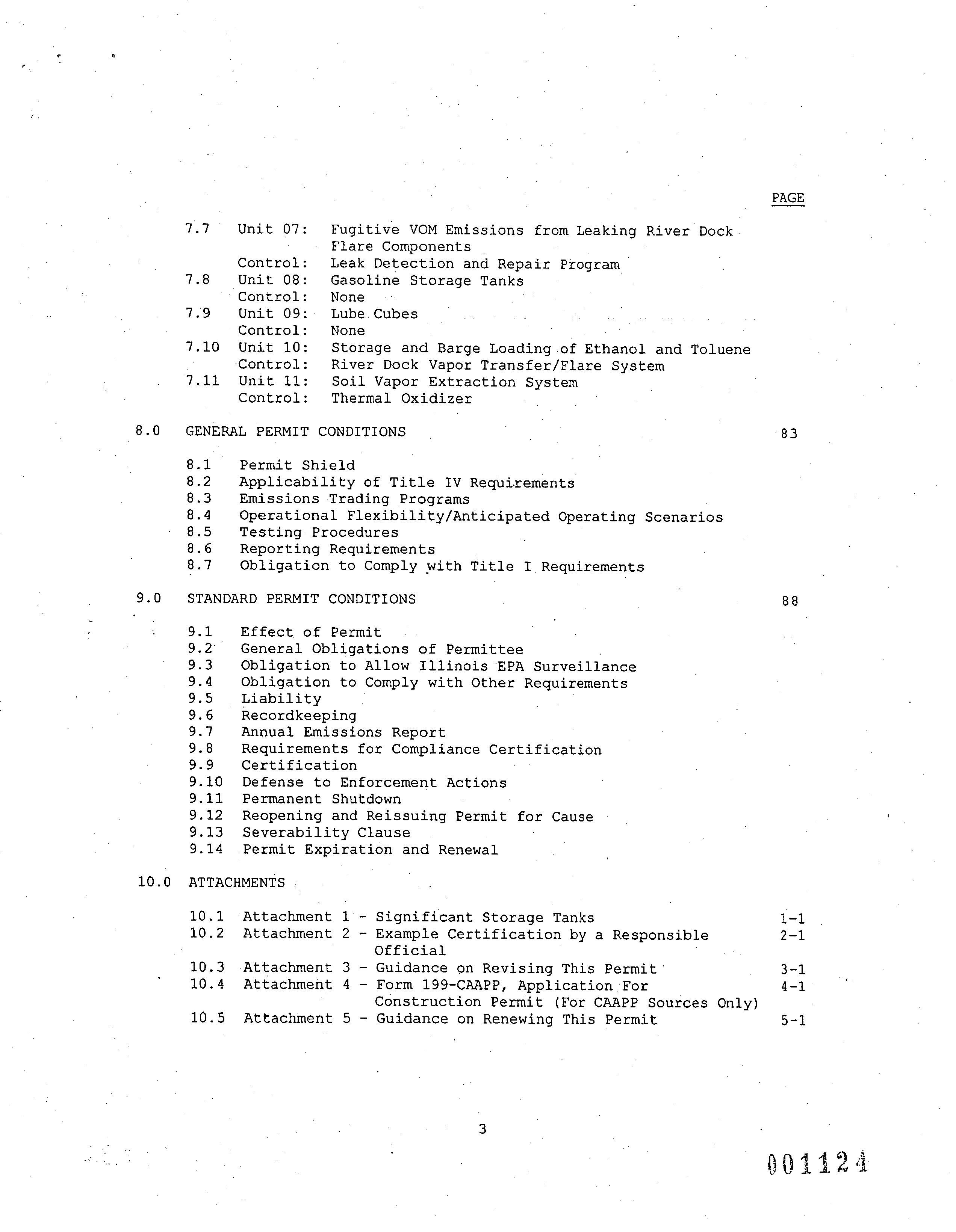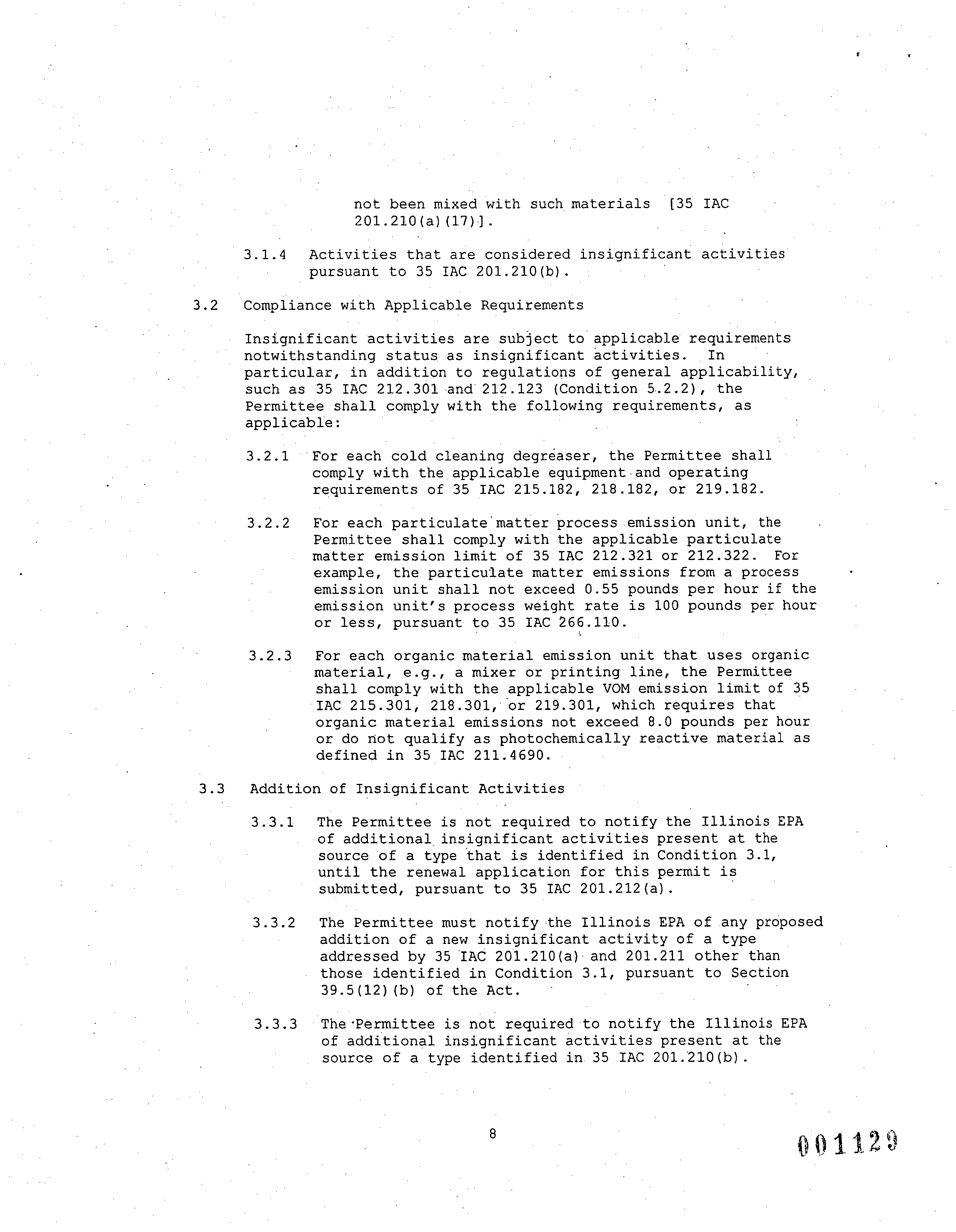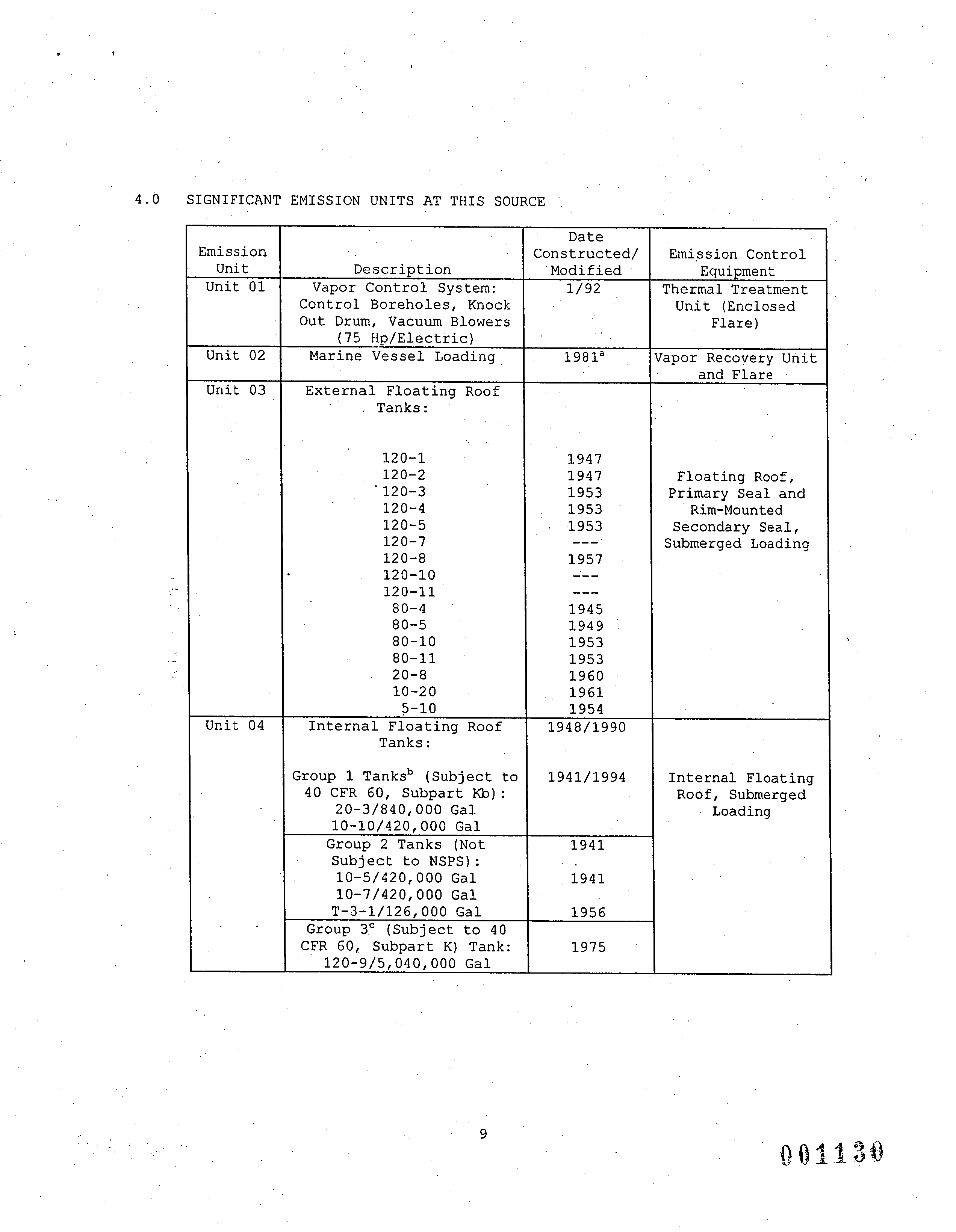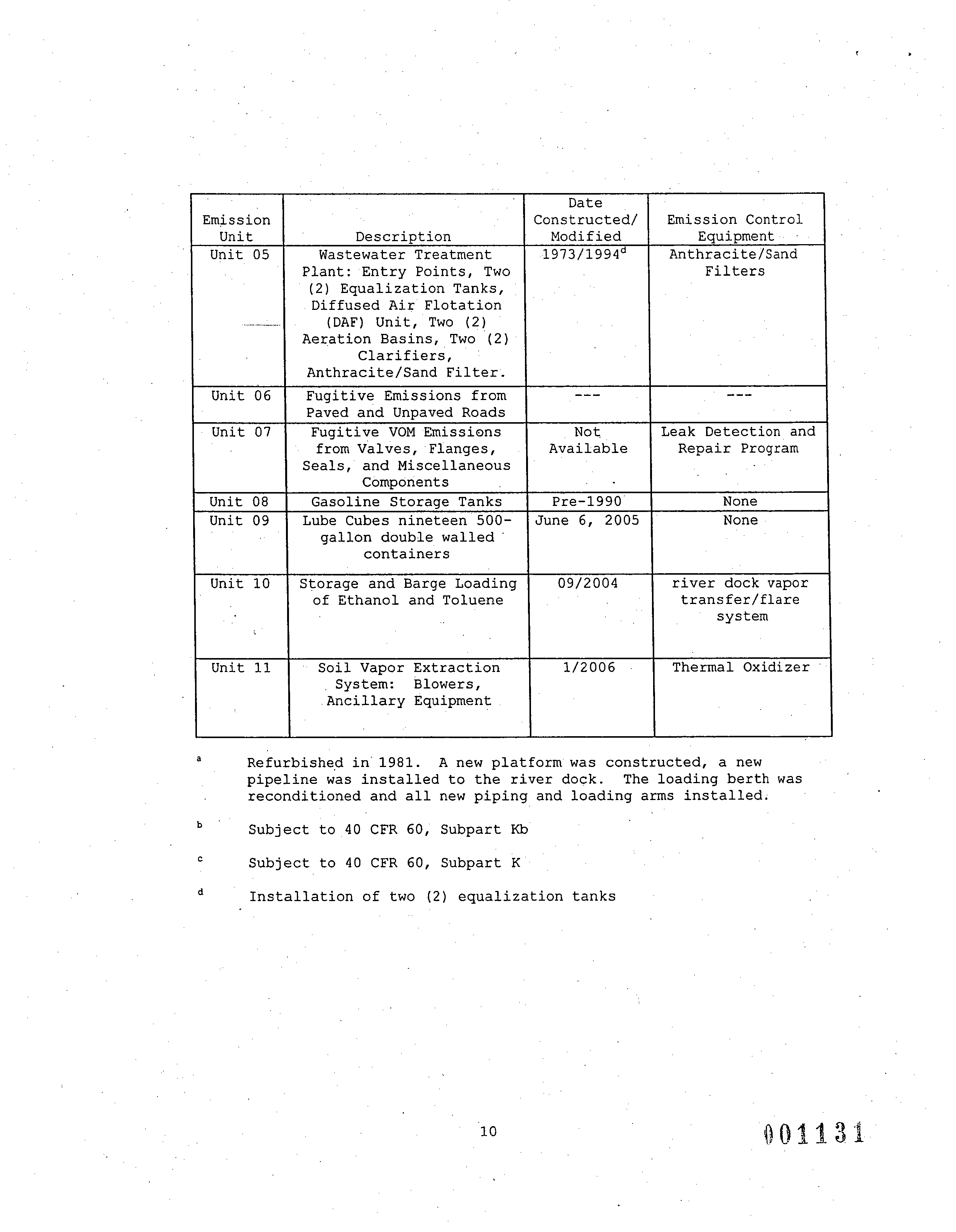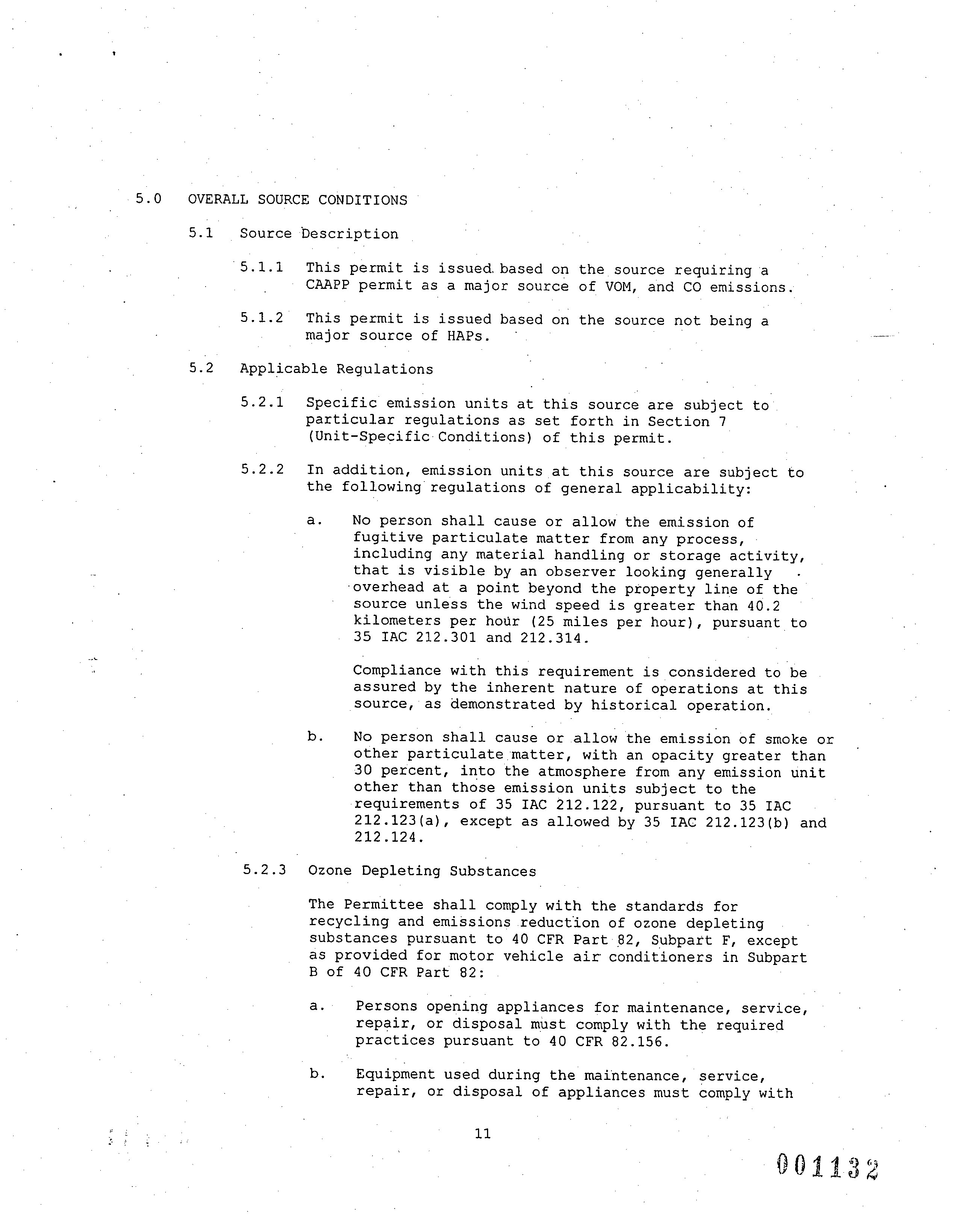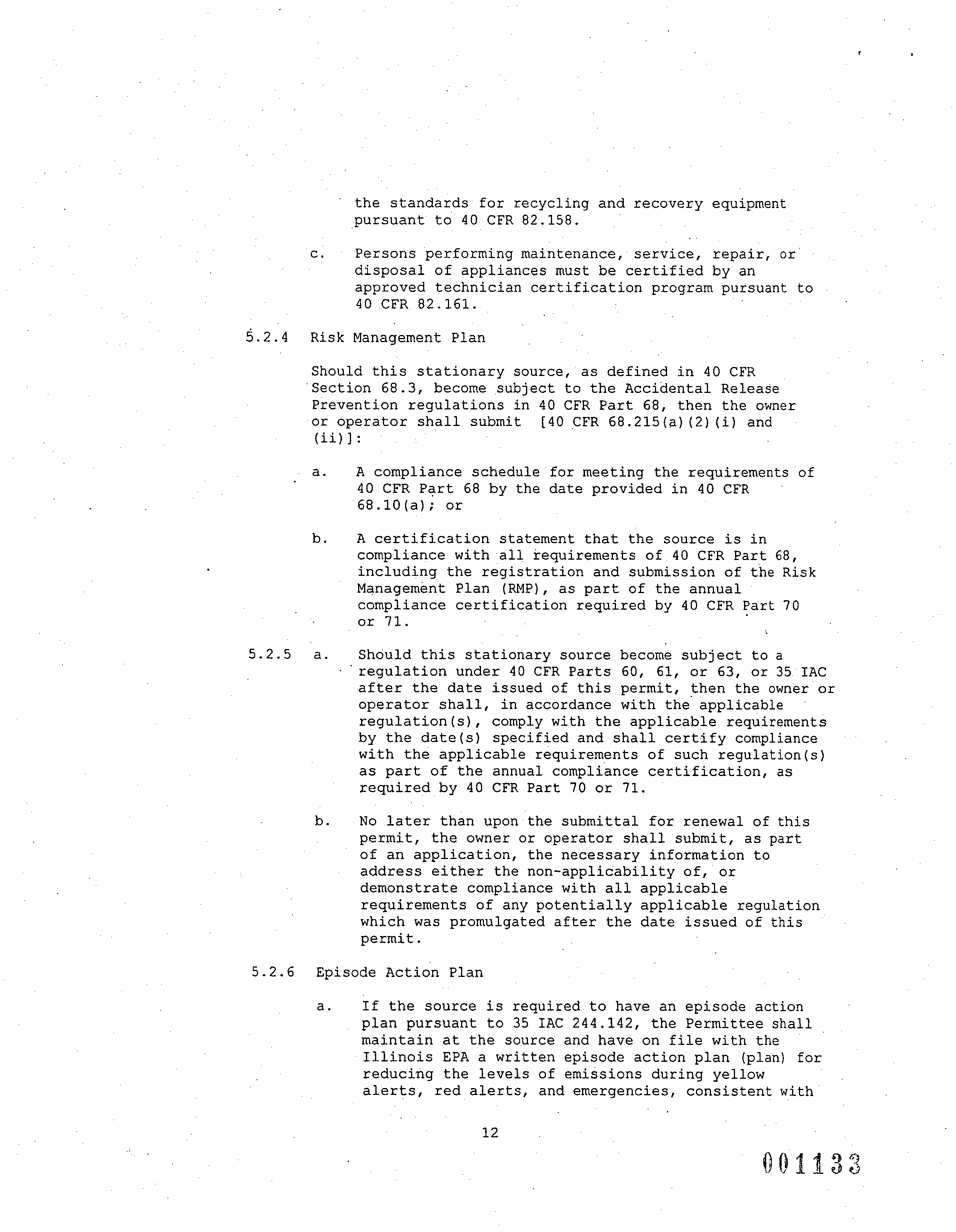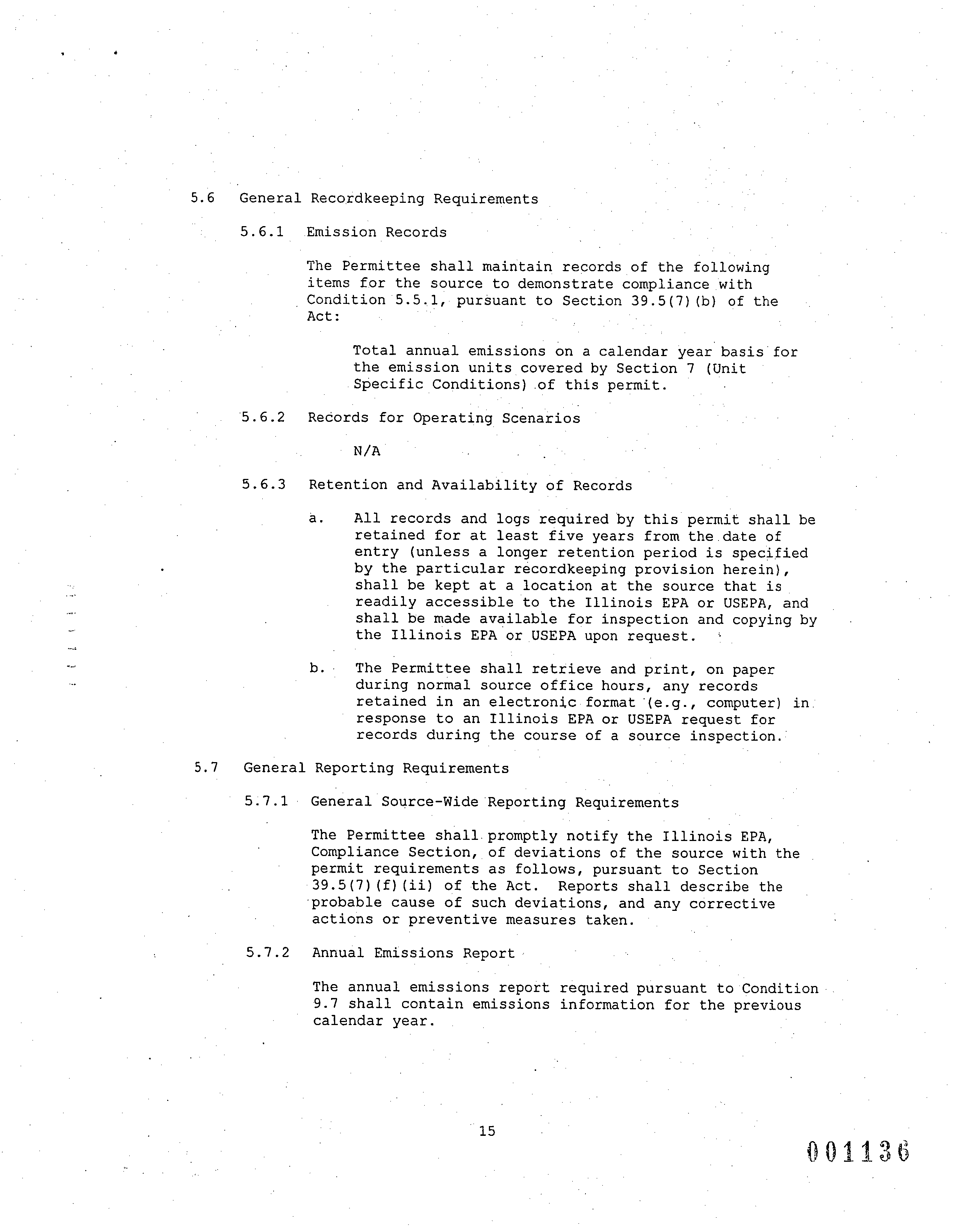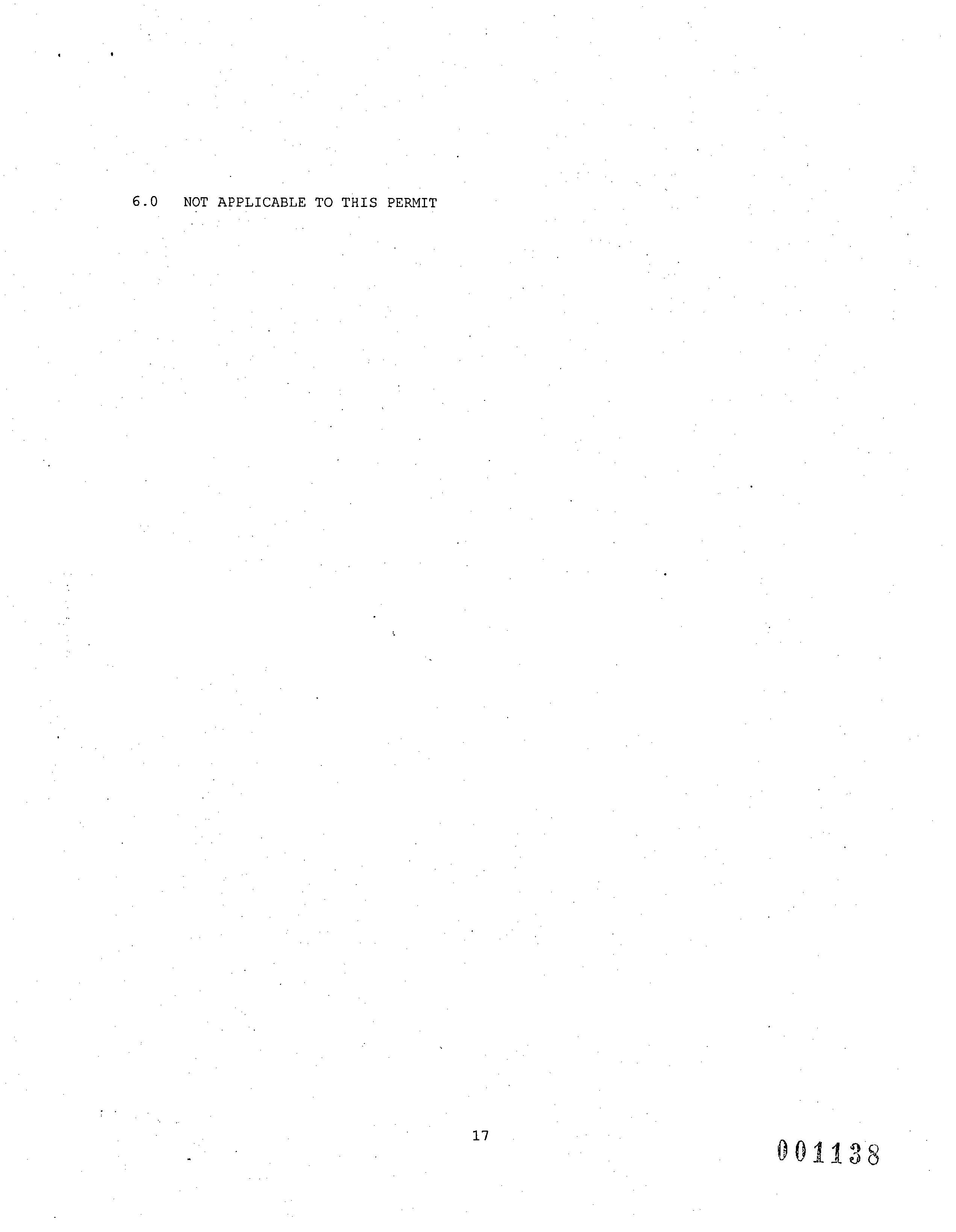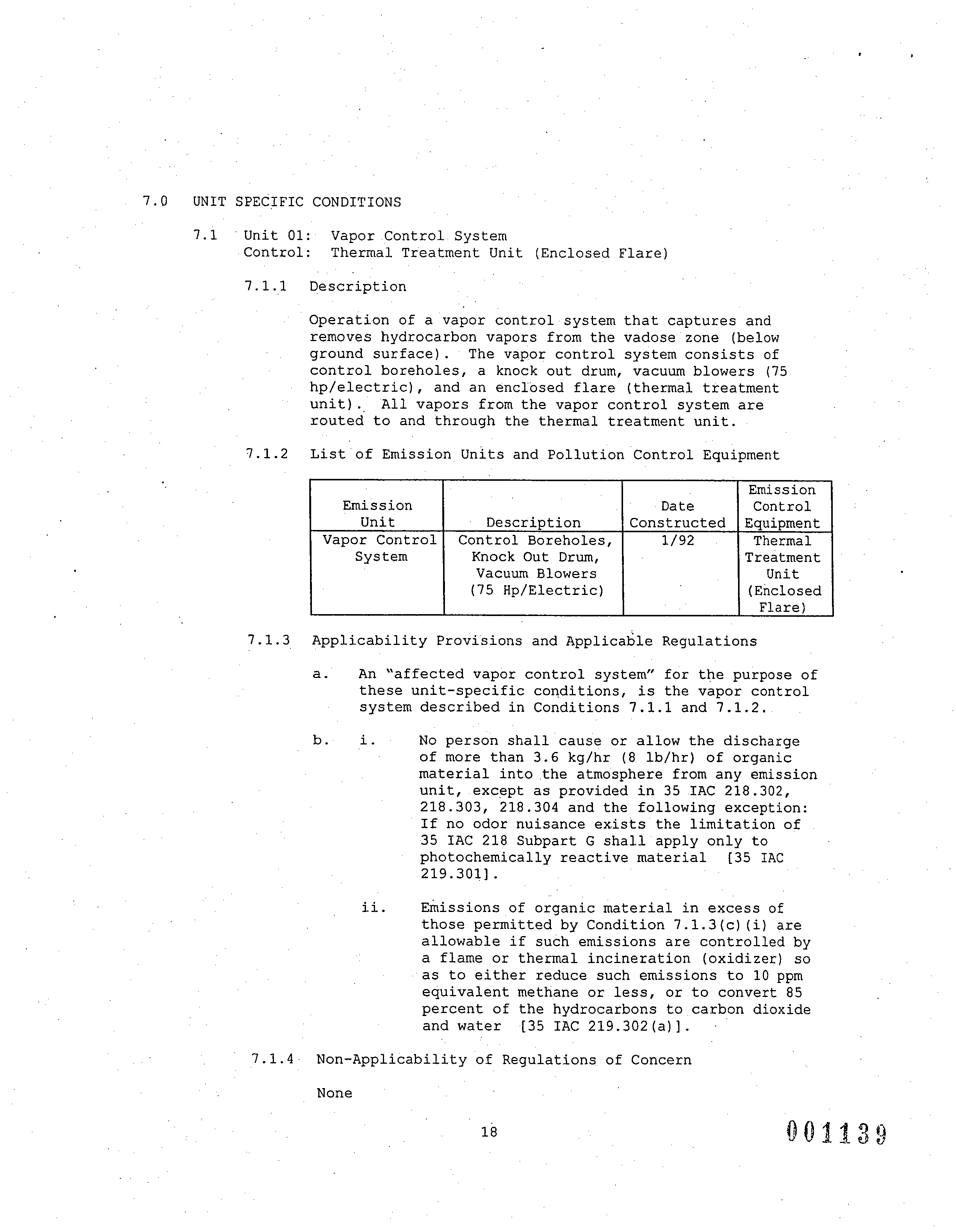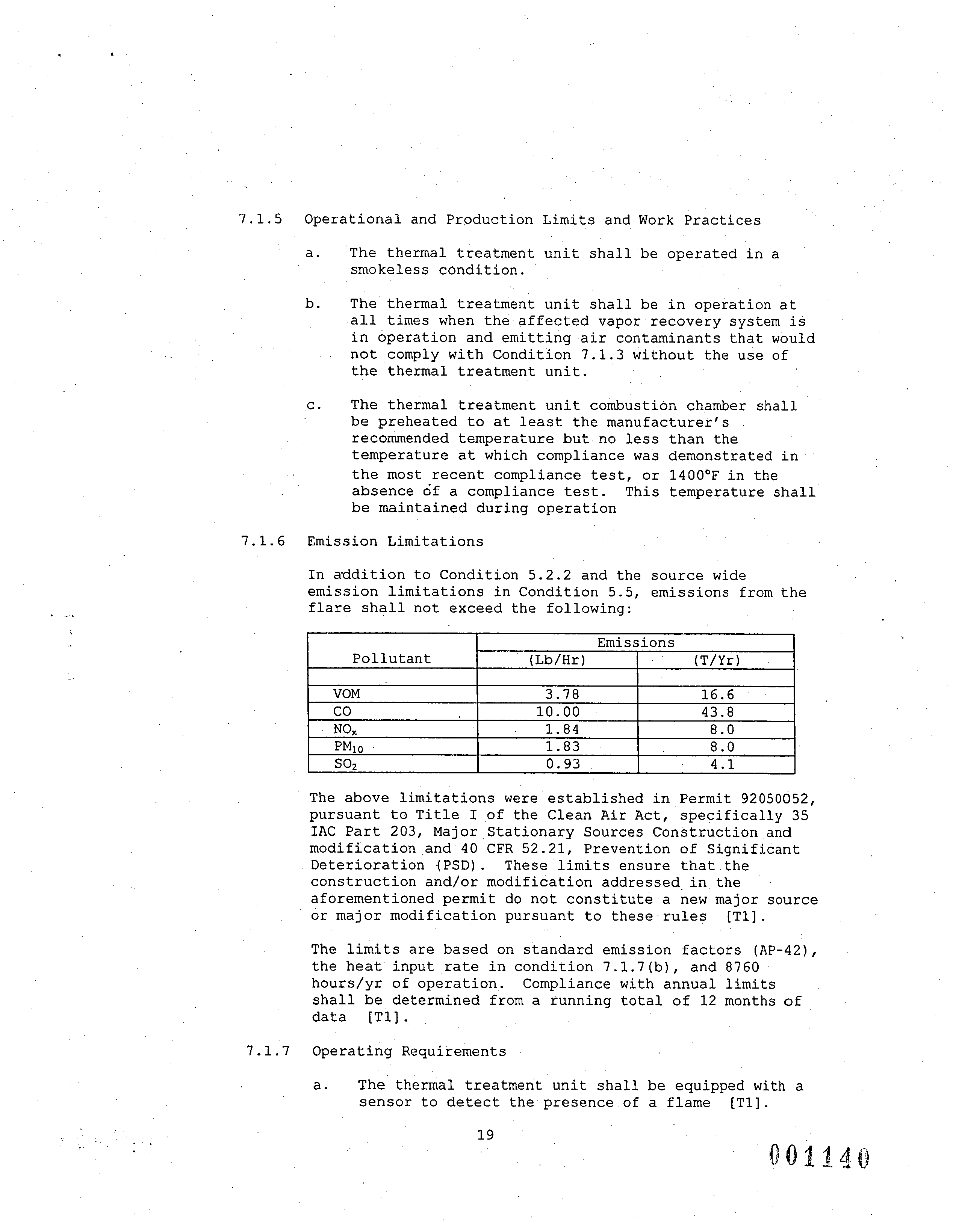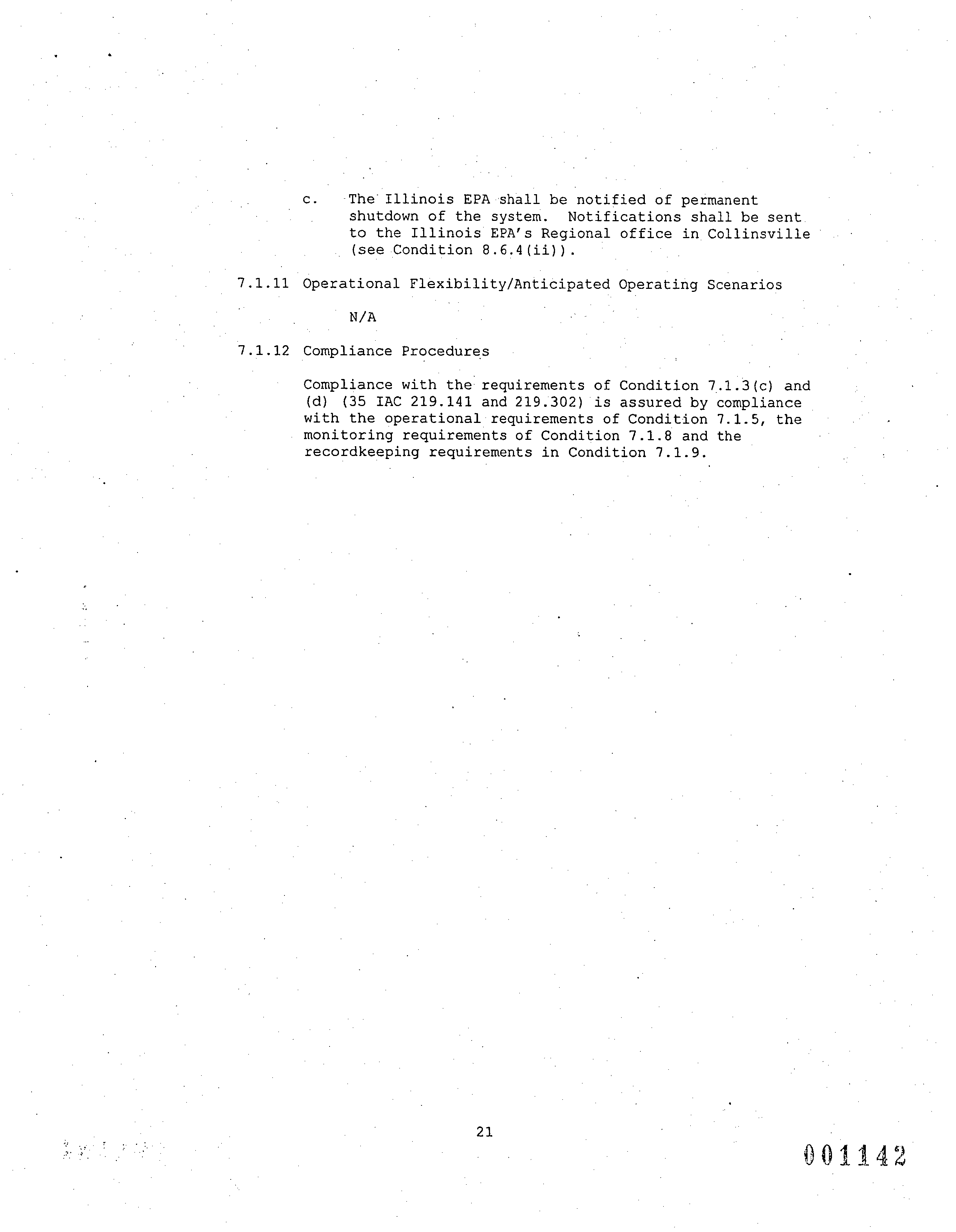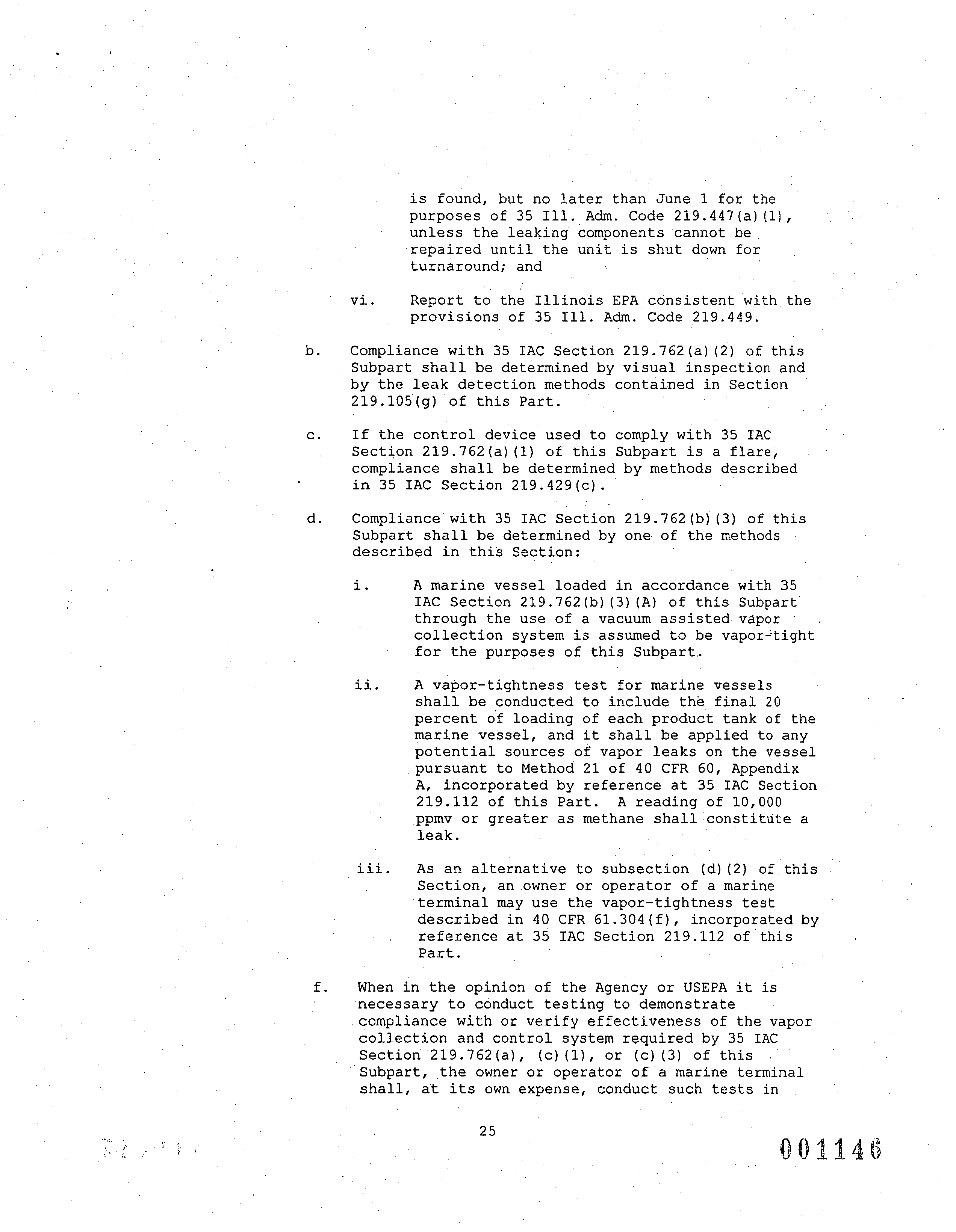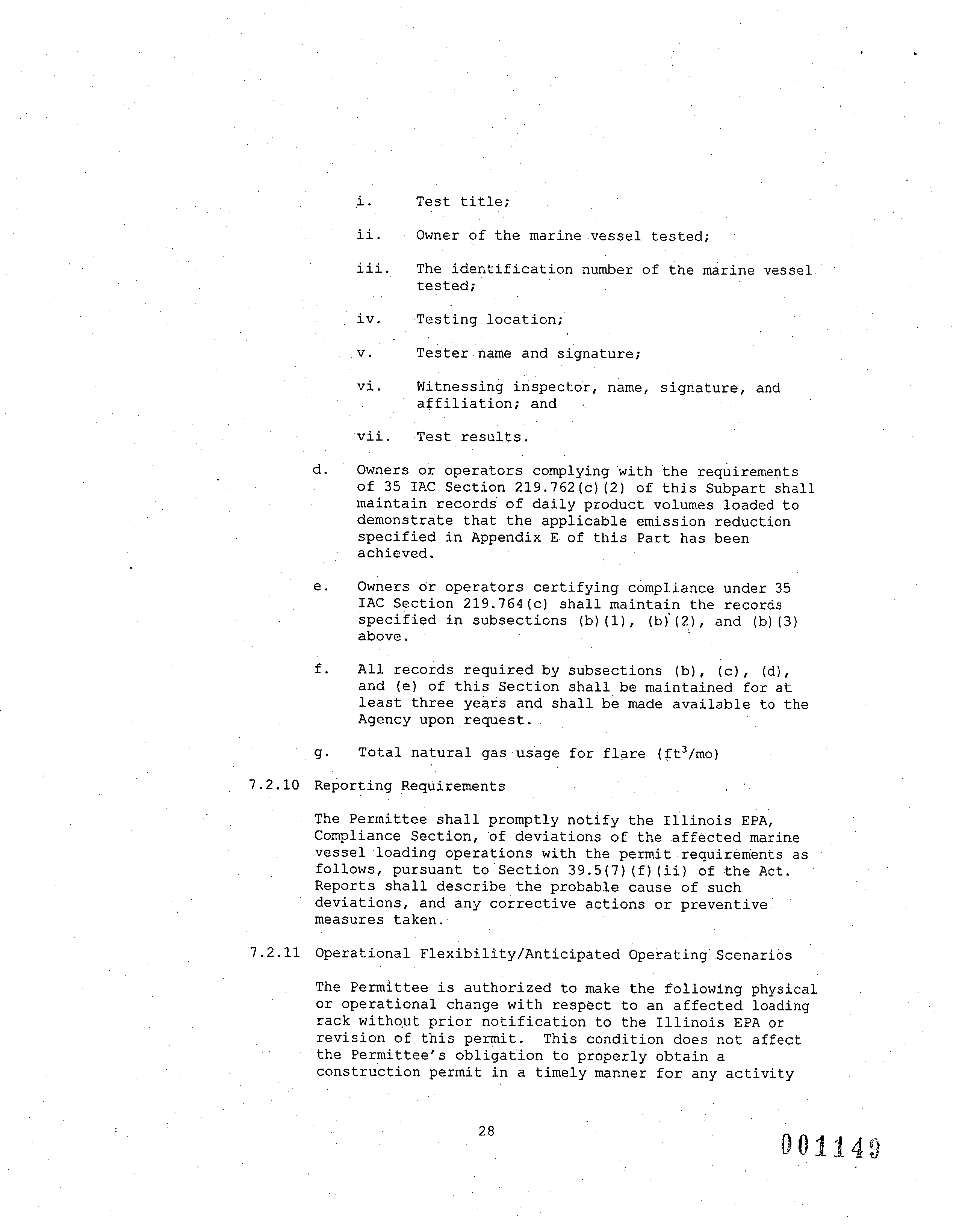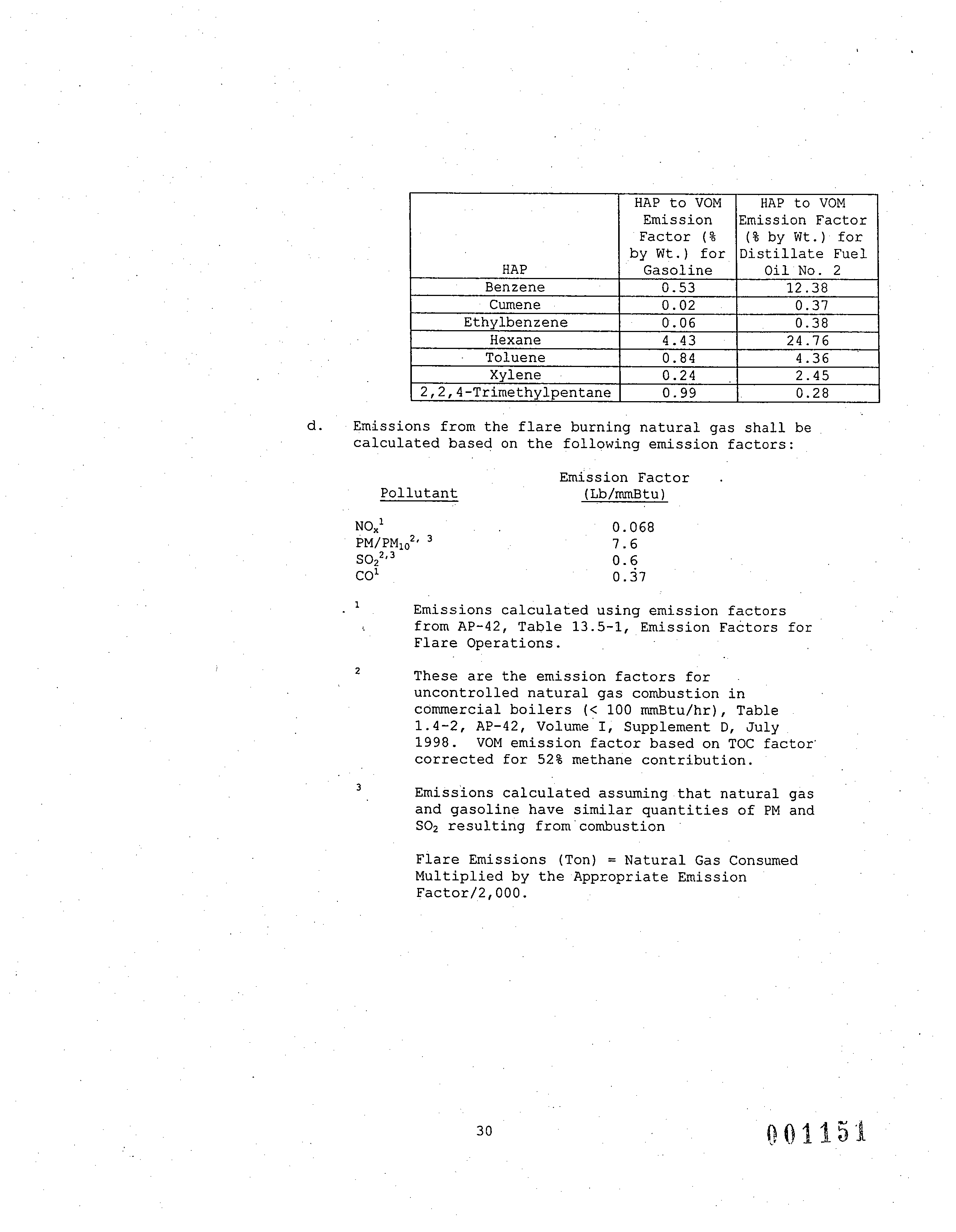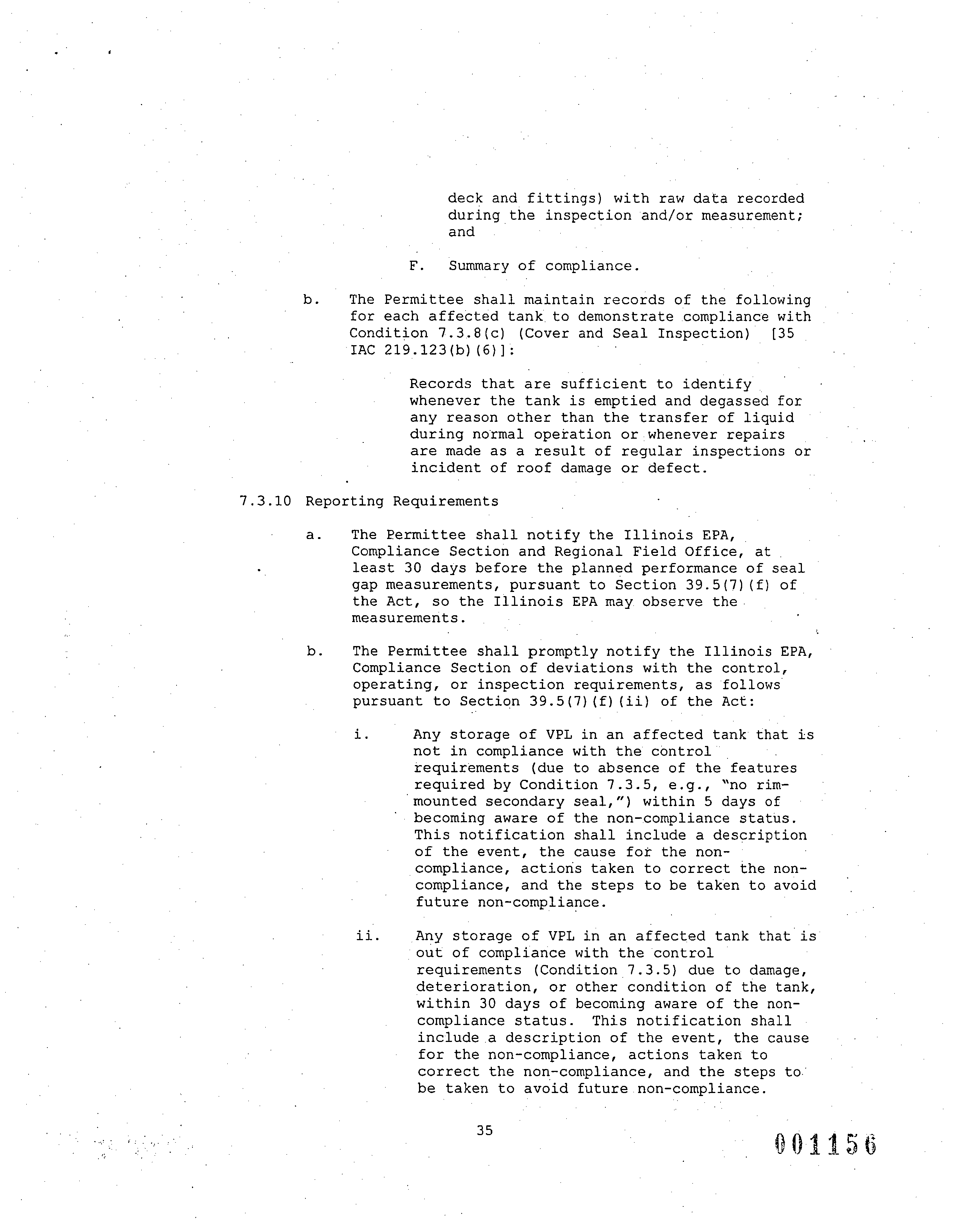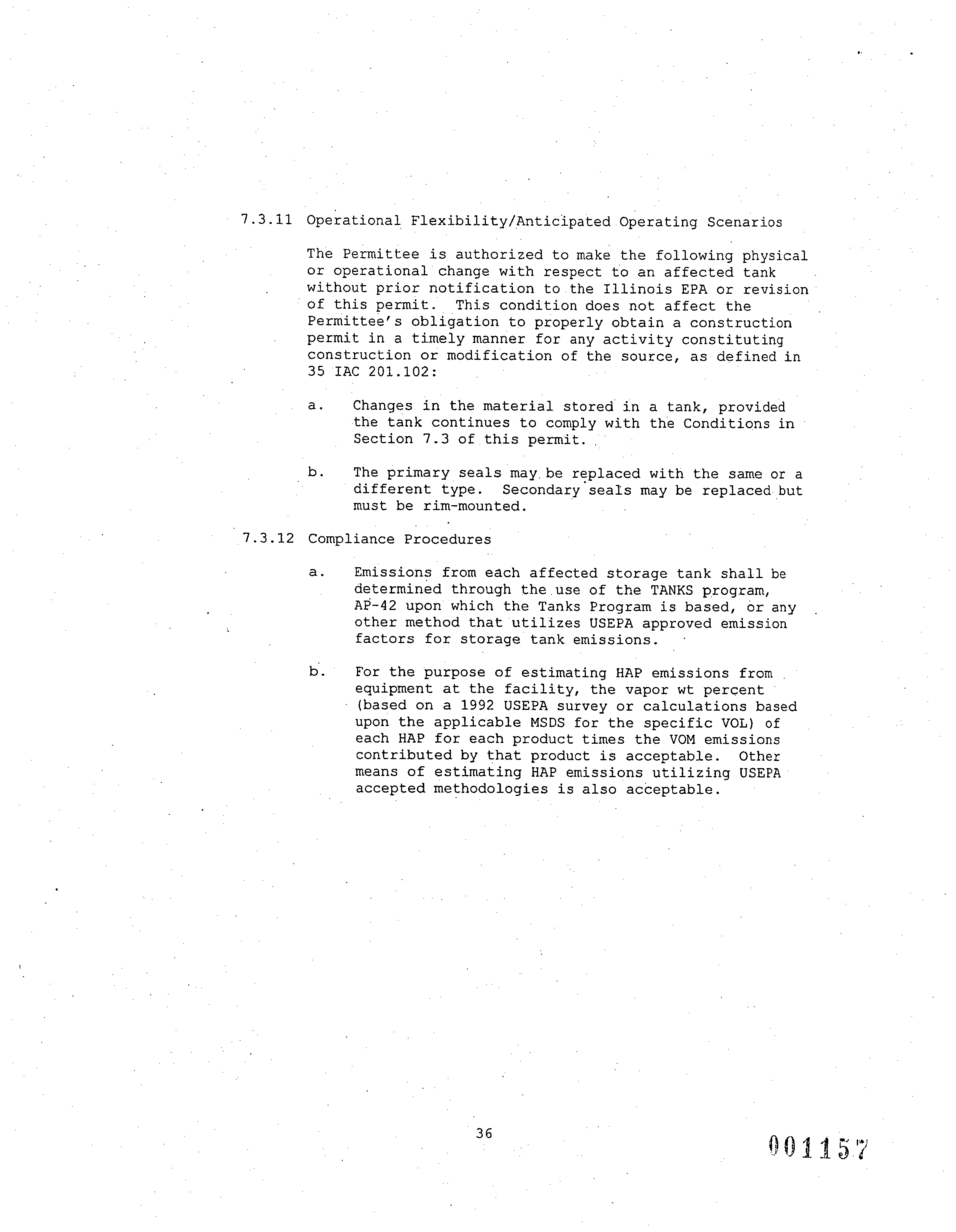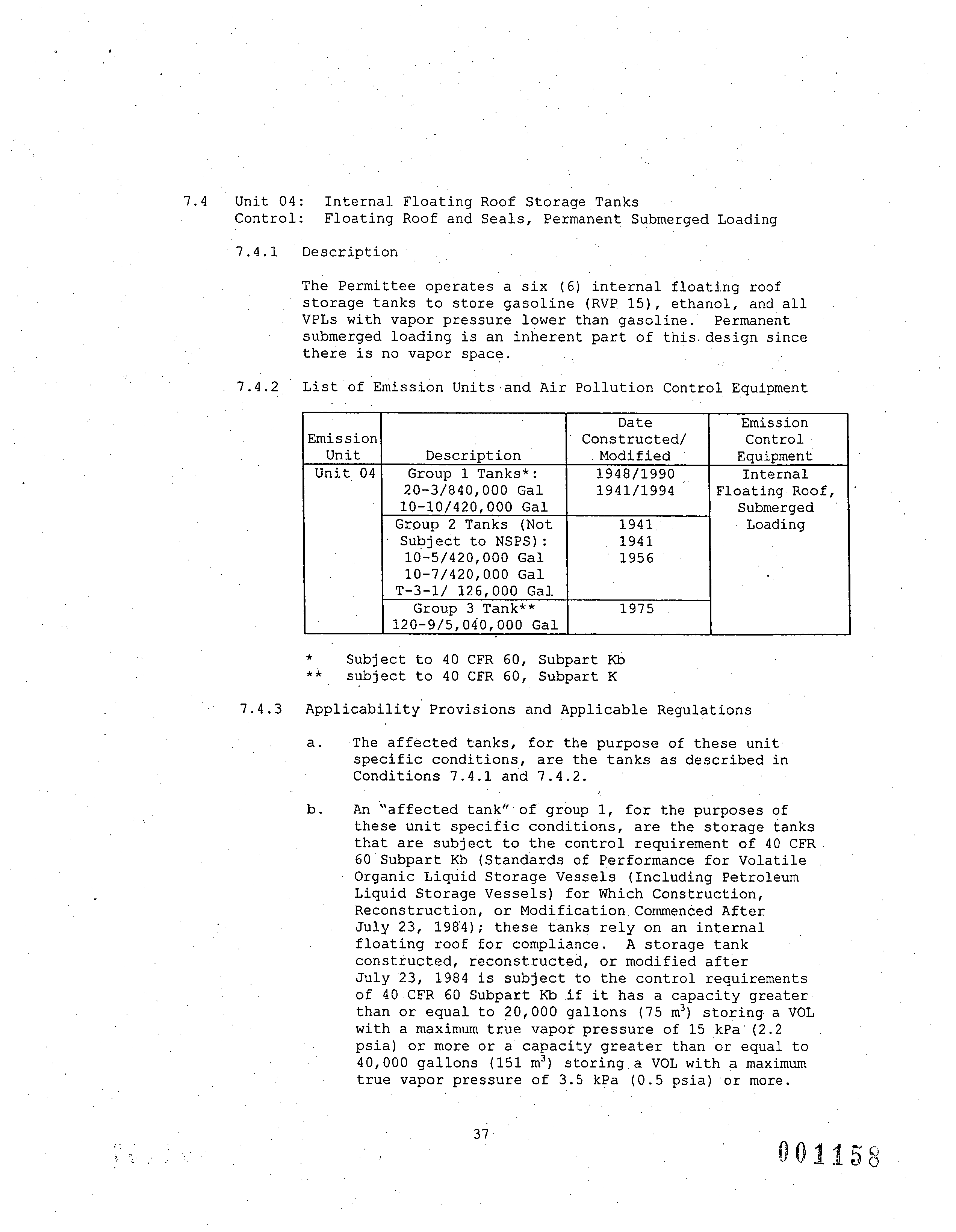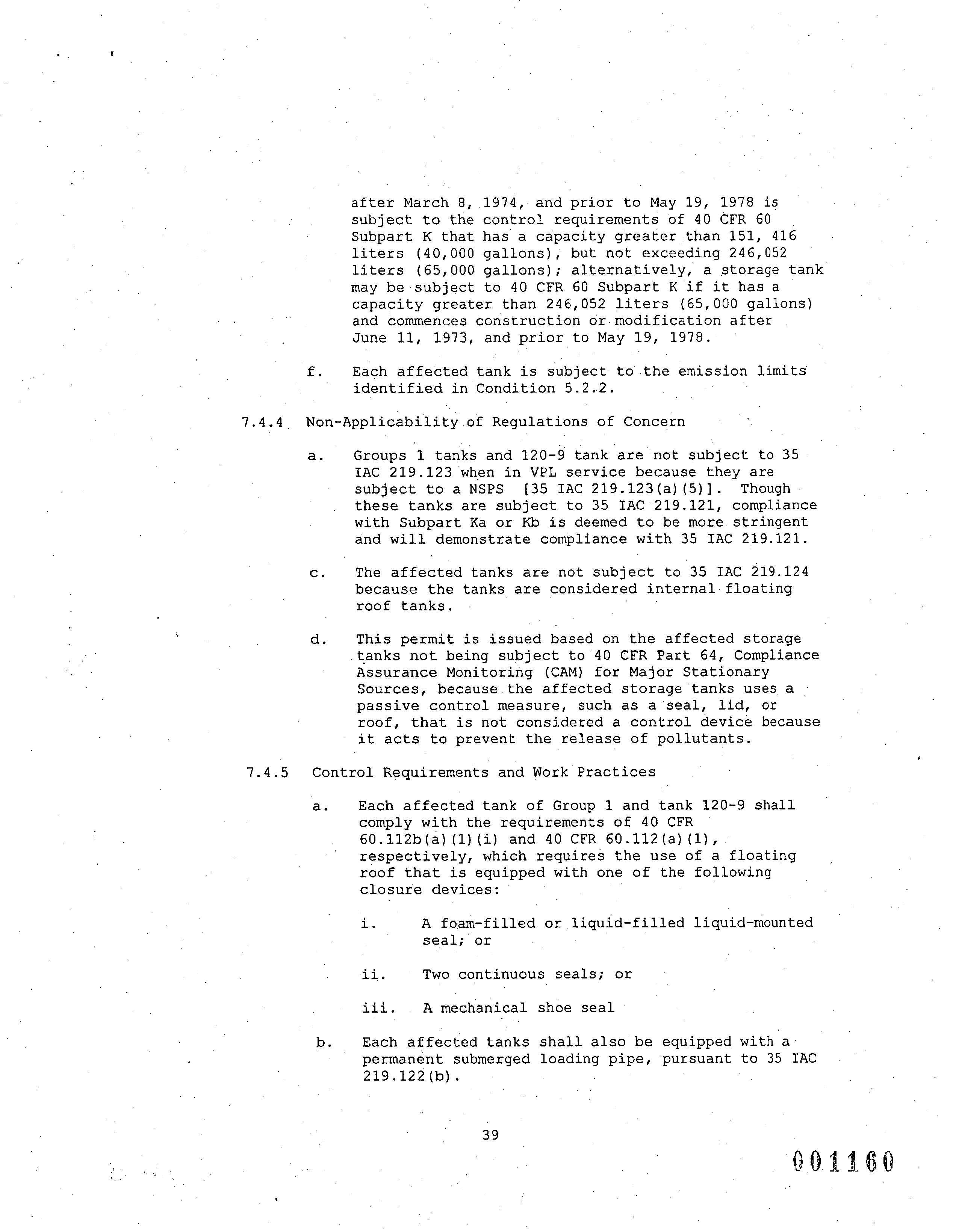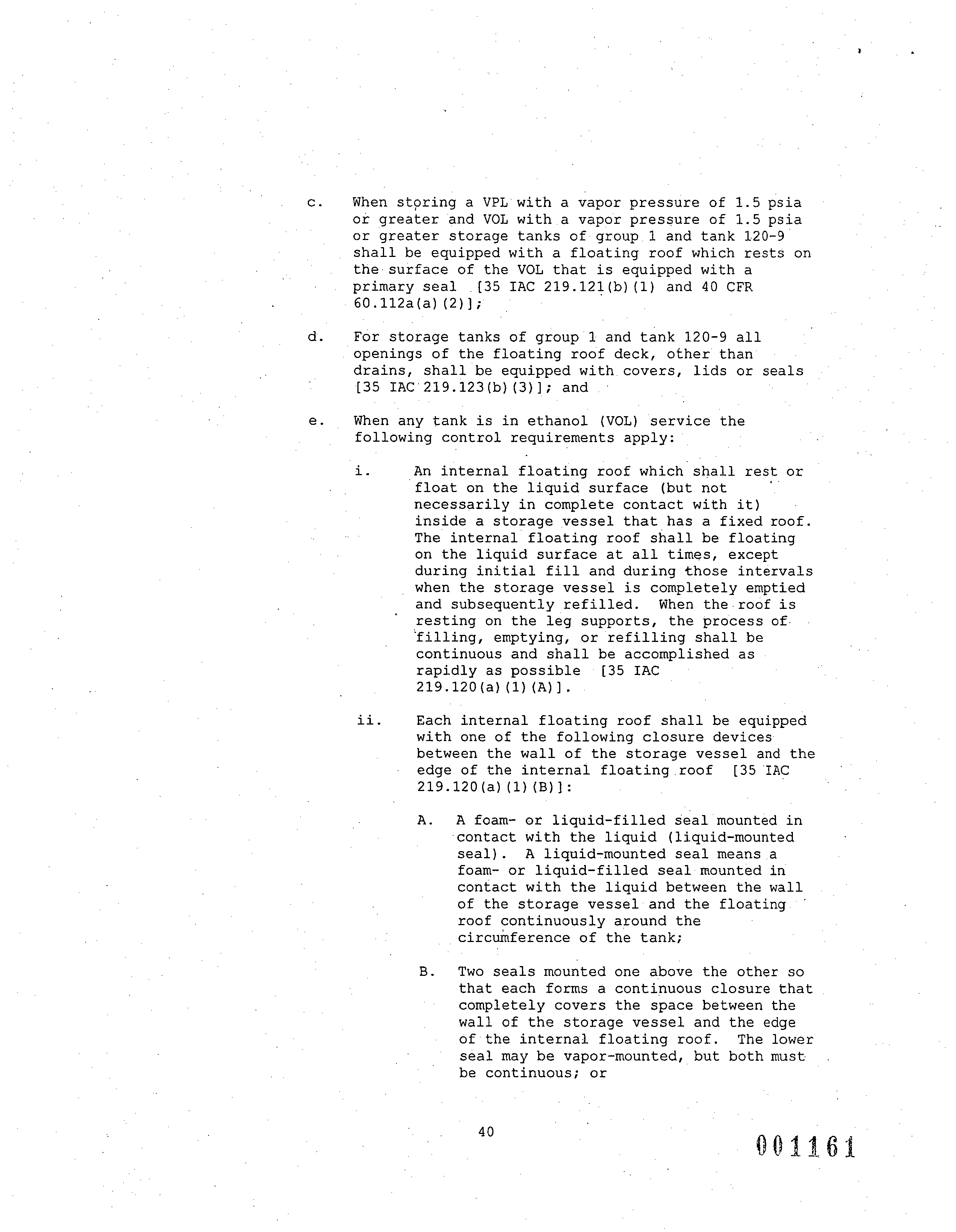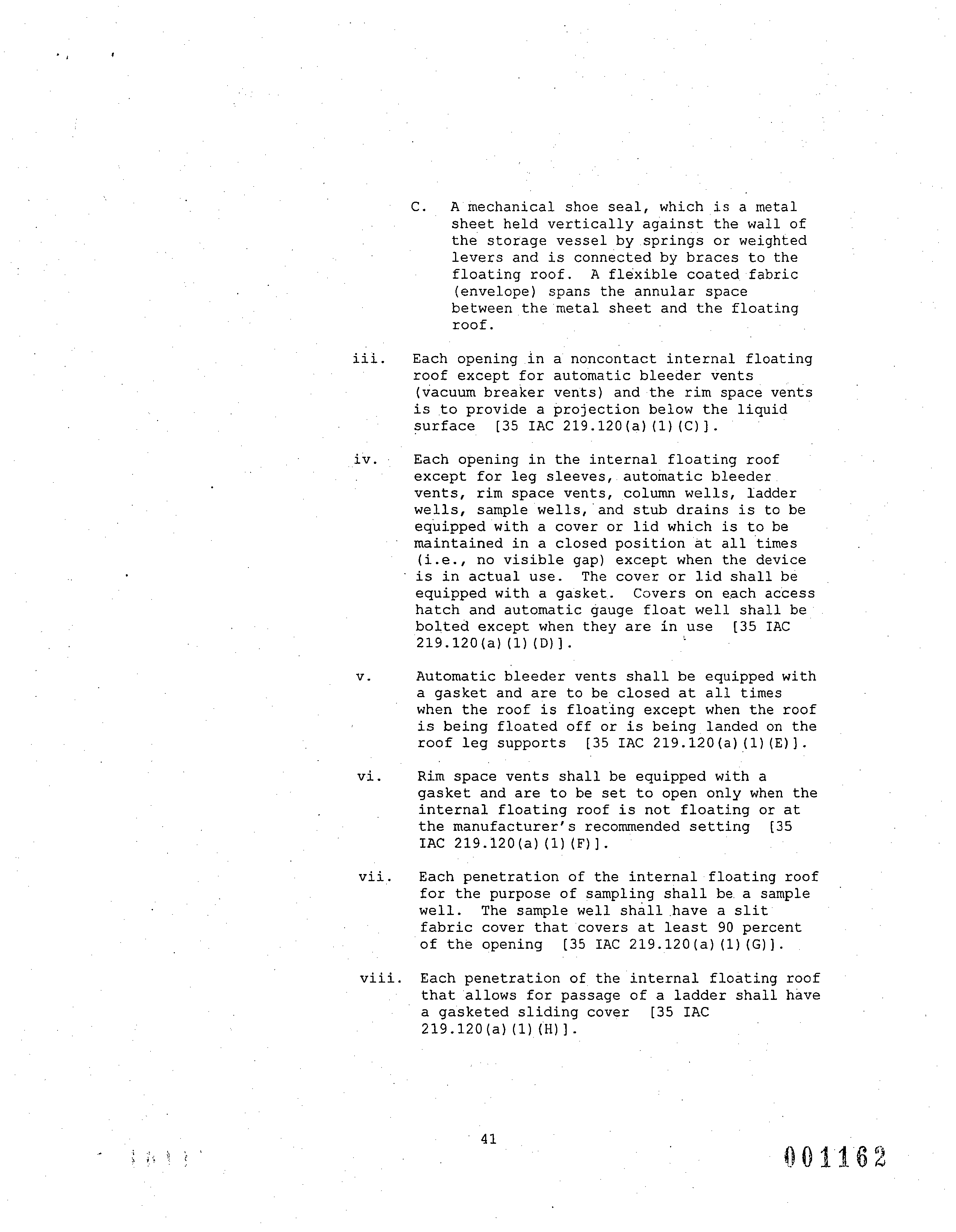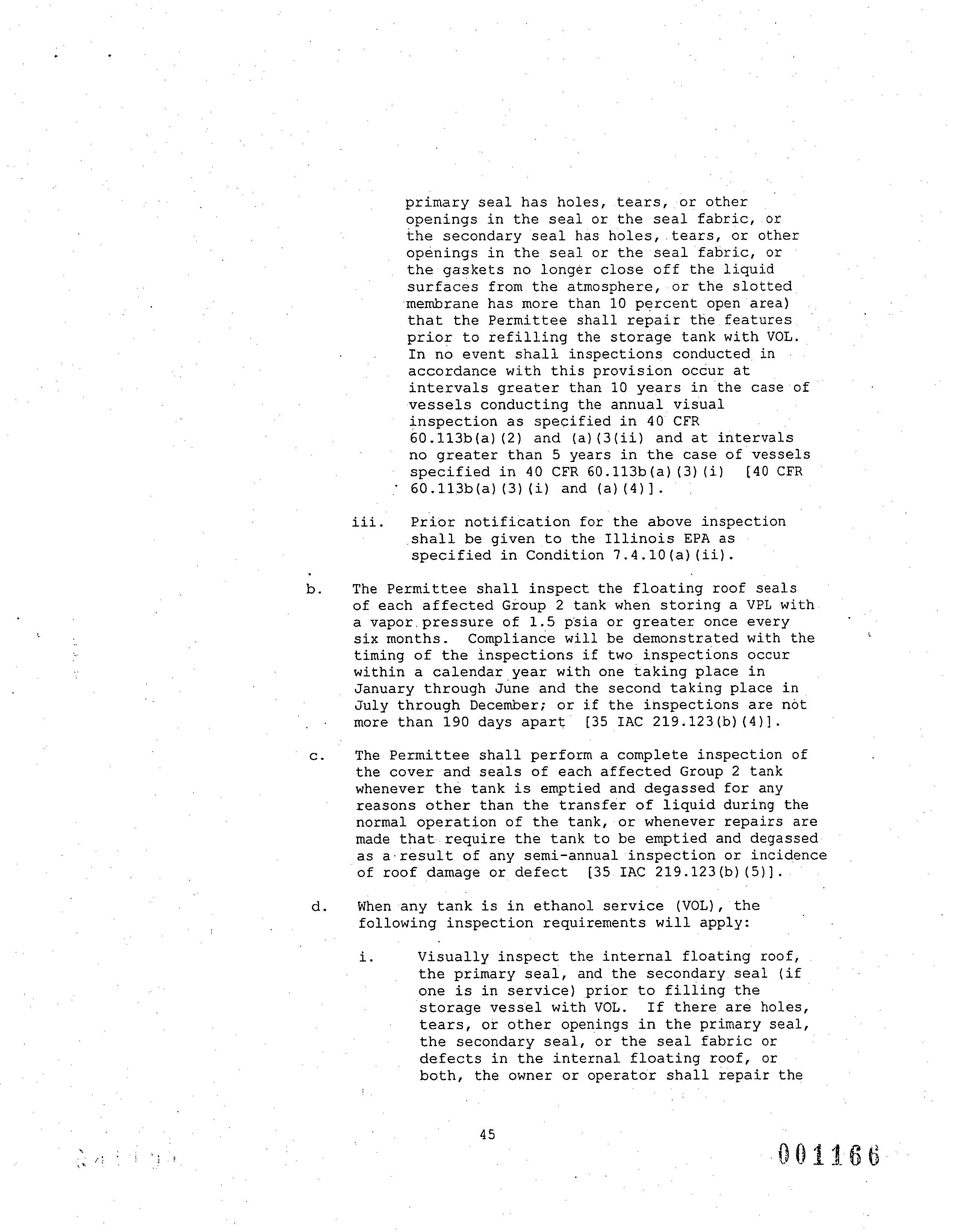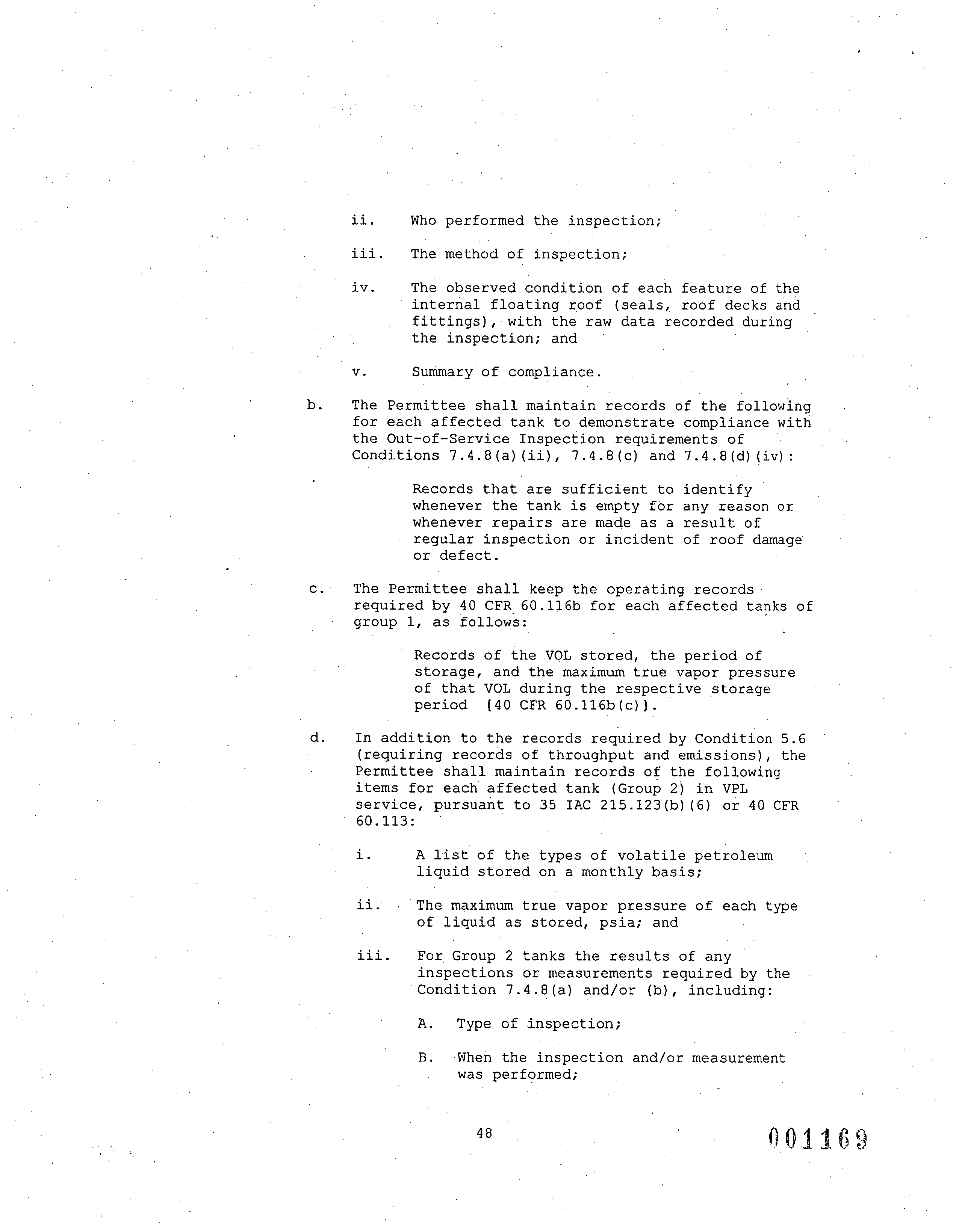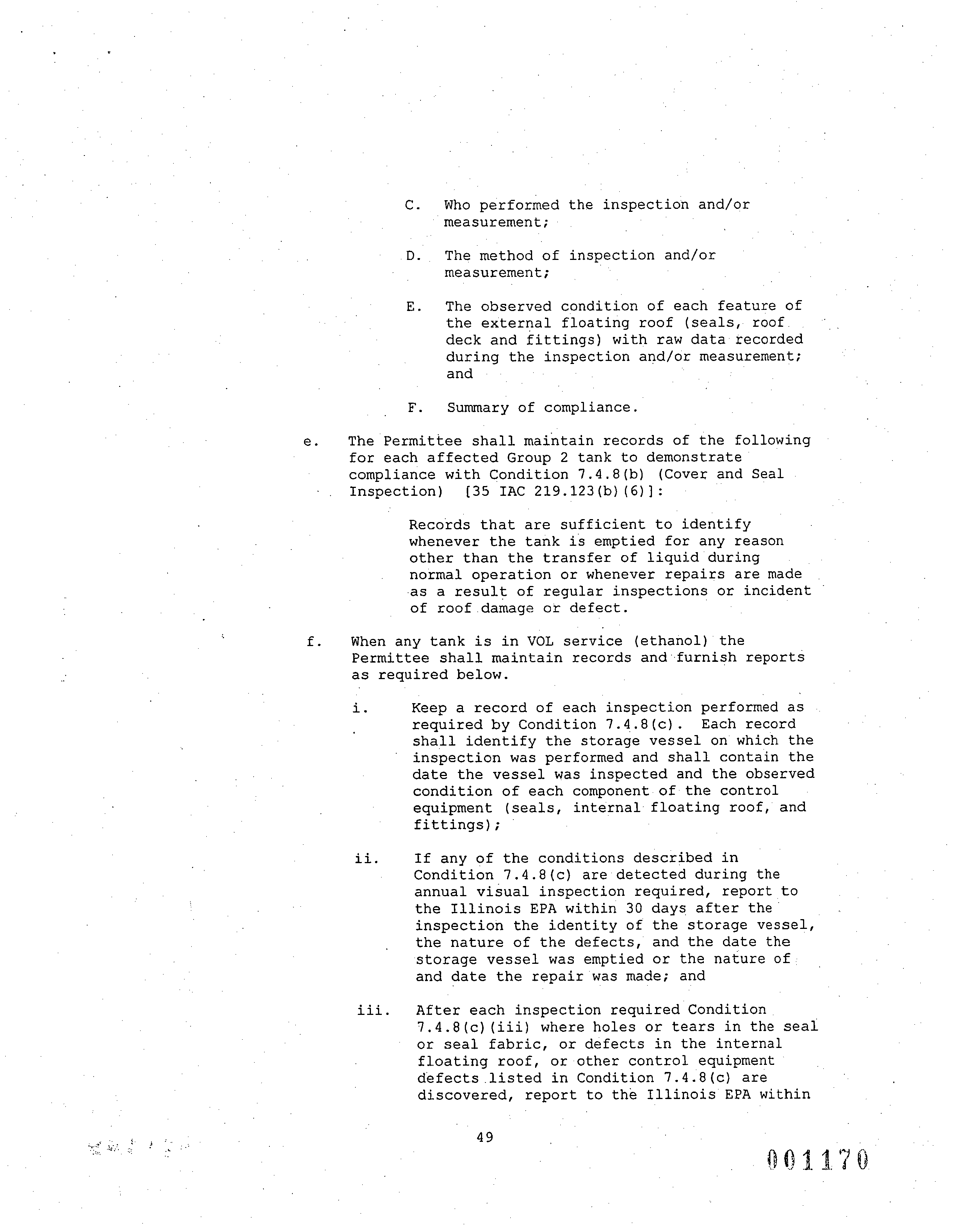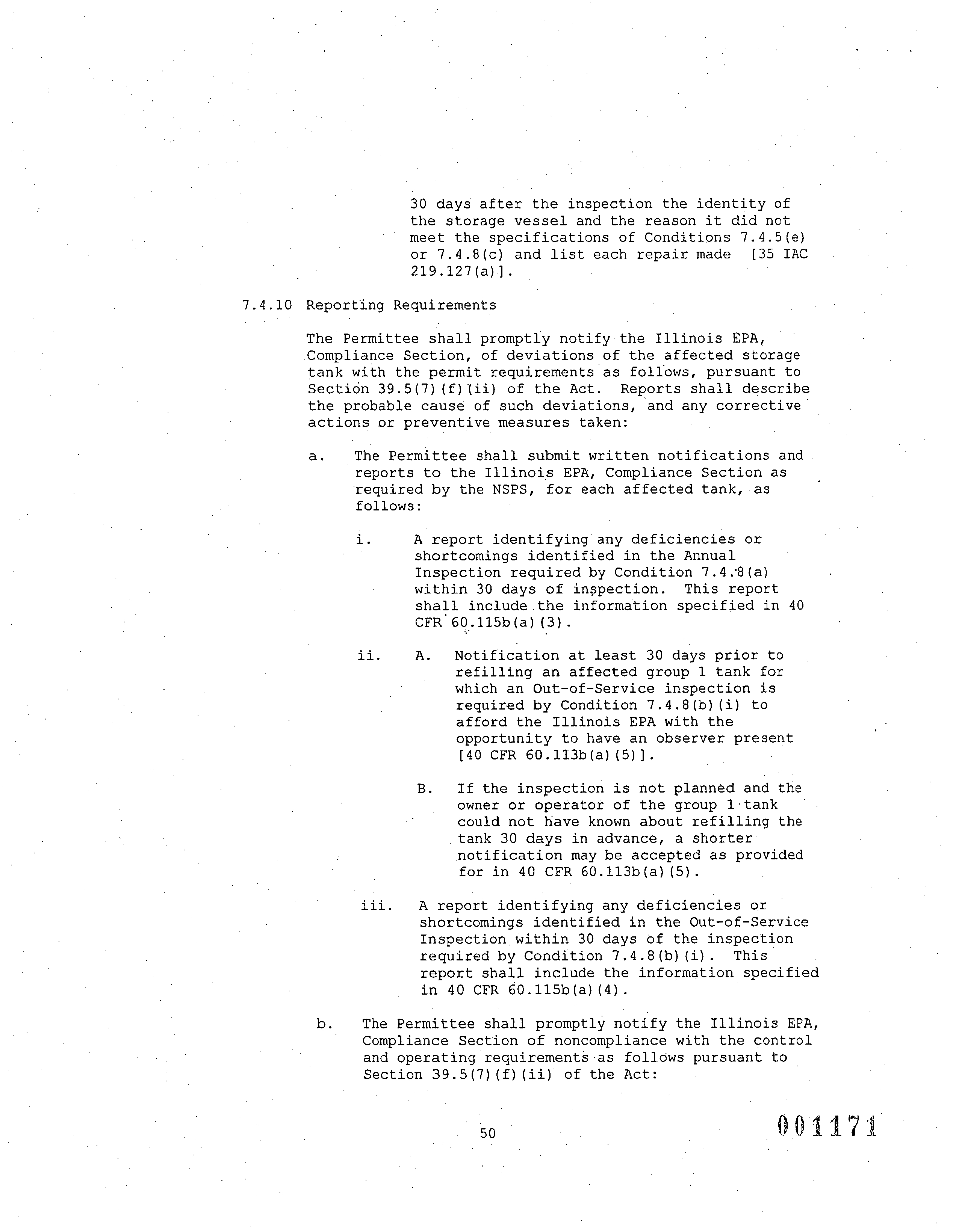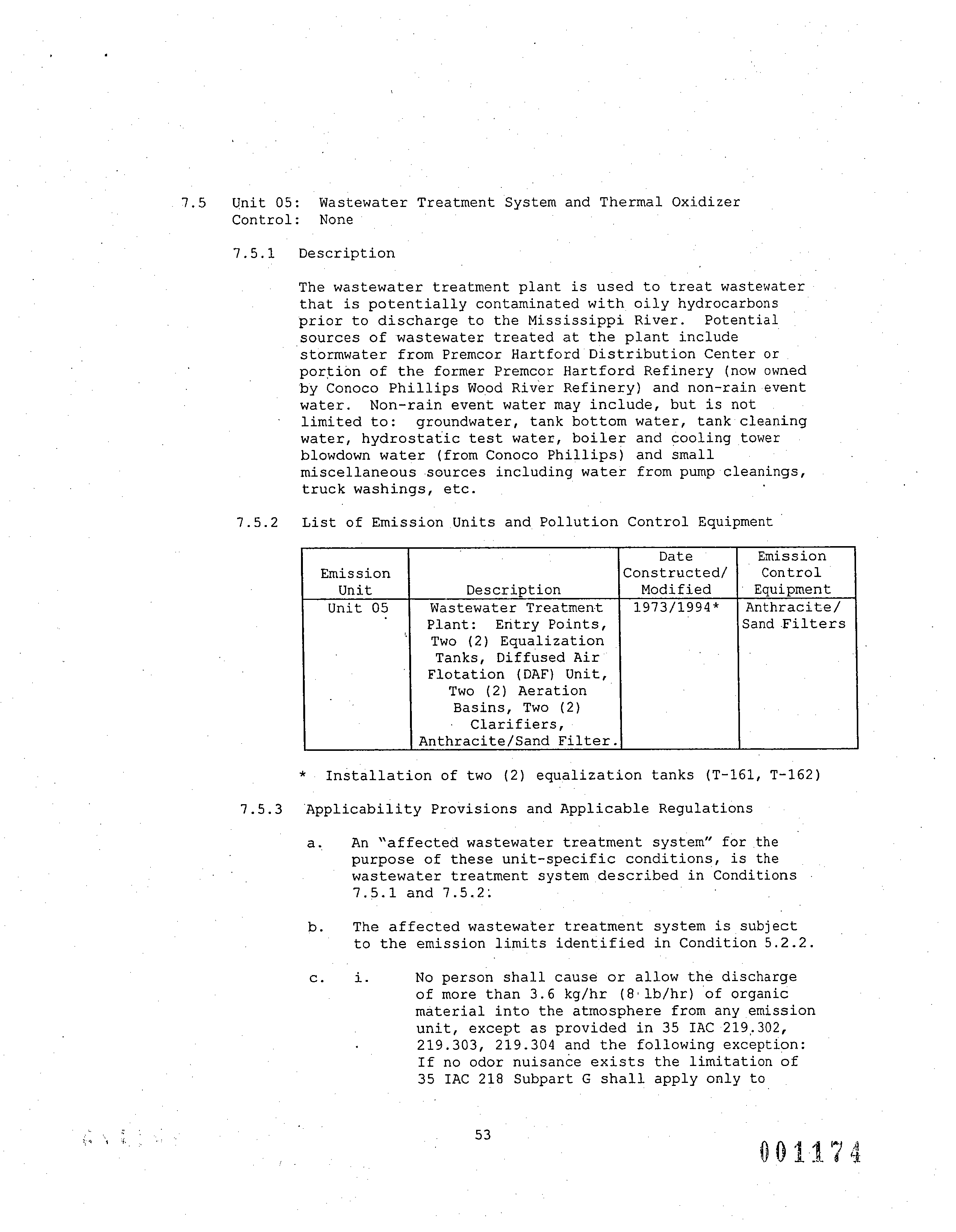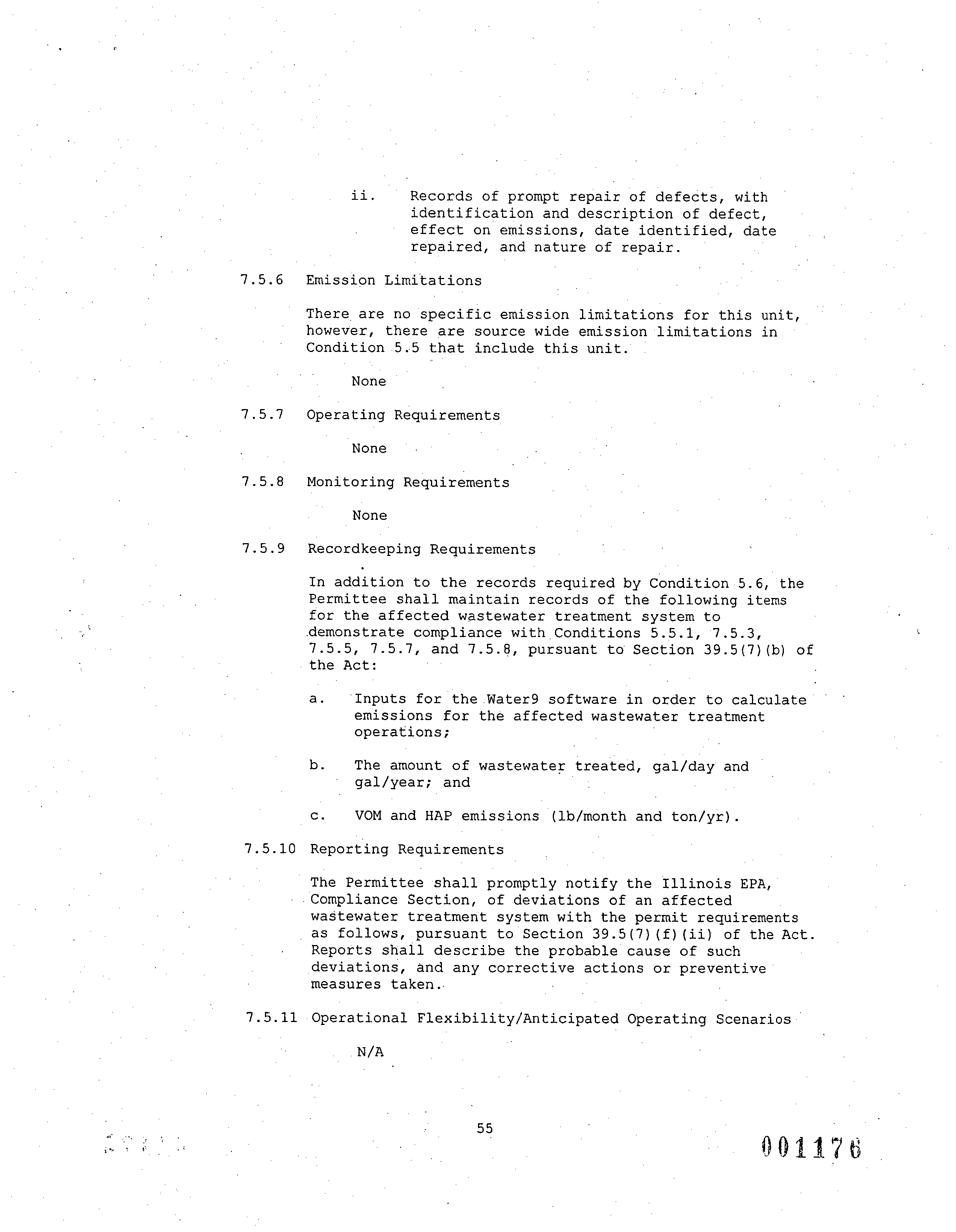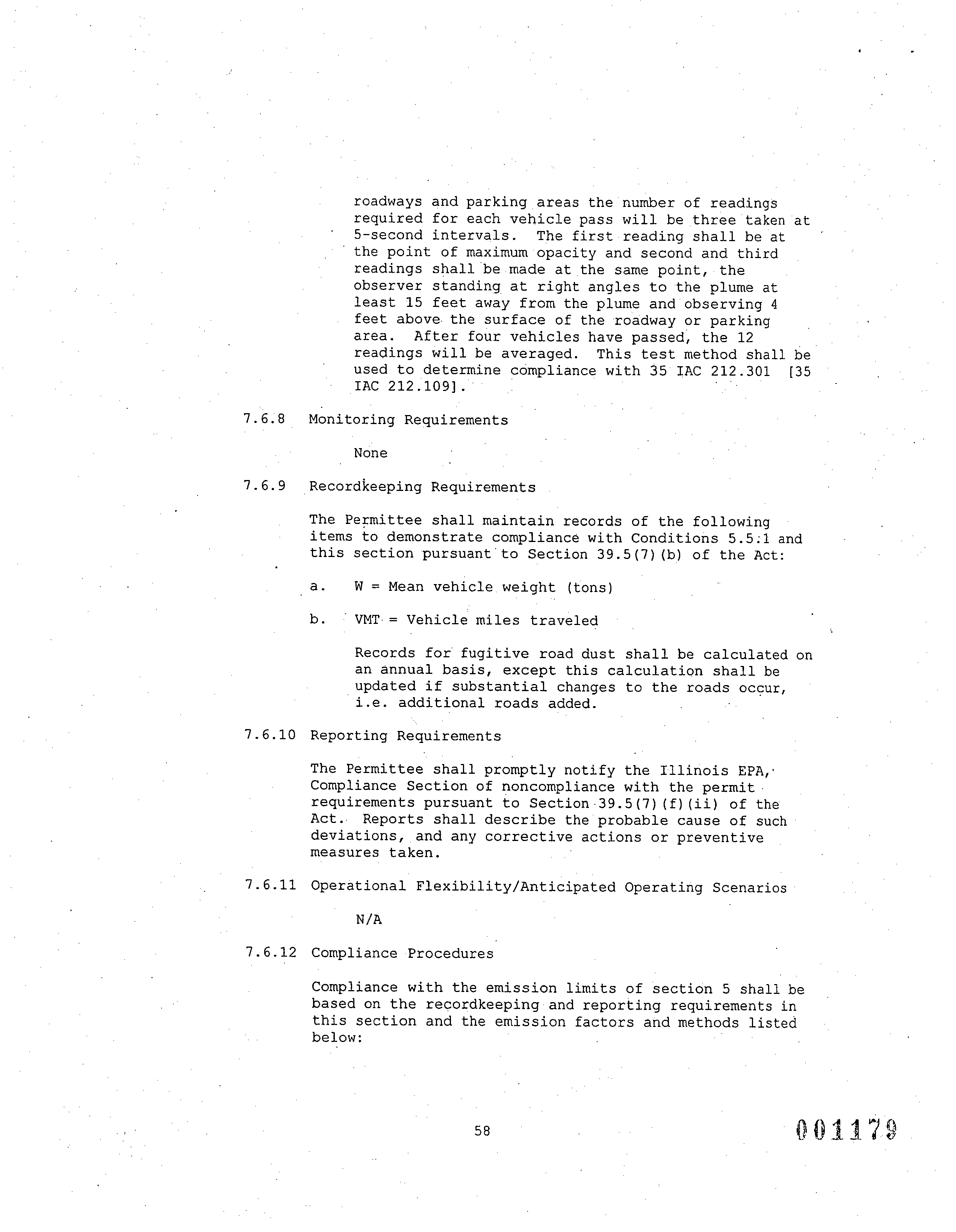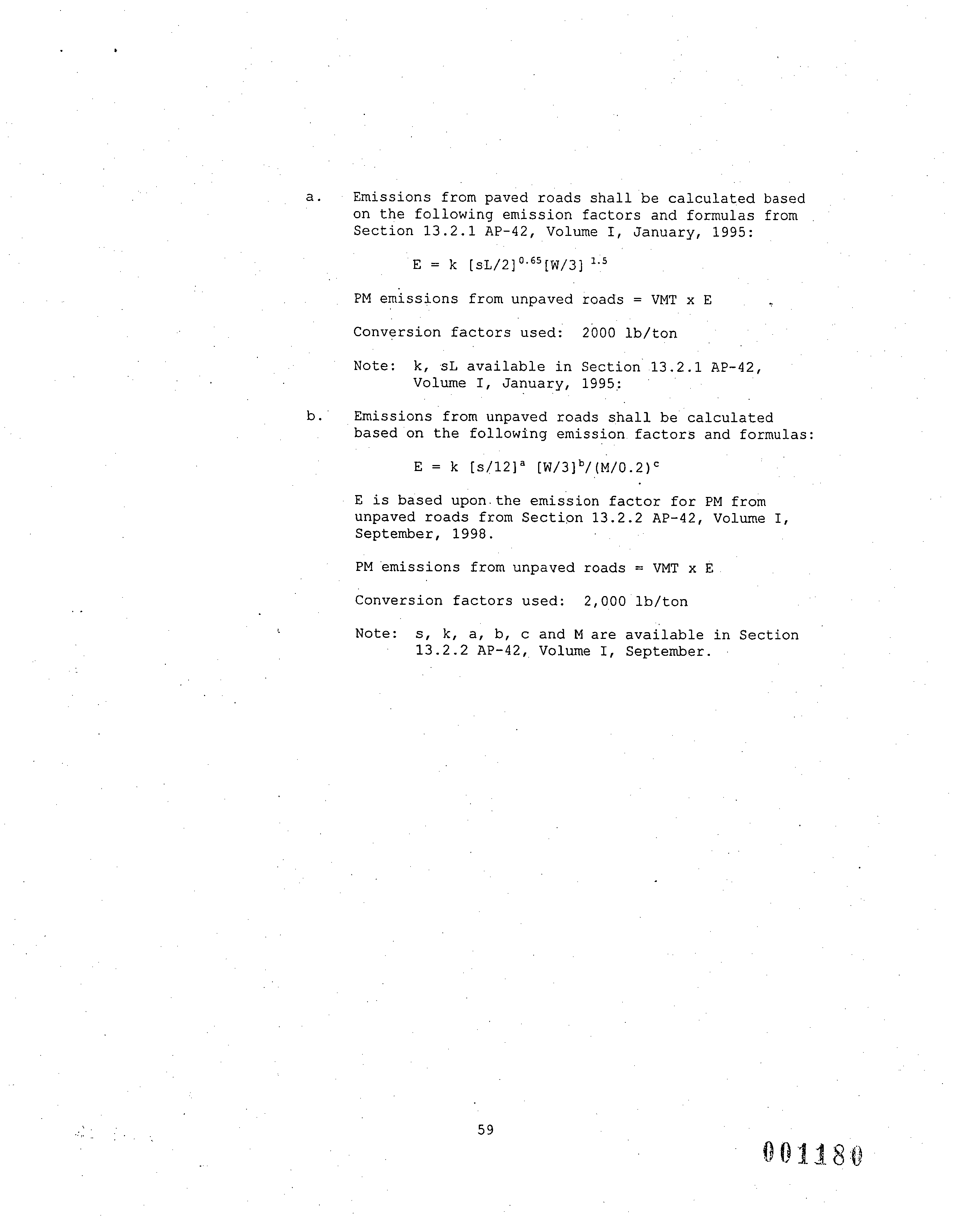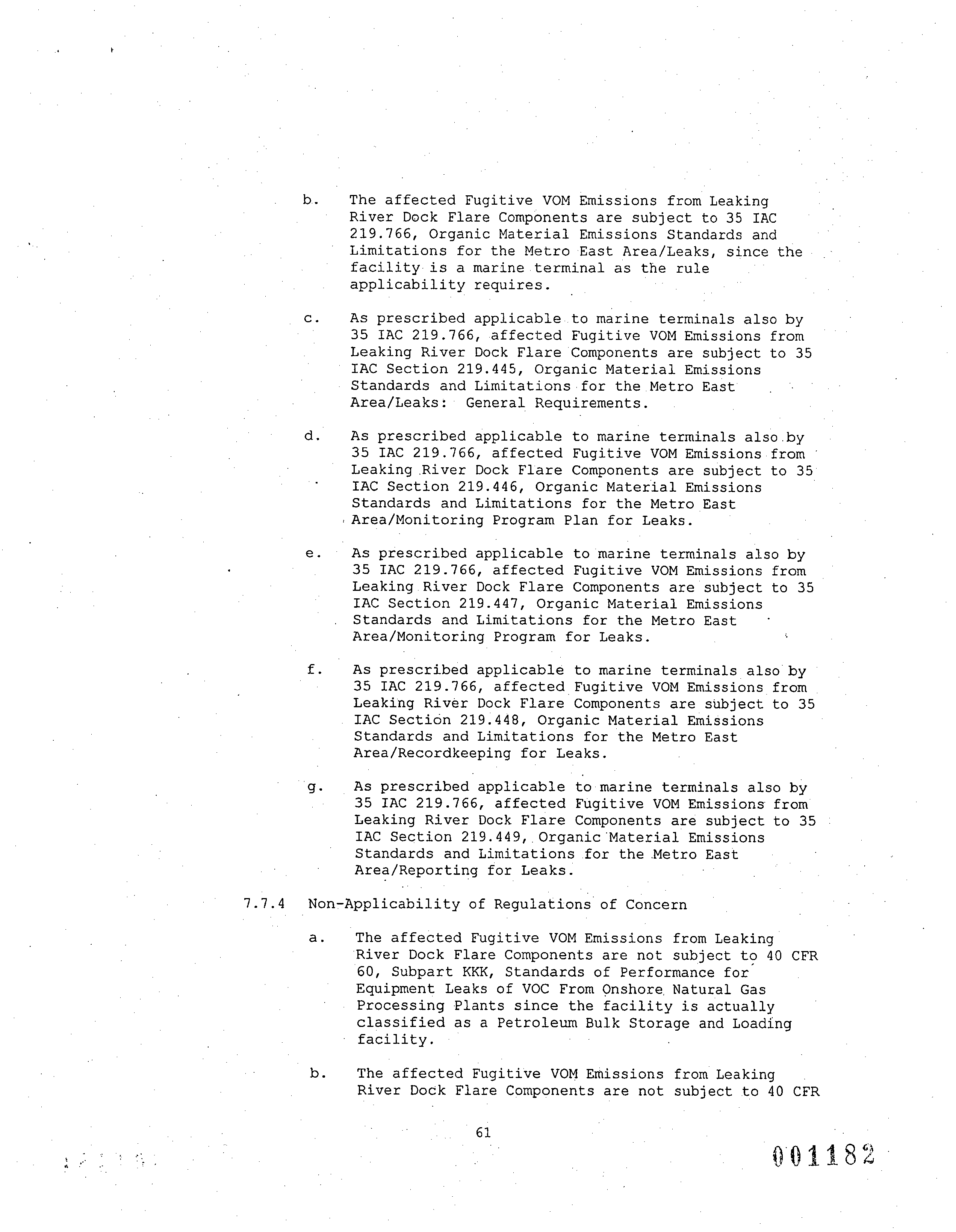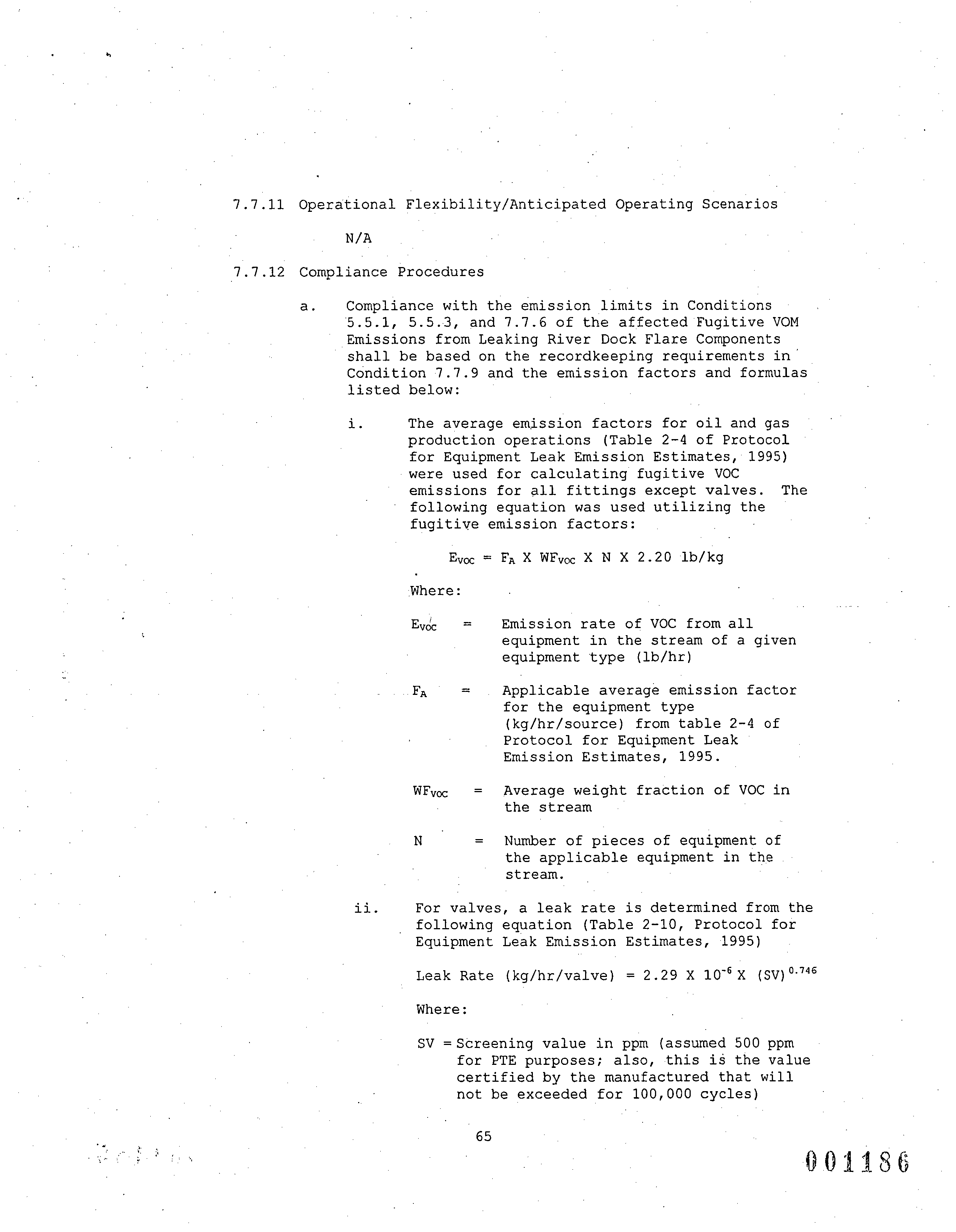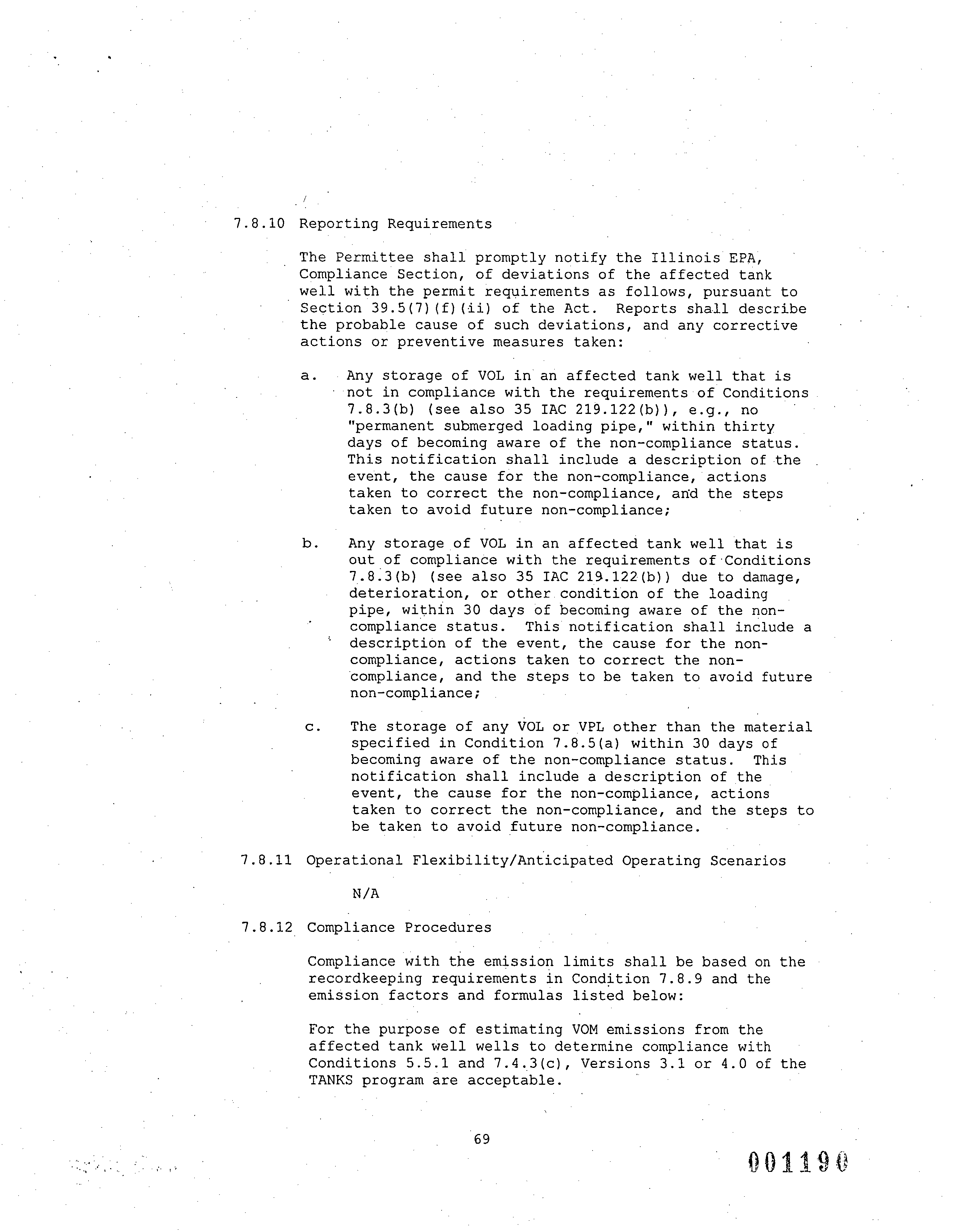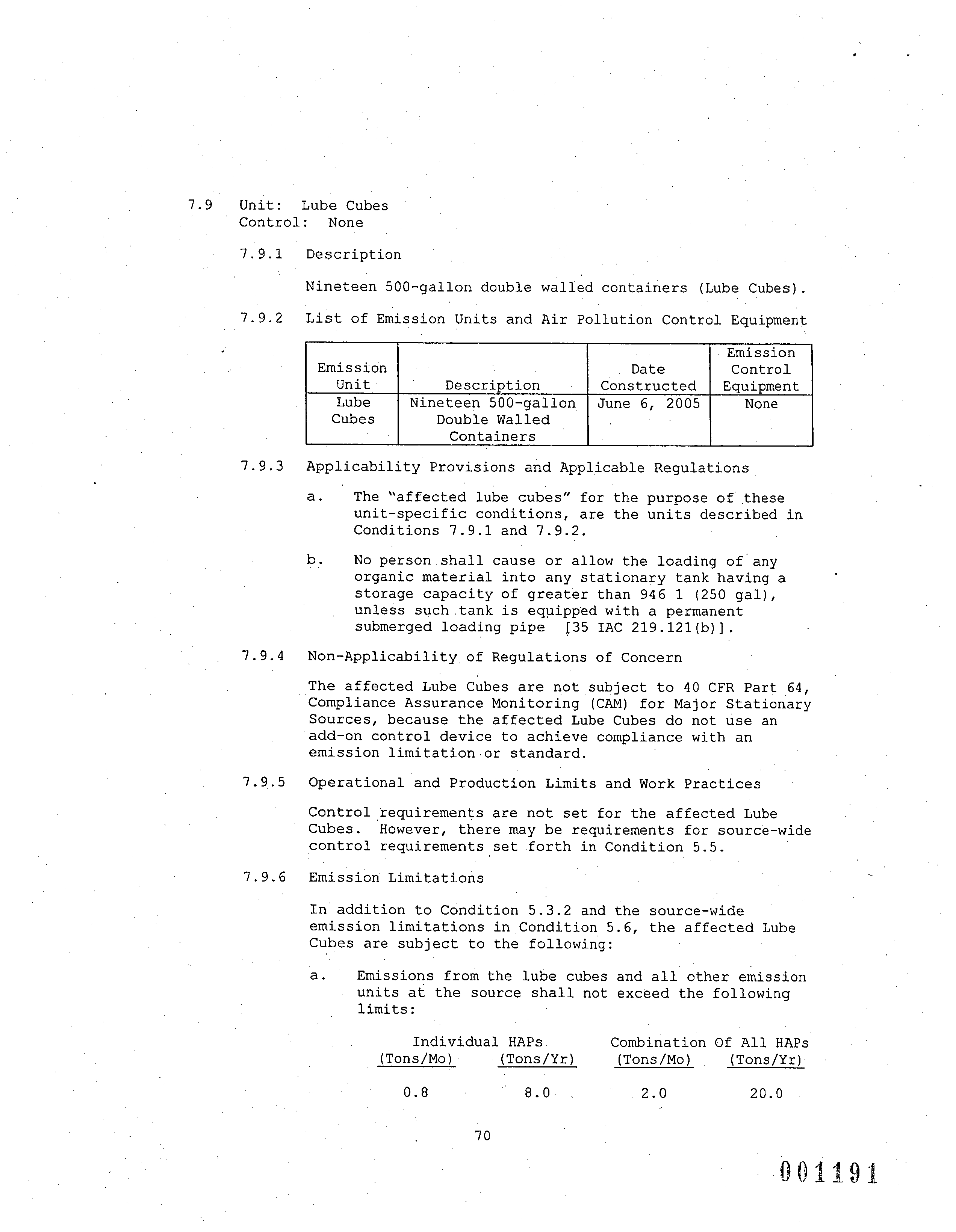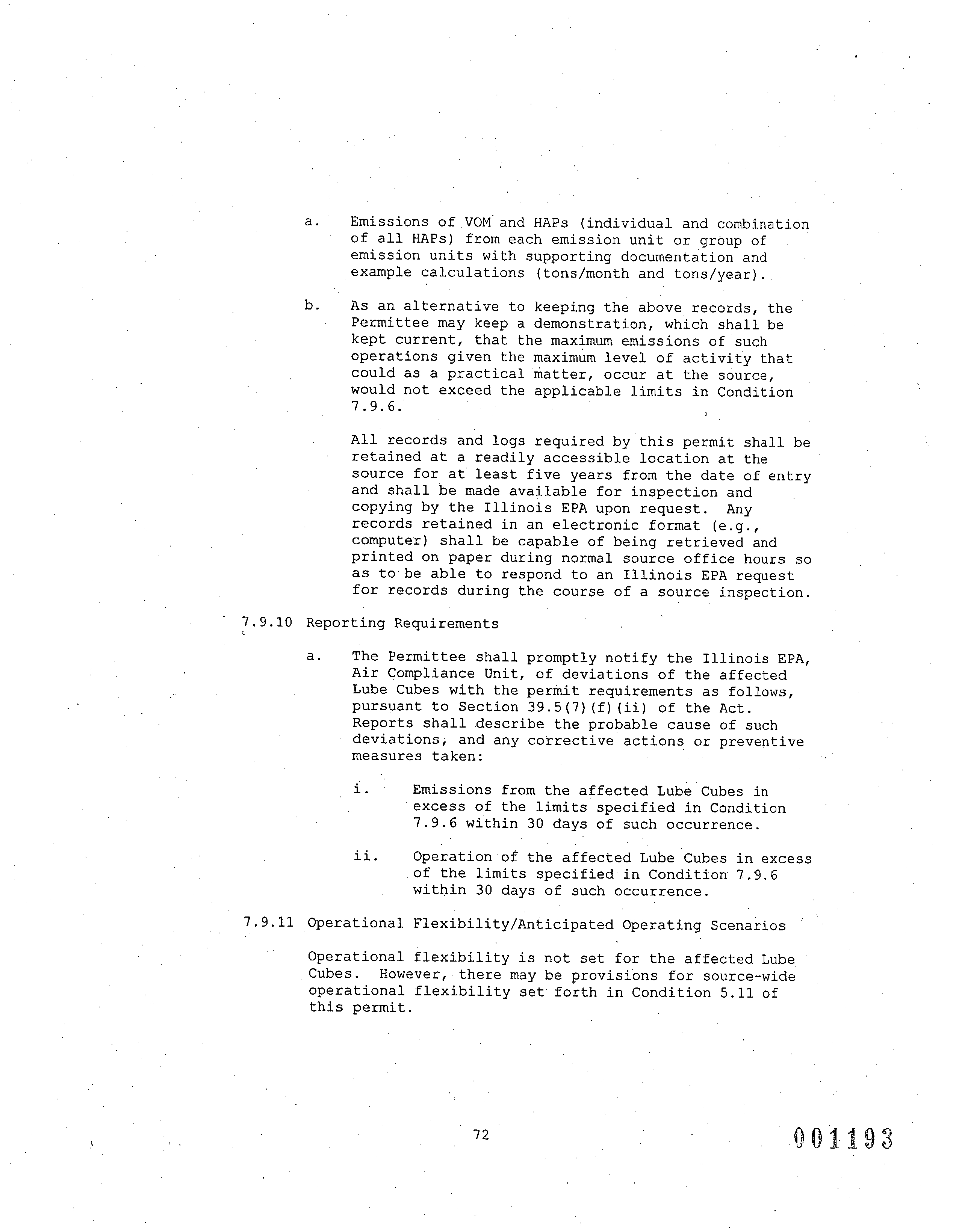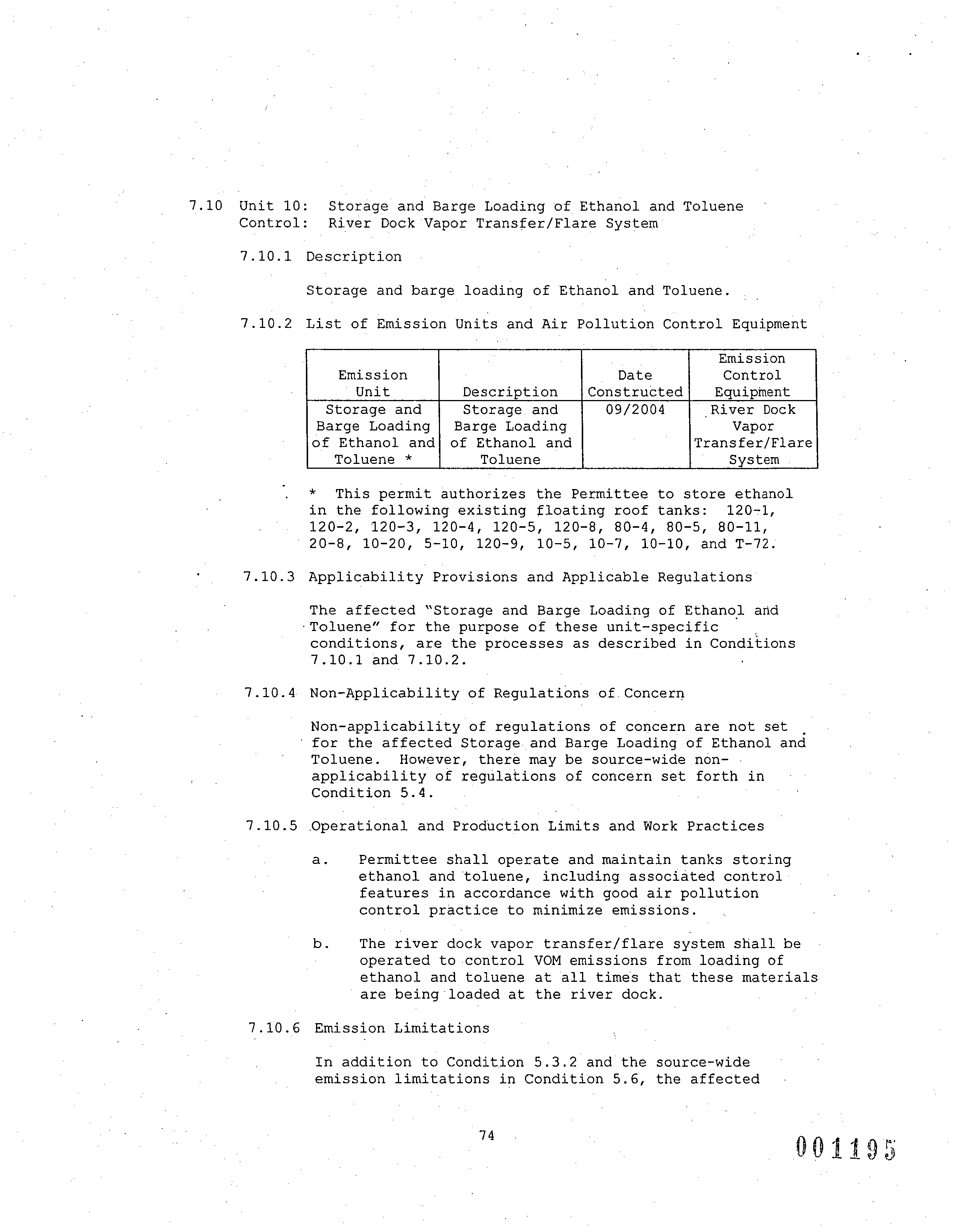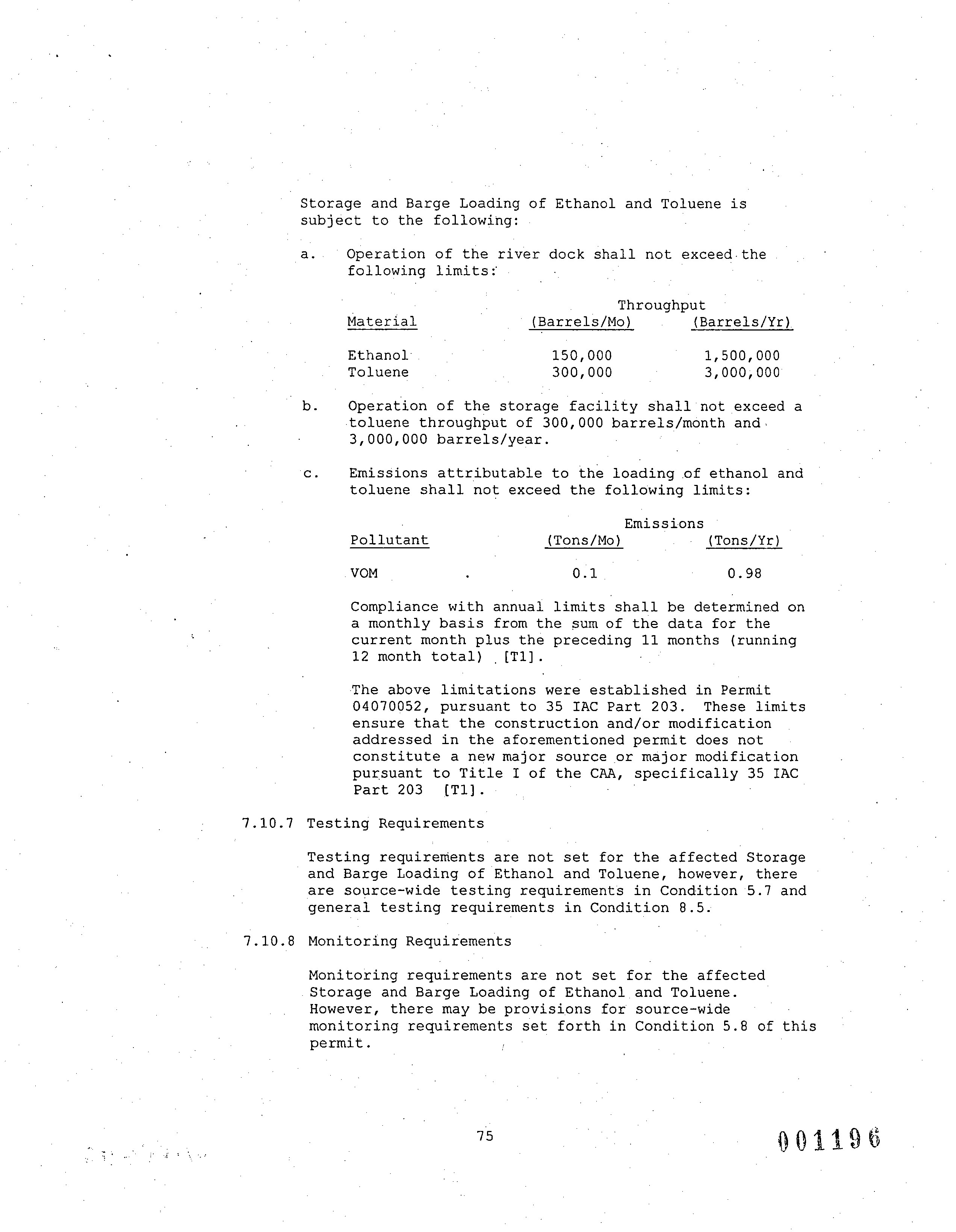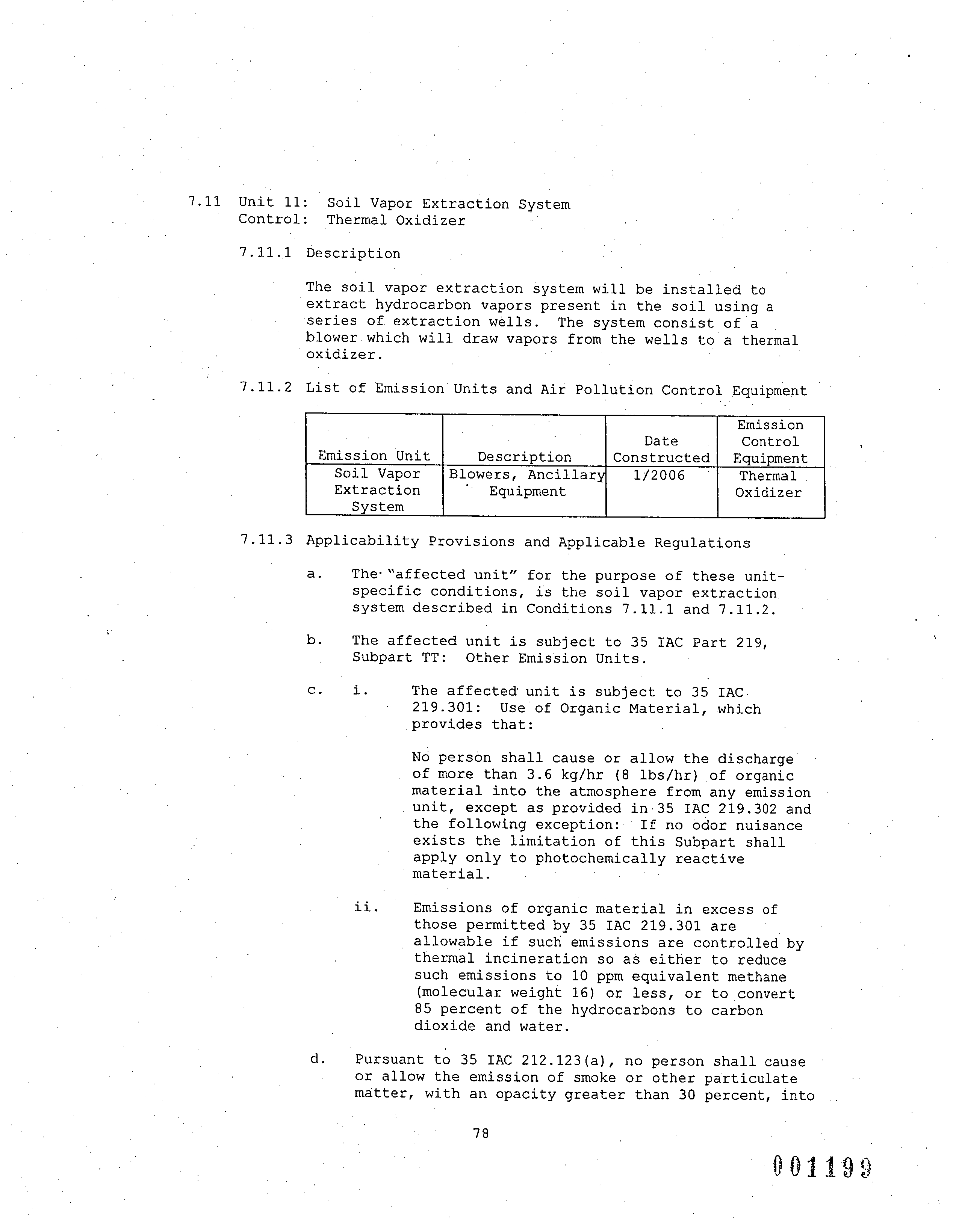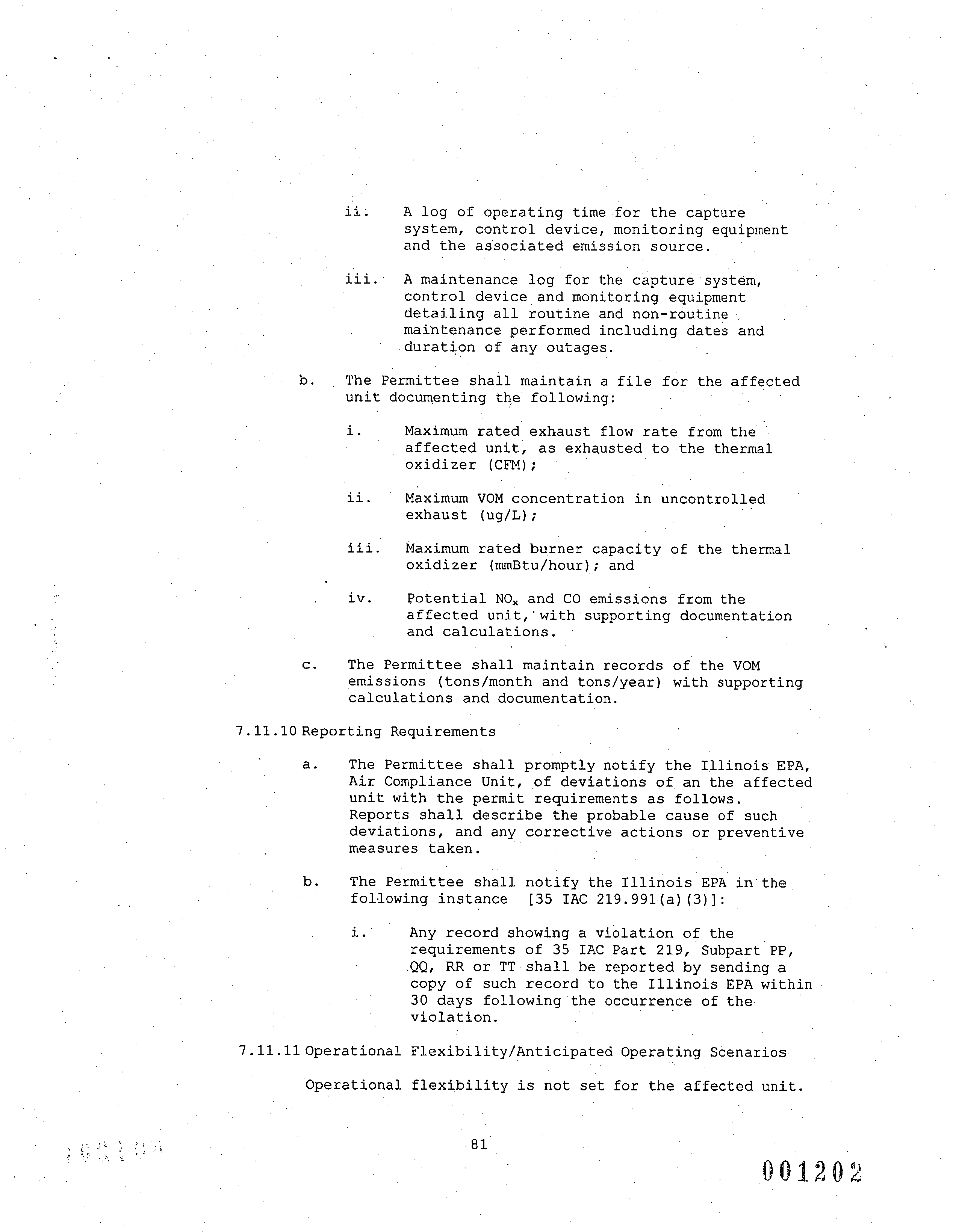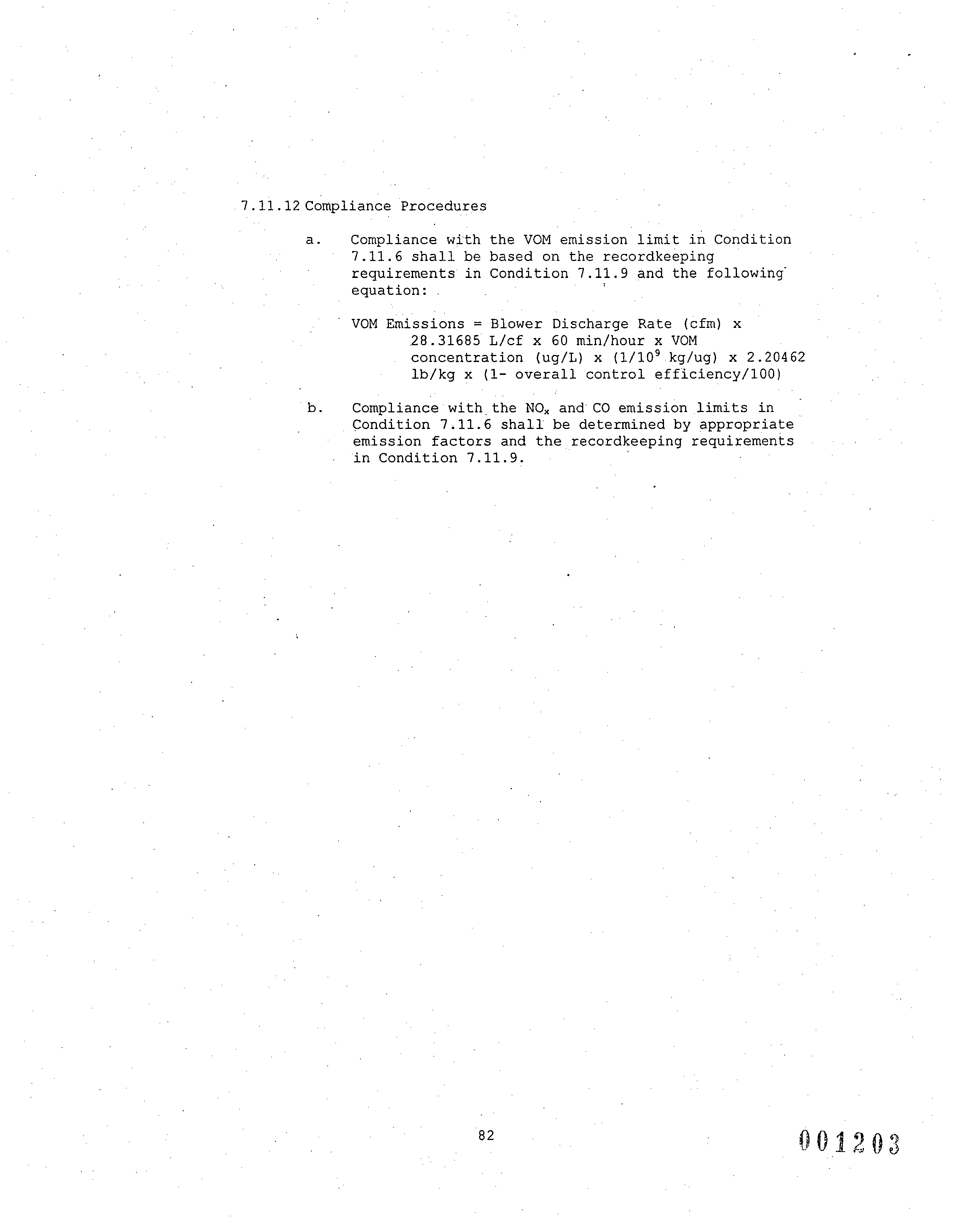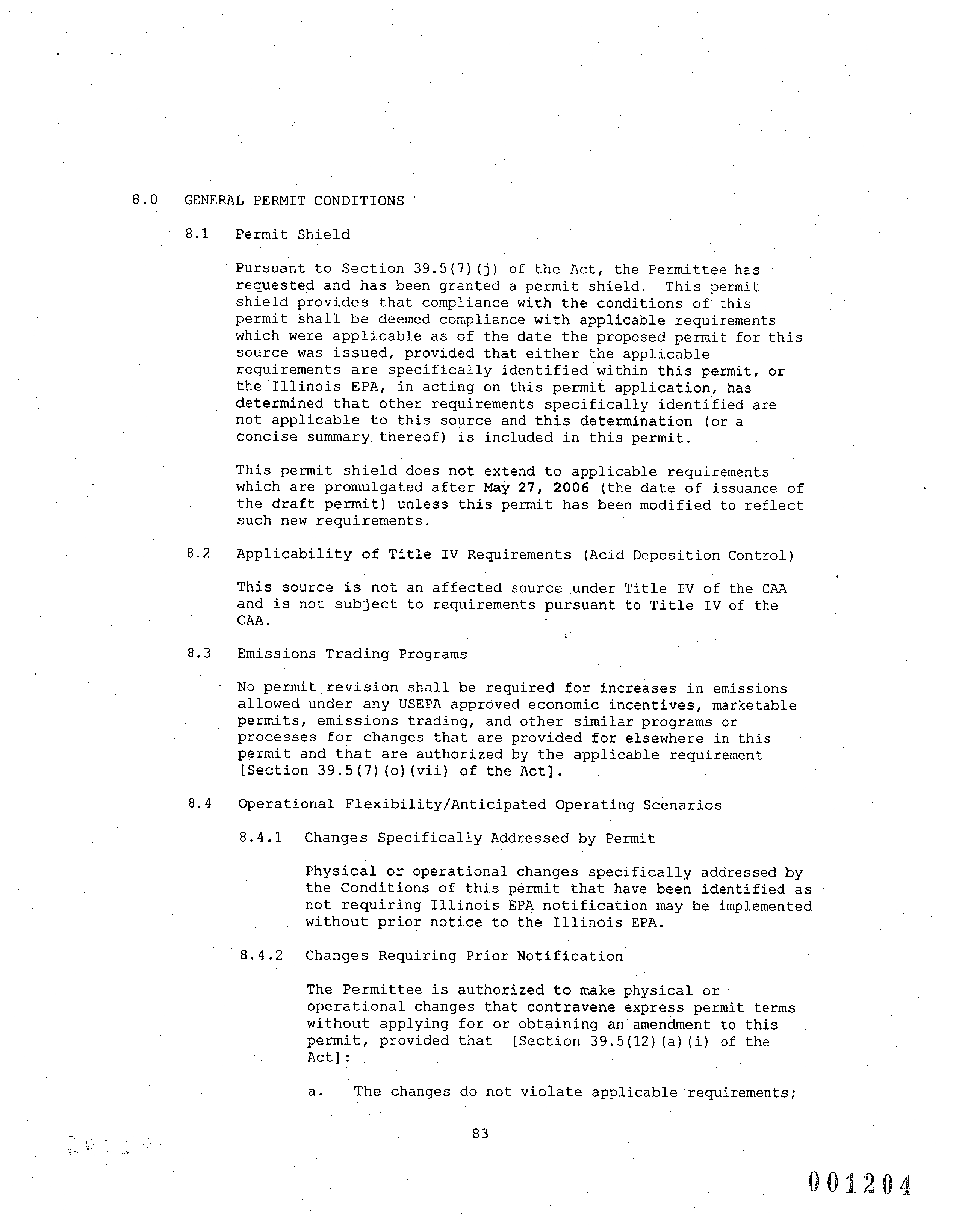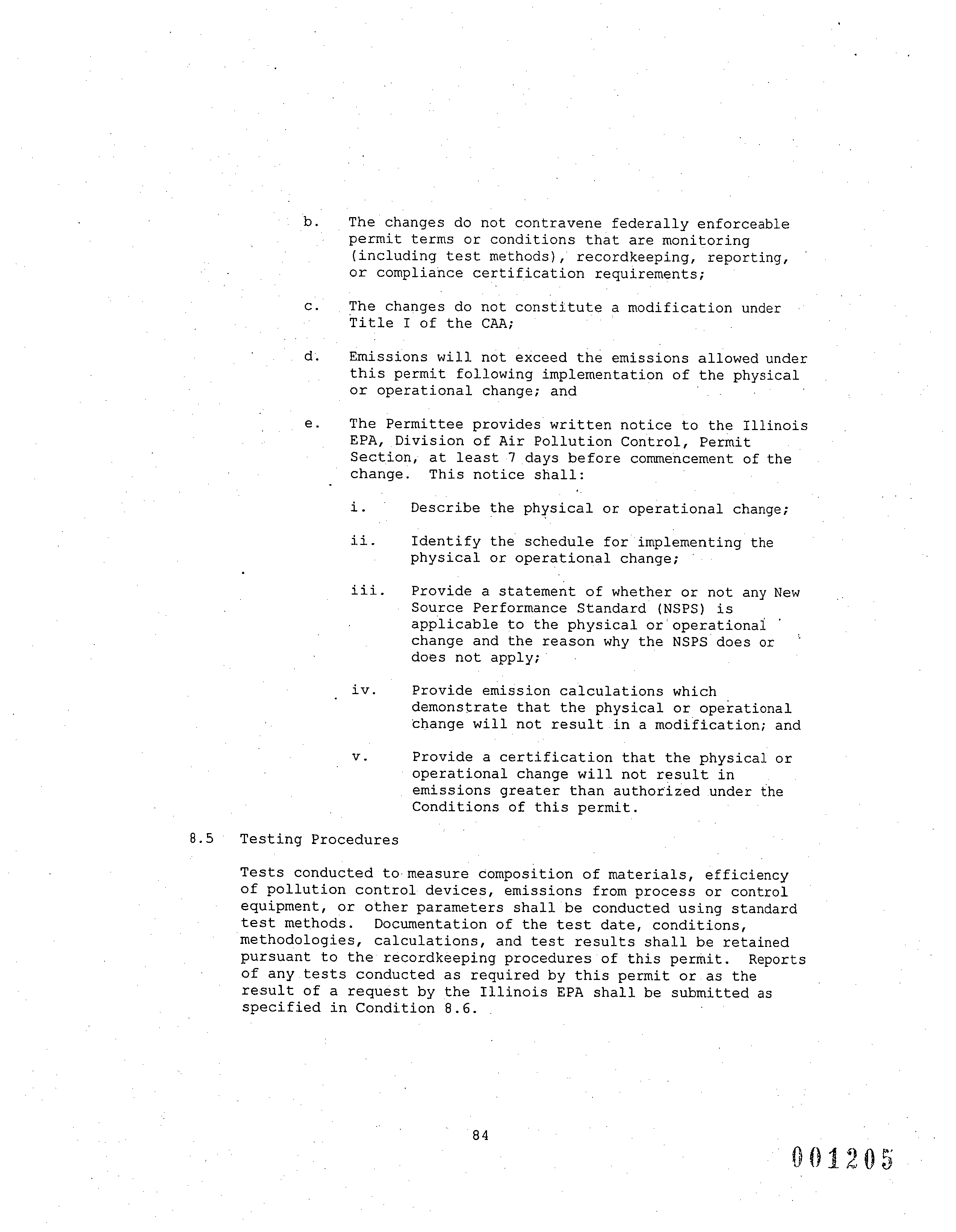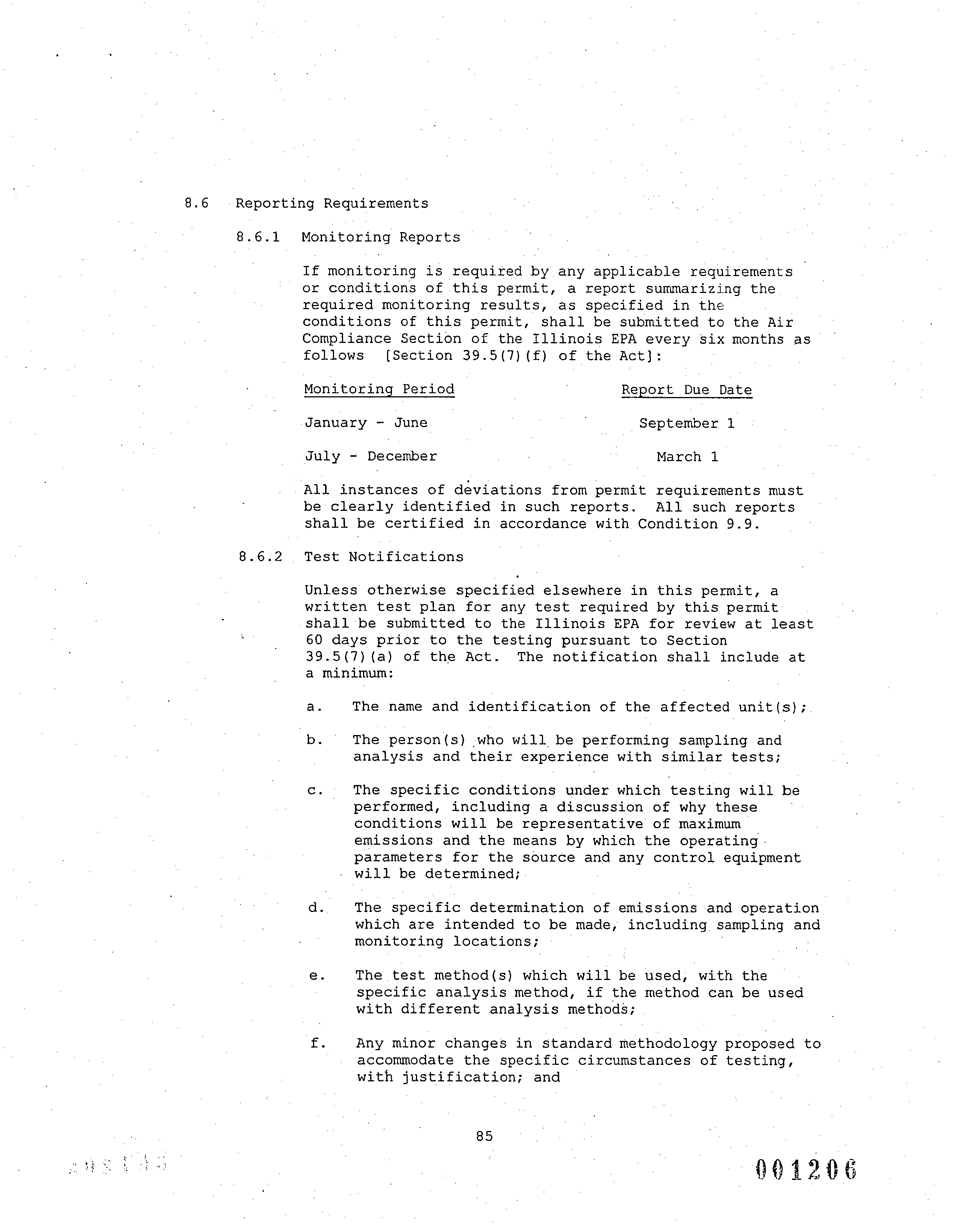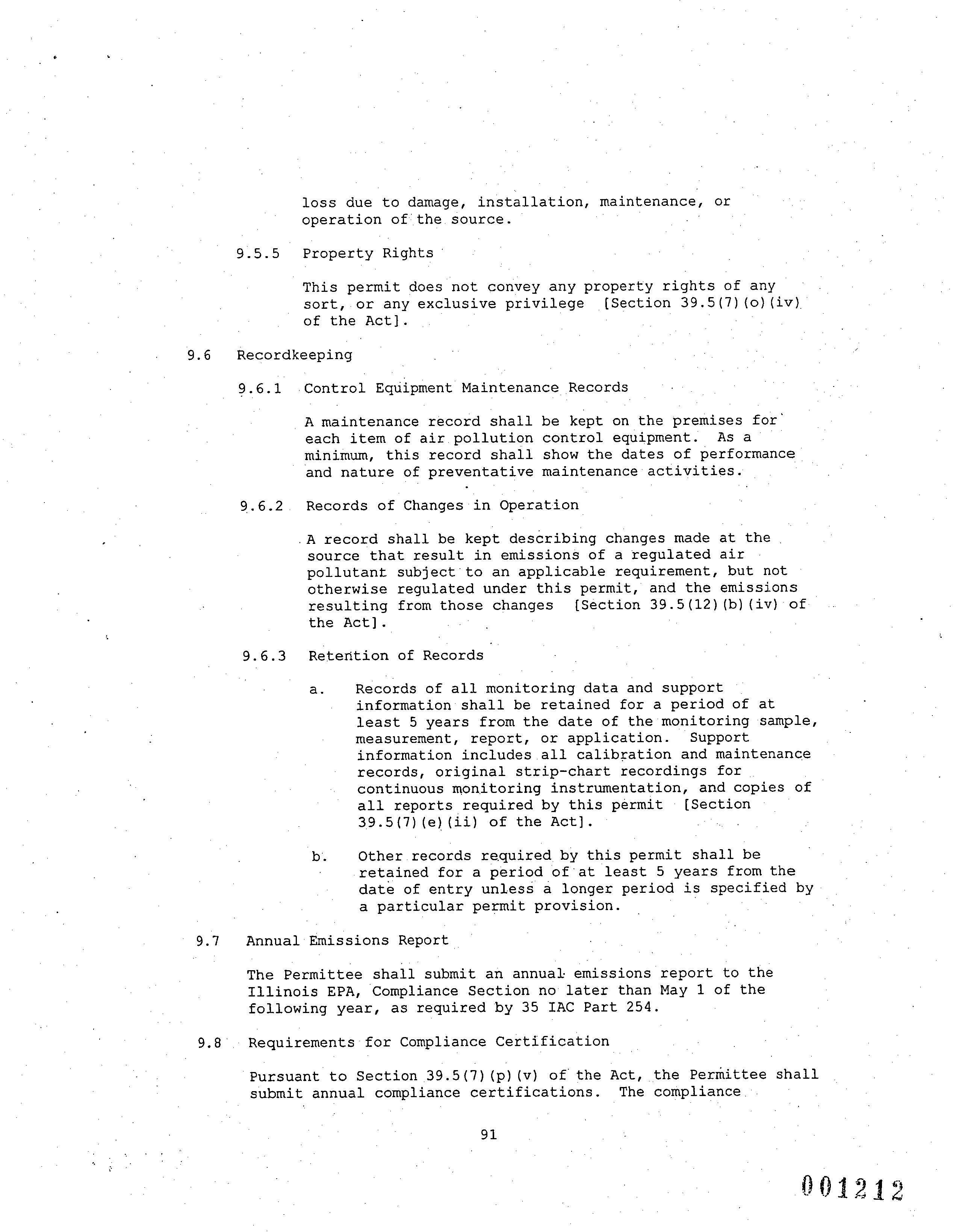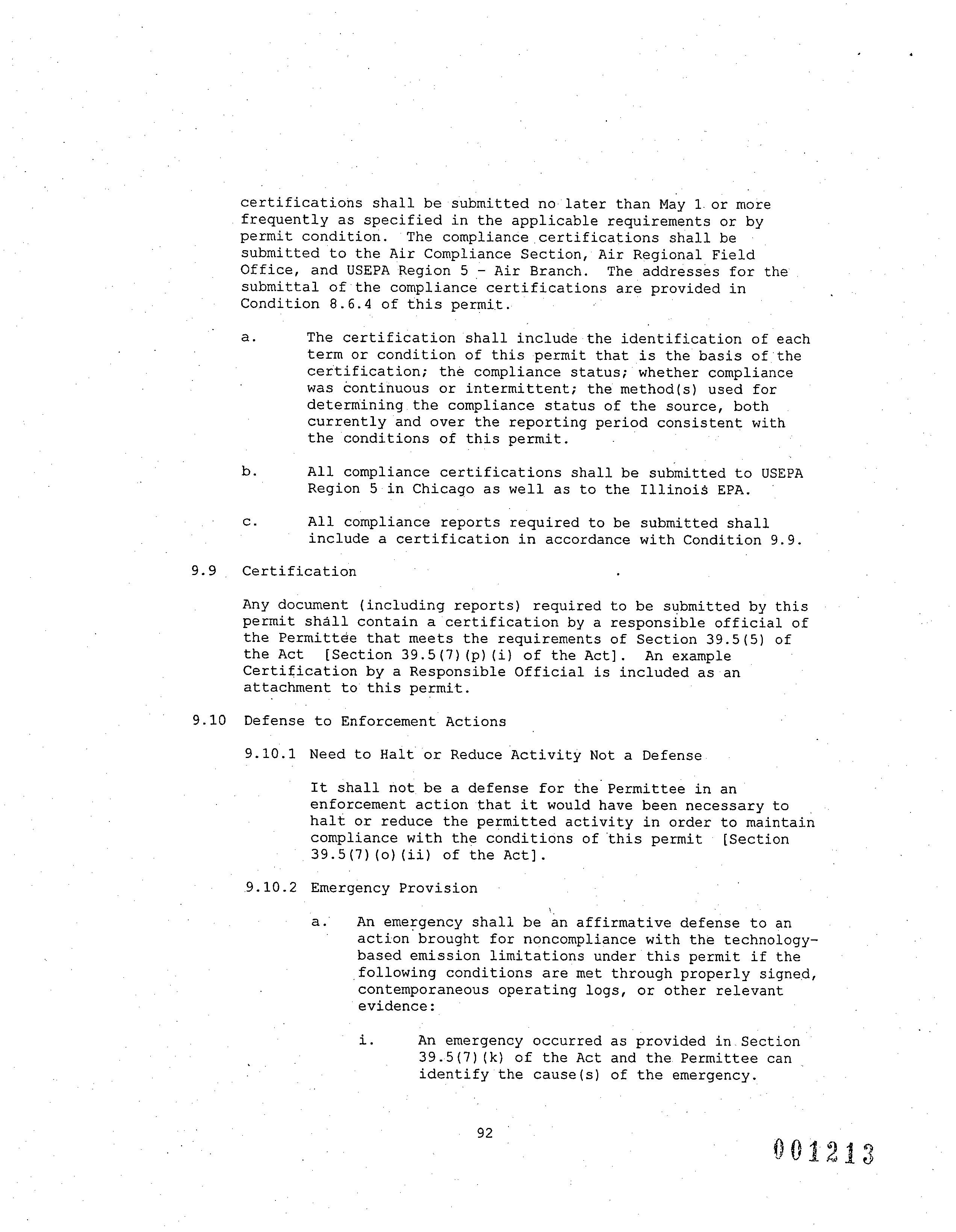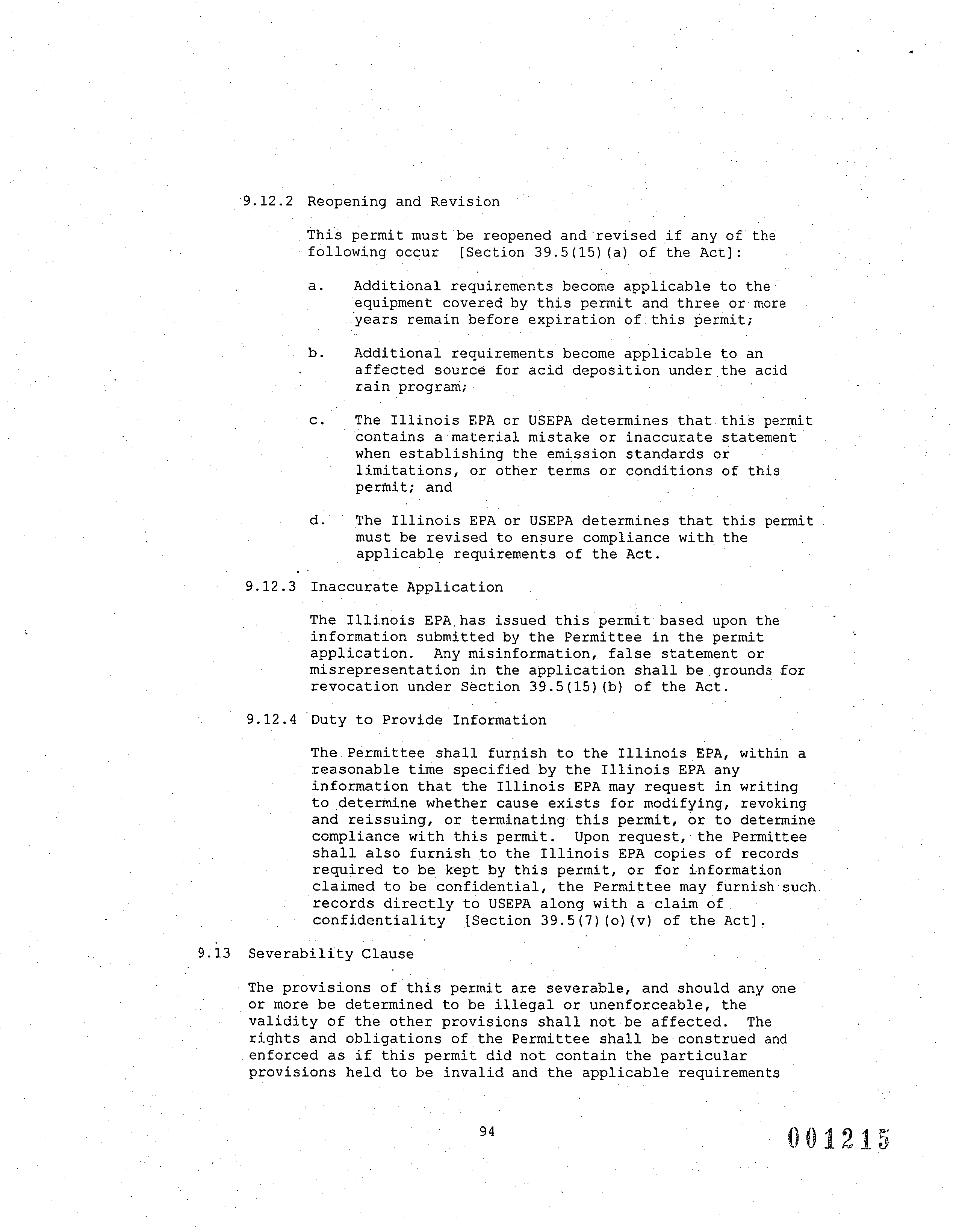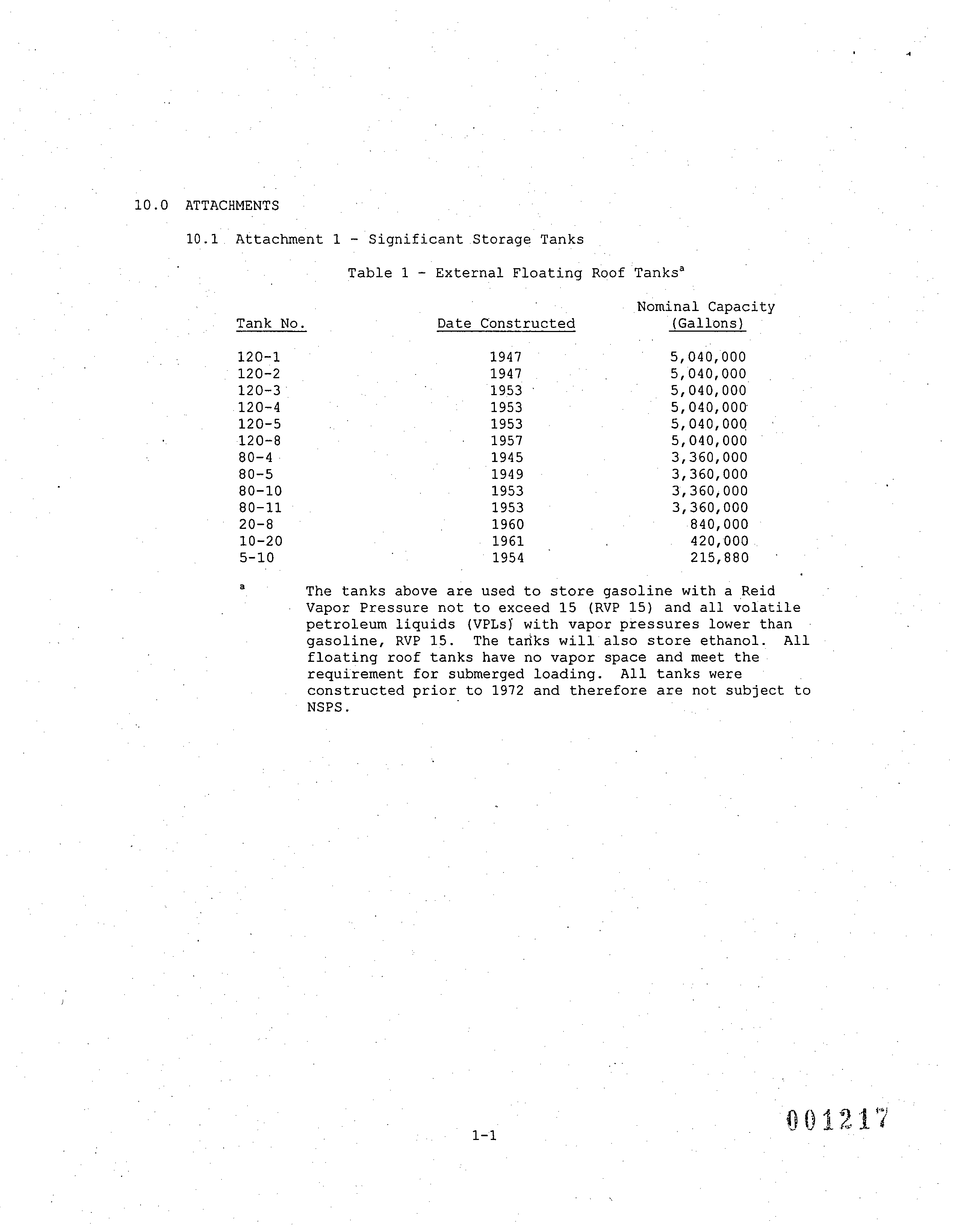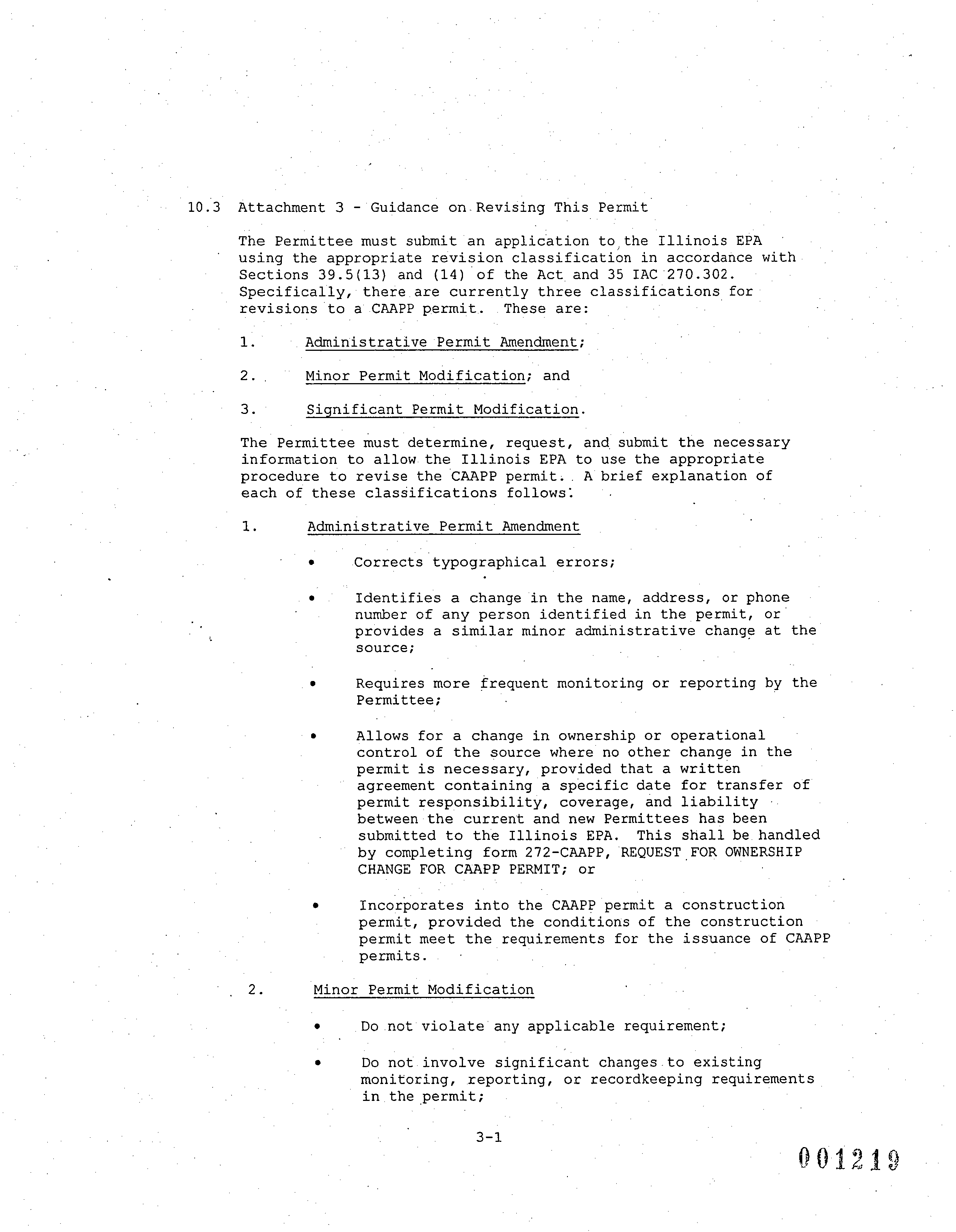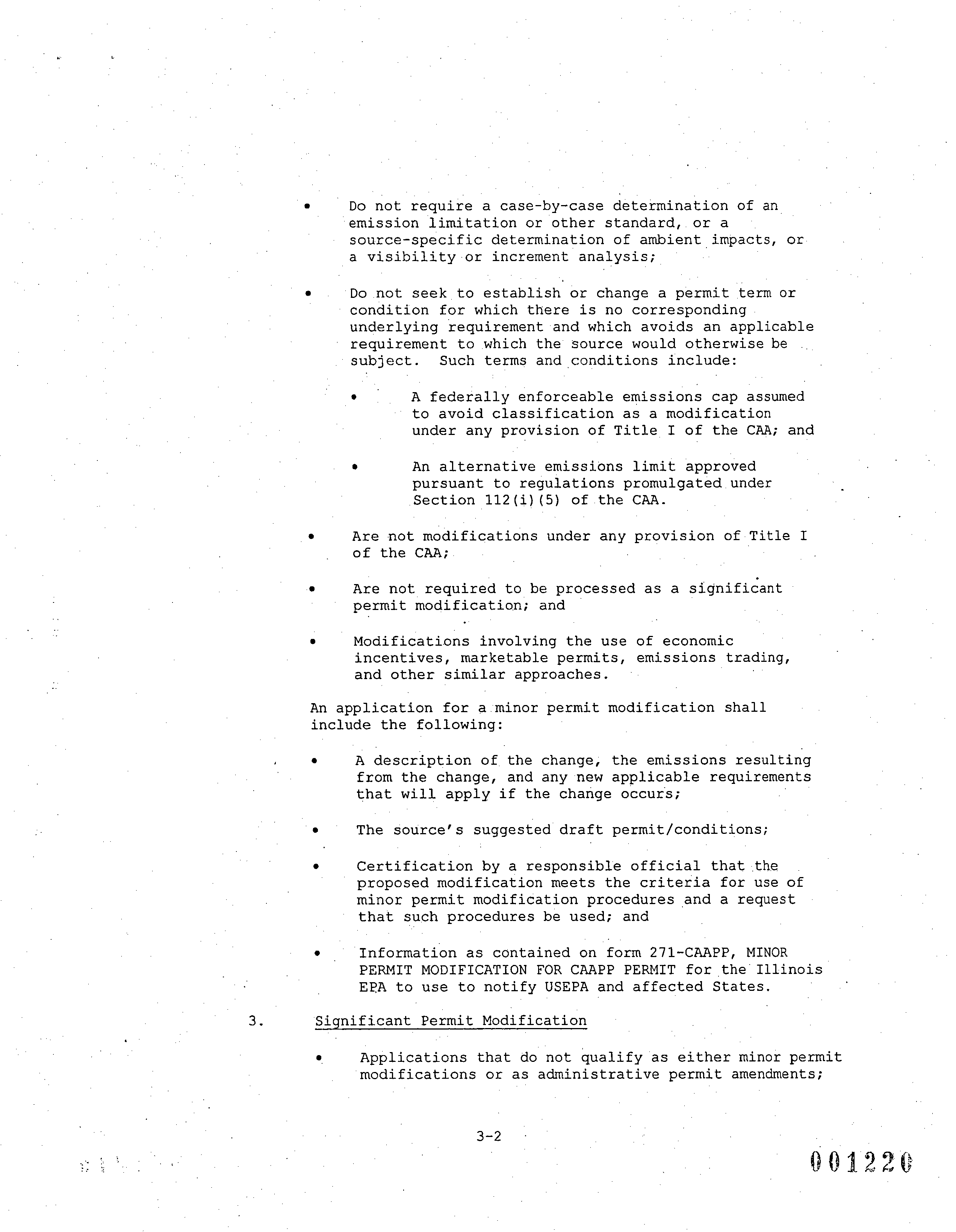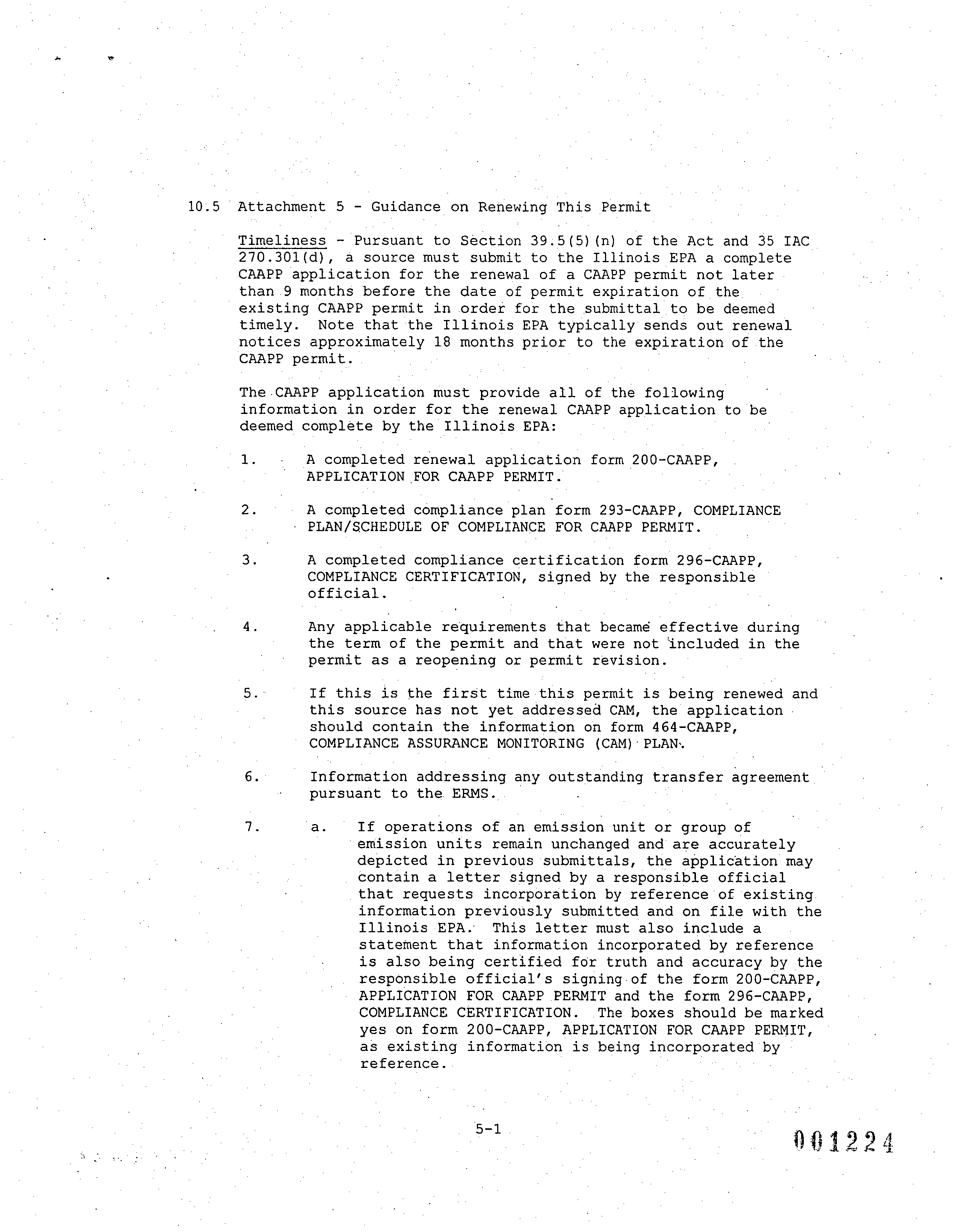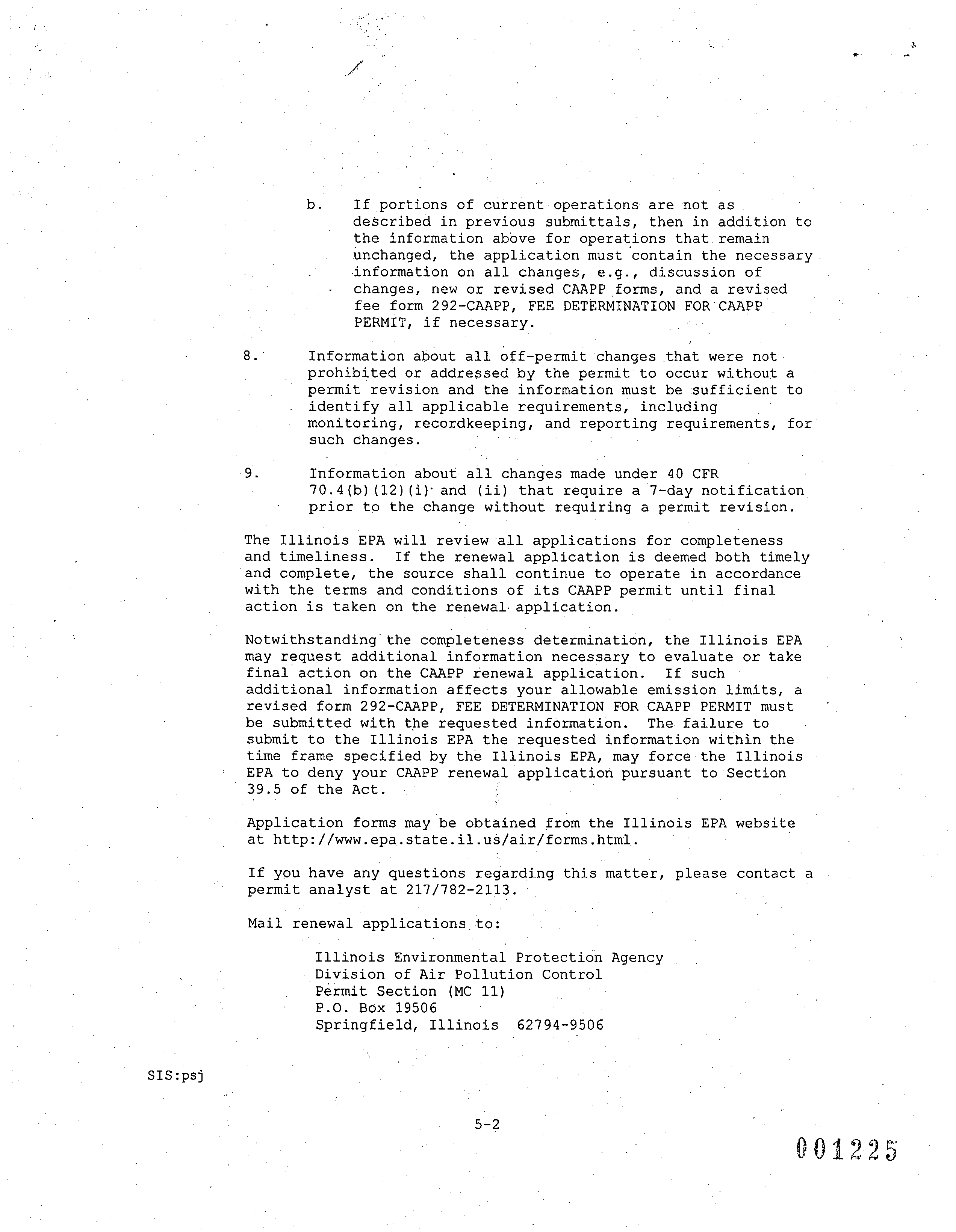217/782-2113
TITLE V - CLEAN AIR
ACT PERMIT PROGRAM (CAAPP) PERMIT
and
TITLE I PERMIT'.
PERMITTEE
The Premcor Refining Group, Inc. - Hartford
Distribution Center
Attn: Becky Malloy, Environmental Contact
2
01 East Hawthorne
Hartford,
Illinois 62048
Application No.: 96030082
I.D. No.:
119050AAA
Applicant's
Designation:
Date Received: March.7,
1996
Operation of:
Marine
Terminal
Date Issued: September 19, 2006
Expiration Date 2: September 19, 2011
Source Location: 201 East Hawthorne, Hartford, Madison
County
Responsible Official: Ed Jacoby, Vice
President of Wholesale, Marketing
and
Distribution
This permit is hereby granted to the above-designated
Permittee to OPERATE
a
Petroleum Bulk Storage and Loading Terminal, pursuant to
the above referenced
permit application. This permit is
subject to the conditions contained
herein.
If you have any questions concerning
this permit, please contact Sunil
Suthar
at 217/782-2113.
Donald E. Sutton, P.E.
Manager, Permit Section
Division of Air Pollution
Control
DES:SIS:psj
cc: Illinois EPA, FOS, Region
3
CES
Lotus Notes
1
z
This permit may contain terms and conditions which
address the applicability, and
compliance if determined applicable, of Title I of the CAA and
regulations promulgated
thereunder, including 40 CFR 52.21 -
federal PSD and 35 IAC Part 203 - Major
Stationary
Sources Construction and Modification. Any
such terms and conditions are identified
within
this permit.
Except as provided in Condition 8.7 of this permit.
EXHIBIT
1
ELECTRONIC FILING, RECEIVED, CLERK'S OFFICE, DECEMBER 22, 2006
TABLE OF CONTENTS
PAGE
1.0 SOURCE IDENTIFICATION
1.1 Source
1 .2 Owner/Parent
Company
1.3 Operator
1 .4 General Source
Description
2.0 LIST OF ABBREVIATIONS/ACRONYMS
USED
IN THIS PERMIT
5
3.0
INSIGNIFICANT ACTIVITIES
7
3 .1 Identification
of Insignificant Activities
3.2 Compliance with
Applicable Requirements
3.3 'Addition
of Insignificant
Activities
4 .0
SIGNIFICANT EMISSION
UNITS AT THIS SOURCE
9
5.0 OVERALL SOURCE CONDITIONS
11
5 .1
Source Description
5.2 Applicable Regulations
5.3
Non-Applicability of Regulations
of Concern
5 .4 Source-Wide
Operational and Production
Limits and Work
Practices-
5.5 Source-Wide
Emission Limitations
5.6 General Recordkeeping
Requirements
5.7
General Reporting Requirements
5.8 General
Operational Flexibility/Anticipated
Operating
Scenarios
5 .9
General Compliance Procedures
5.10 Special Permit
Shield
6 .0 NOT APPLICABLE
TO THIS PERMIT
17
7.0
UNIT SPECIFIC CONDITIONS
18
7.1 Unit 01: Vapor
Control System
Control: Thermal
Treatment Unit (Enclosed Flare)
7.2
Unit 02: River Dock (Marine
Vessel Loading)
Control:
Vapor Recovery Unit
7 .3 Unit 03: External
Floating Roof Storage
Tanks
Control: Floating
Roof, Double Seals and Submerged
Loading
7.4
Unit 04: Internal Floating
Roof Storage Tanks
Control:
Floating Roof and Seals,
Permanent Submerged
Loading
7 .5 Unit 05: Wastewater
Treatment System
Control: None
7 .6
Unit 06: Fugitive Emissions
- Paved and Unpaved Roadways
P ()1,
ELECTRONIC FILING, RECEIVED, CLERK'S OFFICE, DECEMBER 22, 2006
PAGE
7.7 Unit 07: Fugitive VOM
Emissions from Leaking River Dock
Flare Components
C ontrol: Leak Detection and Repair
Program
7.8 Unit
08: Gasoline Storage Tanks
Control: None
7 .9 Unit 09: Lube..Cubes
Control: None
7.10
Unit 10: Storage and Barge Loading.
of Ethanol and Toluene
-Control: River
Dock Vapor Transfer/Flare System
7.11 Unit 11: Soil Vapor Extraction
System
Control: Thermal Oxidizer
8 .0 GENERAL PERMIT CONDITIONS
83
8 .1 Permit Shield
8.2
Applicability of Title IV Requirements
8.3 Emissions-Trading
,Programs
8.4 Operational Flexibility/Anticipated
Operating Scenarios
8.5 Testing
Procedures
8.6 Reporting Requirements
8.7 Obligation to Comply with Title
I. Requirements
9 .0 STANDARD PERMIT CONDITIONS
88
9 .1 Effect,
of Permit
9.2' General Obligations of
Permittee
9.3 Obligation to Allow Illinois EPA
Surveillance
9.4 Obligation to
Comply with Other Requirements
9.5 Liability
9.6 Recordkeeping
9.7 Annual Emissions Report
9.8 Requirements for Compliance
Certification
9.9 Certification
9.10 Defense
to Enforcement Actions
9.11 Permanent Shutdown
9.12 Reopening and Reissuing Permit for
Cause
9.13 Severability
Clause
9.14 Permit Expiration
and Renewal
1 0.0 ATTACHMENTS
1 0.1 Attachment 1 - Significant
Storage Tanks
1-1
10.2 Attachment 2 - Example
Certification by a Responsible
2-1
Official
10.3 Attachment 3 - Guidance on Revising
This Permit'
3-1
10.4 Attachment
4 - Form 199-CAAPP, Application.For
4-1
Construction
Permit (For CAAPP Sources
Only)
10.5 Attachment
5 - Guidance on Renewing This Permit
5-1
ELECTRONIC FILING, RECEIVED, CLERK'S OFFICE, DECEMBER 22, 2006
.1.0 SOURCE
IDENTIFICATION
1 .1 Source
The Premcor Refining Group,.Inc. -Hartford Distribution Center
201 East
Hawthorne
Hartford, Illinois-
62048
I.D.
No.: 119050AAA
Standard
Industrial Classification.: 5171, Petroleum Bulk Storage
and Loading
1.2 '
Owner/Parent Company.
The Premcor Refining Group, ;Inc.
201 East Hawthorne
Hartford, Illinois
62048.
1.3 Operator
The Premcor Refining'Group, Inc
201 East
Hawthorne
Hartford, Illinois 62048
Bill Malloy,
Environmental Contact
618/254-7301 Ext. 261
1.4 General Source
Description
The Premcor
Refining Group, Inc. - Hartford Distribution Center
is located at 201 East Hawthorne, Hartford,
Illinois. The source
is engaged in petroleum storage and distribution operations.
ELECTRONIC FILING, RECEIVED, CLERK'S OFFICE, DECEMBER 22, 2006
2.0
LIST OF ABBREVIATIONS/ACRONYMS
USED IN THIS PERMIT
Act
Illinois Environmental
Protection Act
[415 ILCS 5/1 et seq.]
AP-42
Compilation of Air Pollutant
Emission Factors, Volume
1,
Stationary Point and Other
Sources (and Supplements A
through F),
USEPA, Office of Air Quality
Planning and
Standards,
Research Triangle Park, NC 27711
B tu
British thermal unit
CAA
Clean Air Act
[42 U.S.C. Section 7401
et seq.]
CAAPP
Clean Air Act Permit Program
.
CAM
Compliance Assurance
Monitoring
C FR
Code of Federal Regulations
E RMS
Emissions Reduction
Market System
`F
d egrees
Fahrenheit
ft
cubic
feet
gal
gallon
'HAP
Hazardous
Air Pollutant
h p
horsepower
hr
hour
I AC
Illinois Administrative Code
I.D. No.
Identification Number
of Source, assigned by Illinois EPA
ILCS
Illinois Compiled
Statutes
Illinois EPA
Illinois Environmental Protection
Agency
'K
degrees Kelvin
K g
Kilogram
k Pa
Kilopascals
kW
kilowatts
1
liter
lb
pound
m
cubic meters
mmBtu
Million British thermal
units
m o
month
NESHAP
National Emission Standards
for Hazardous Air Pollutants
NO,,
Nitrogen Oxides
NSPS
New Source
Performance Standards
PM
Particulate Matter
PM10
P articulate
matter with an aerodynamic
diameter less than or
equal to a nominal
10 microns as measured
by applicable test
or monitoring methods
-PPM
parts per
million
P SD
Prevention of Significant
Deterioration
p sia
pounds per square
inch absolute
RMP
Risk Management Plan
RVP
Reid Vapor
Pressure
S02
S ulfur Dioxide
Tl
Title
I - identifies Title I conditions
that have been
carried over
from an existing permit
T1N
Title I New - identifies
Title I conditions that
are being
established in this permit
5
ELECTRONIC FILING, RECEIVED, CLERK'S OFFICE, DECEMBER 22, 2006
TIR
Title I Revised - identifies Title I conditions that have
been carried over from an existing permit and-'subsequently
revised
in this permit
USEPA
United States Environmental Protection Agency
VOL
Volatile
Organic Liquid
VOM
Volatile Organic Material
VPL
Volatile Petroleum
Liquid
wt.
weight
r -
ear
-001127
ELECTRONIC FILING, RECEIVED, CLERK'S OFFICE, DECEMBER 22, 2006
3.0 INSIGNIFICANT ACTIVITIES
3 .1 Identification of Insignificant
Activities
The
following activities at the
source constitute insignificant
activities
as specified in 35 IAC 201.210:
3.1.1 Activities determined
by the Illinois EPA to
be
insignificant activities, pursuant
to 35 IAC 201.210(a)(1)
and 201.211, as follows:
Chemical Storage
Tank
Chemical Storage
Drum
3.1.2 Activities
that are insignificant activities
based upon
maximum emissions, pursuant
to 35 IAC 201.210(a)(2)
or.
(a)(3), as follows:
None
3 .1.3
Activities that are insignificant
activities based upon
their type or character,
pursuant to 35 IAC
201.210(a)(4)
through (18), as follows:
Direct combustion
units designed and
used for comfort
heating purposes and fuel
combustion emission units
as follows:
(A) Units with a rated
heat input
capacity of less
than 2.5 mmBtu/hr that fire
only
natural gas, propane, or
liquefied petroleum gas; (B)
Units with
a rated heat input capacity
of less than
1.0 mmBtu/hr that fire
only oil or oil in
combination
with only natural gas, propane,
or liquefied
petroleum
gas; and (C) Units with
a rated heat input
capacity of less than
200,000 Btu/hr which never
burn
refuse, or treated or chemically
contaminated wood
[35 IAC 201.210(a)(4)].
Storage tanks of organic liquids
with a capacity of
less
than 10,000 gallons and an
annual throughput of
less than 100,000
gallons per year, provided
the
storage tank is not used
for the storage of gasoline
or any material listed as a
HAP pursuant to Section
112(b)
of the CAA [35 IAC 201.210(a)(10)].
Storage tanks of any
size containing virgin or
re-
refined distillate oil, hydrocarbon
condensate from
natural gas pipeline or
storage systems, lubricating
oil, or residual fuel oils [35
IAC 201.210(a)(11)].
Storage tanks of
any size containing exclusively
soaps, detergents, surfactants,
glycerin, waxes,
vegetable oils, greases,
animal fats, sweeteners,
corn syrup, aqueous salt
solutions, or aqueous
caustic
solutions, provided an
organic solvent has
7
0
11211
1
ELECTRONIC FILING, RECEIVED, CLERK'S OFFICE, DECEMBER 22, 2006
not
been
mixed with such materials [35 IAC
201.210(a)(17)].
3 .1.4 Activities that are considered insignificant activities
pursuant to 35 IAC 201.210(b).
3.2 Compliance with Applicable Requirements
Insignificant activities are subject to
applicable requirements
notwithstanding status as insignificant activities. In
particular, in addition to regulations of general applicability,
such as 35 IAC 212.301 and 212.123 (Condition 5.2.2),
the
Permittee shall comply with the following
requirements, as
applicable:
3.2.1 For each cold cleaning degreaser,
the Permittee shall
comply with
the
applicable equipment and operating
requirements of 35 IAC 215.182, 218.182, or 219.182.
3.2.2 For each particulate matter process emission unit, the
Permittee shall comply with the applicable particulate
matter emission limit
of 35 IAC 212.321 or 212.322. For
example, the particulate matter emissions from a process
emission unit shall not exceed 0.55 pounds
per hour if the
emission
unit's
process
weight rate is 100 pounds per hour
or less, pursuant to 35 IAC 266.110.
3 .2.3 For each organic material emission unit that uses organic
material, e.g., a mixer or printing line, the
Permittee
shall comply with the applicable VOM emission limit of 35
IAC 215.301, 218.301, or 219.301, which requires
that
organic material emissions
not
exceed
8.0 pounds per hour
or do not qualify as photochemically reactive material as
defined in 35 IAC 211.4690.
3 .3 Addition of Insignificant Activities
3.3.1 The
Permittee
is not
required to notify the Illinois EPA
of additional. insignificant activities present at the
source of a type that is identified in Condition
3.1,
until the renewal application for this permit is
submitted, pursuant to 35 IAC 201.212(a).
3.3.2 The Permittee must notify the Illinois
EPA of any proposed
addition
of
a
new insignificant activity of a type
addressed by 35 IAC 201.210(a) and 201.211 other than
those identified in Condition 3.1, pursuant to Section
39.5(12)(b) of the Act.
3.3.3 The-Permittee is not required
to notify the Illinois EPA
of additional insignificant activities present at the
source of a type identified in 35 IAC 201.210(b).
8
ELECTRONIC FILING, RECEIVED, CLERK'S OFFICE, DECEMBER 22, 2006
4.0 SIGNIFICANT
EMISSION UNITS AT THIS SOURCE
Date
E mission
Constructed/ Emission Control
Unit
Description
Modified
Equipment
Unit 01
Vapor Control
System:,
1/92
Thermal Treatment
Control Boreholes,
Knock
Unit (Enclosed
Out Drum, Vacuum Blowers
Flare)
( 75
Hp/Electric)
Unit 02
Marine Vessel Loading,
1981a
vapor Recovery
Unit
and Flare
Unit 03 External Floating
Roof
Tanks:
120-1
1947
120-2
1947
Floating Roof,
'120-3
1953
Primary Seal and
120-4
1953
Rim-Mounted
120-5
1 953
S econdary
Seal,
120-7
---
Submerged Loading
120-8
1957
120-10
---
120-11
---
80-4
1945
80-5
1949
80-10
1953
80-11
1953
20-8
1960
10-20
1961
5-10
1954
Unit 04
Internal Floating Roof
1948/1990
Tanks:
Group 1 Tanksb
(Subject to 1941/1994
Internal
Floating
40 CFR 60, Subpart
Kb):
Roof, Submerged
20-3/840,000 Gal
Loading
10-10/.420,000
Gal
Group 2 Tanks (Not
1941
Subject to NSPS):
10-5/420,000
Gal
1941
10-7/420,000
Gal
T-3-1/126,000
Gal
1956
'
Group
3.` (Subject to 40
CFR 60, Subpart K)
Tank:
1975
120-9/5,040,000 Gal
ELECTRONIC FILING, RECEIVED, CLERK'S OFFICE, DECEMBER 22, 2006
'
Date
E mission
Constructed/ Emission Control
Unit
Description
Modified
Equipment -
Unit 05
Wastewater Treatment
1973/1994°
Anthracite/Sand
Plant: Entry Points, Two
Filters
(2) Equalization Tanks,
Diffused Air Flotation
_-
(DAF)
Unit, Two (2)
Aeration Basins, Two (2)
.
Clarifiers,
Anthracite/Sand Filter.
Unit 06 Fugitive Emissions from
---
---
Paved and Unpaved Roads
Unit 07
Fugitive VOM Emissions
Not
Leak Detection. and
f rom Valves, Flanges,
Available
Repair Program
Seals, and Miscellaneous
Components
-
Unit 08
Gasoline
Storage Tanks
Pre-1990
None
Unit
09
Lube
Cubes
nineteen 500- June 6, 2005
None
gallon double walled '
containers
Unit 10 Storage and
Barge Loading
09/2004
river dock vapor
of Ethanol and Toluene
transfer/flare
.
system
Unit 11
Soil Vapor Extraction
1/2006
Thermal Oxidizer
System: Blowers,
Ancillary Equipment.
0
b
C
d
Refurbished in'1981. A new platform was constructed, a new
pipeline was installed to the river dock.
The loading berth was
reconditioned and all new piping and loading arms installed:
Subject to.40 CFR 60, Subpart Kb
Subject to 40 CFR 60, Subpart K
Installation of two (2) equalization tanks
ELECTRONIC FILING, RECEIVED, CLERK'S OFFICE, DECEMBER 22, 2006
5.0 OVERALL
SOURCE CONDITIONS
5.1 Source Description
5.1.1 This permit is
issued.based on the source
requiring a
CAAPP permit as
a major source of VOM,
and CO emissions.
5 .1.2 This permit
is issued based on
the source not being a
major source
of HAPs.
5.2 Applicable
Regulations
5.2.1 Specific
emission units at this
source are subject to
particular regulations
as set forth in Section 7
(Unit-Specific Conditions)
of this permit.
5.2.2 In addition,
emission units at
this source are subject to
the following regulations
of general applicability
a. No
person shall cause
or allow the emission of
fugitive
particulate matter from
any process,
including any material
handling or storage activity,
that is visible
by an observer looking
generally
overhead
at a point beyond the property
line of the
source unless the wind
speed is greater than
40.2
kilometers
per hour (25 miles
per hour), pursuant to
35 IAC 212.301
and 212.314.
Compliance
with this requirement
is considered to be
assured by the inherent
nature of operations
at this
source,
as demonstrated
by historical operation.
b. No person shall
cause or allow the emission of smoke
or
other particulate matter,
with an opacity greater than
30 percent,
into the atmosphere from
any emission unit
other than those
emission units subject to the
requirements of 35 IAC 212.122,
pursuant to 35 IAC
212.123(a),
except as allowed
by 35 IAC 212.123(b) and
212.124.
5.2.3 Ozone Depleting
Substances
The Permittee shall
comply with the standards
for
recycling
and emissions reduction
of ozone depleting
substances
pursuant to 40 CFR
Part 82, Subpart F, except
as provided
for motor vehicle air-
conditioners in Subpart
B of 40 CFR
Part 82:
a. Persons opening
appliances for maintenance,
service,
repair, or disposal
must comply with the required
practices
pursuant to 40
CFR 82.156.
b. Equipment
used during the maintenance,
service,
repair, or
disposal of appliances must
comply with
11
010113"
ELECTRONIC FILING, RECEIVED, CLERK'S OFFICE, DECEMBER 22, 2006
the standards for recycling and recovery equipment
pursuant to 40 CFR 82.158.
Persons performing maintenance, service, repair, or
disposal of appliances must be certified by an
approved technician certification program pursuant to
40
CFR 82.161.
5.2.4 Risk Management Plan
Should this
stationary source, as defined in 40 CFR
Section 68.3, become subject to the Accidental Release
Prevention regulations in 40 CFR Part 68, then the owner
or operator shall submit
[40 CFR 68.215(a)(2)(i) and
(ii)]:
a.
A compliance schedule for meeting the requirements of
40 CFR Part 68 by the date provided
in 40 CFR
68.10(a); or
b . A certification statement
that the source is in
compliance with all requirements of 40 CFR Part 68,
including the registration
and submission of the Risk
Management Plan (RMP), as part of the annual
compliance certification required by 40 CFR Part 70
or 71.
5.2.5 a. Should this stationary
source become subject to a
regulation under 40 CFR Parts 60, 61, or 63, or
35 IAC
after the date issued of this permit, then the owner or
operator shall, in accordance with
the applicable
regulation(s), comply with the applicable requirements
by the date(s) specified and shall certify compliance
with the applicable requirements of such regulation(s)
as part of the annual compliance certification, as
required
by 40 CFR Part 70
or
71.
b . No later than upon the submittal for renewal of this
permit, the owner or operator shall submit, as part
of an application, the necessary information
to
address either the non-applicability of, or
demonstrate compliance with all applicable
requirements of
any
potentially
applicable regulation
which was promulgated after the date issued
of this
permit.
5.2.6
Episode Action Plan
a. If the source is required to have an episode action
plan pursuant to 35 IAC 244.142, the Permittee shall
maintain at the source and have on file with the
Illinois EPA a written episode action plan (plan) for
reducing the levels of emissions
during yellow
alerts, red alerts, and emergencies, consistent with
12
0 01-3'
ELECTRONIC FILING, RECEIVED, CLERK'S OFFICE, DECEMBER 22, 2006
safe operating
procedures. The plan
shall contain
the information
specified in 35 IAC 244.144.
b. The
Permittee shall immediately
implement the
appropriate
steps described in this plan
should an
air pollution
alert or emergency be
declared.
c.
If a change occurs at the
source which requires a
revision
of the plan (e.g., operational
change,
change
in the source contact person),
a copy of the
revised plan
shall be submitted to the Illinois
EPA
for review within
30 days of the change. Such plans
shall be further revised if
disapproved by the
Illinois EPA.
d. For sources required to
have a plan pursuant to 35
IAC
244.142, a copy of the
original plan and any
subsequent revisions
shall be sent to:
i .
Illinois EPA, Compliance
Section; and
i i. For. sources located
in Cook County and outside
of the gity of Chicago: Cook
County
Department
of Environmental Control;
or
iii.
For sources located within
the city of
Chicago:
Chicago Department of Environmental
Control.
5.2.7 CAM Plan
T his stationary
source has a pollutant-specific
emissions
unit that is subject to
40 CFR Part 64, Compliance
Assurance
Monitoring (CAM) for Major
Stationary Sources.
As a result
of this application either not having
been
submitted or deemed complete
by April 20, 1998, the
source
is required to comply with the requirements
of 40 CFR Part
64 for large
pollutant-specific emissions units
in the
initial application
and CAAPP permit. The source
must
submit a CAM plan for all other
affected pollutant-
specific emissions
units upon application for
renewal of
the initial CAAPP
permit, or upon, a significant
modification to the
CAAPP permit for the construction
or
modification of a large pollutant-specific
emissions unit
which
has the potential post-control
device emissions of
the applicable
regulated air pollutant
that equals or
exceeds major
source threshold levels.
5.3 Non-Applicability
of Regulations
of Concern
None
13
0
13
ELECTRONIC FILING, RECEIVED, CLERK'S OFFICE, DECEMBER 22, 2006
5.4 Source-Wide Operational and Production Limits and Work
Practices
I n addition to
the source-wide requirements in the Standard
Permit Conditions in Section
9, the Permittee shall fulfill the
following source-wide operational and production
limitations
and/or work practice requirements:
None
5.5 Source-Wide
Emission Limitations
5 .5.1 Permitted Emissions for
Fees
The
annual emissions from the source, not considering
insignificant activities as
addressed by Section 3.0 of
this permit, shall not exceed the following limitations.
The overall source emissions shall be determined by adding
emissions from
all emission units. Compliance with these
limits shall be determined on a calendar year
basis.
These limitations (Condition 5.5.1) are set for the
purpose of
establishing fees and are not federally
enforceable.
P ermitted Emissions
of
Regulated
Pollutants
P ollutant
Tons/Year
Volatile
Organic Material (VOM)
230.30
Sulfur Dioxide (S02)
4.34
Particulate Matter (PM)
12.08
Nitrogen Oxides (NO.)
35.56
HAP,
not included in VOM or PM
.
----
Total
282.28
5.5.2 Emissions of Hazardous Air Pollutants
This permit is issued based on the
emissions of HAPs as
listed in Section 112(b) of the CAA not being equal to or
exceeding 10 tons per year of a single HAP or 25 tons per
year of any combination
of such HAPs, so that this source
is considered a minor source for HAPs.
5.5.3 Other Source-Wide
Emission Limitations
Other source-wide emission limitations are not set for
this
source pursuant to either the federal rules for
Prevention
of Significant Deterioration (PSD), 40 CFR
52.21, Illinois EPA rules for Major
Stationary Sources
Construction and Modification, 35
IAC Part 203, or Section
502(b)(10) of the CAA. However, there may be unit
specific emission.limitations set forth in Section 7 of
this permit
pursuant to these rules.
14
() ()
i-13
ELECTRONIC FILING, RECEIVED, CLERK'S OFFICE, DECEMBER 22, 2006
5.6 General Recoxdkeeping
Requirements
5.6.1 Emission Records
The Permittee
shall maintain re cords
,of
the following
items
for
the
source to demonstrate compliance.with
Condition 5.5..1, pursuant
to Section 39.5(7)(b) of the
Act:
Total
annual emissions on a calendar year
basis for
the emission
units covered by Section 7 (Unit
Specific Conditions)-of
this permit.
5.6.2
Records
for Operating Scenarios
N/A
5 .6.3 Retention and Availability
of Records
C a. All records and logs required
by this permit shall be
retained
for at least five years from the.date
of
entry (unless a longer
retention period is specified
by the particular recordkeeping provision
herein),
shall
be kept at a location at the source that is,
readily accessible to
the Illinois EPA or USEPA, and
shall be made available for inspection and
copying by
the Illinois EPA
or.USEPA upon request.
b.. The Permittee
shall retrieve and print,
on
paper
during normal source
office hours, any records
retained in an electronic format
*(e.g., computer) in.
response to an Illinois EPA or USEPA request for
records during the
course of a source inspection.
5.7 General Reporting Requirements
5.7.1 General Source-Wide 'Reporting Requirements
The Permittee shall.promptly
notify the Illinois EPA,
Compliance Section,, of deviations
of the source with the
permit requirements as follows, pursuant to Section
39.5(7) (f) (ii)
of the Act. Reports shall describe the
probable cause of such
deviations, and any corrective
actions or preventive measures taken.
5.7.2 Annual
Emissions Report,
The annual emissions
report required pursuant to Condition .
9.7 shall contain emissions information
for the previous
calendar year.
15
.
.
0 0113
ELECTRONIC FILING, RECEIVED, CLERK'S OFFICE, DECEMBER 22, 2006
5.7.3 Annual
Reporting of HAP Emissions
T h e
Permiftee shall submit an a nnual
-report to the
Illinois EPA,. Compliance
Section, on HAP emissions from
the
source, including the following
information, so as to
demonstrate.
whether the source
is being operated as a non-
major source
of HAP emissions. This report
shall be
submitted with the Annual
Emissions Report (Condition
9.7).
a. The annual
emissions of individual HAPs for
each
month of the previous
calendar year sufficient to
demonstrate compliance
with the 12 month running
total
of Condition 5.5.2, tons/year, (e.g.,
for the .
month of January,
the emissions from February of.
the
preceding.calendar year through
January; for the
month
of February, the emissions
from March of the
preceding
calendar year through February; 12
months .
in all); and
b. -The total
annual emissions of all HAPs combined for'
each month of the previous
calendar year. sufficient
to demonstrate
compliance with the 12 month
running
total of Condition
5.5.2, tons/year, (e.g., for the
month of January, the emissions
from February of the
preceding
calendar year through January; for
the
month of February, the
emissions from March of the
preceding
calendar year through February;
12 months
in all).
5.8
.General
Operational Flexibility/Anticipated"Operating
Scenarios
N/A
5 .9 General Compliance
Procedures
5.9.1
General Procedures for Calculating
Emissions
Compliance
with the source-wide emission
limits specified
in Condition 5.5
shall be based on the recordkeeping
and
reporting
requirements of Conditions
5.6 and 5.7, and
compliance procedures
in Section 7 (Unit.Specific
Conditions) of
this permit.
ELECTRONIC FILING, RECEIVED, CLERK'S OFFICE, DECEMBER 22, 2006
6.0
NOT APPLICABLE TO THIS PERMIT
ELECTRONIC FILING, RECEIVED, CLERK'S OFFICE, DECEMBER 22, 2006
7.0
UNIT SPECIFIC CONDITIONS
7.1
Unit 01: Vapor Control System
Control: Thermal
Treatment Unit (Enclosed Flare)
7.1.1 Description
Operation
of a vapor control system that captures and
removes hydrocarbon vapors
from the vadose zone (below
ground surface). The vapor control
system consists of
control boreholes, a knock out drum, vacuum blowers
(75
hp/electric),
and an enclosed flare (thermal treatment
unit). All vapors
from the vapor control system are
routed to and through the thermal treatment unit.
7 .1.2 List of Emission Units
and Pollution Control Equipment
Emission
Emission
Date
Control
U nit
Description
Constructed Equipment
Vapor Control Control Boreholes,
1/92
Thermal
System
Knock Out Drum,
Treatment
Vacuum
Blowers
Unit
( 75 Hp/Electric)
(Enclosed
F lare)
7.1.3. Applicability Provisions
and Applicable Regulations
a .
b .
An "affected vapor control system" for the purpose of
these unit-specific
conditions, is the vapor control
system described in Conditions 7.1.1 and 7.1.2.
ii.
No person shall cause
or
allow the discharge
of more than 3.6 kg/hr (8 lb/hr) of organic
material into.the atmosphere from any emission
unit, except as provided
in 35
IAC
218.302,
218.303, 218.304 and the following exception:
If no odor
nuisance exists the limitation of
35 IAC 218 Subpart
G shall apply only to
photochemically reactive material [35 IAC
219.301].
Emissions of organic material in excess
of
those permitted by Condition 7.1.3(c)(i)
are
allowable if such emissions are controlled by
a flame or
thermal incineration (oxidizer) so
as to either reduce such
emissions
to 10
ppm
equivalent methane or less, or to convert 85
percent of the hydrocarbons to carbon dioxide
and water [35 IAC 219.302(a)].
7 .1.4
Non-Applicability of Regulations of Concern
None
3 J
ELECTRONIC FILING, RECEIVED, CLERK'S OFFICE, DECEMBER 22, 2006
7.1.5 Operational and Production Limits and Work Practices
a.
b.
The thermal treatment
unit shall be operated in a
smokeless condition.
The thermal treatment unit shall be in 'operation
at
all times when
the affected vapor recovery system is
in operation and
emitting air contaminants that would
not comply with Condition 7.1.3 without
the use of
the thermal treatment unit.
'
The thermal
treatment unit combustion chamber shall
be preheated to at least the manufacturer's
recommended
temperature but no less than the
temperature
at which compliance was demonstrated in
the most recent compliance test, or 1400°F in the
absence of
a compliance test. This temperature shall
be maintained during operation
7.1.6 Emission Limitations
In addition to Condition 5.2.2 and the source wide
emission
limitations in Condition 5.5, emissions from the
flare shall not exceed the- following:
E missions
Pollutant
'
(Lb/Hr)
(T/Yr)
V OM
3.78
16.6
CO
10.00
43.8
NO,
1.84
8.0
P M10
1 .83
8.0
S02
0.93 .
4.1
The above limitations were
established in Permit 92050052,
pursuant to Title I of the Clean Air Act,
specifically 35
IAC Part 203, Major,' Stationary Sources Construction,
and
modification
,and,40
CFR 52.21, Prevention of Significant
Deterioration .(PSD).
These limits ensure that.the
construction and/or modification addressed in
the
aforementioned permit do not constitute a new major
source
or major modification pursuant to these rules [T1].
The limits are based on standard
emission factors (AP-42),
the heat input.rate in condition 7.1.7(b),
and 8760
hours/yr of operation.. Compliance with annual
limits
shall be determined from a running total of 12 months of
data [T1].
7.1.7 Operating Requirements
a. The thermal treatment unit shall be equipped with
a
sensor to detect the presence.of a flame [T1].
19
.
..
0®11,40
ELECTRONIC FILING, RECEIVED, CLERK'S OFFICE, DECEMBER 22, 2006
Total heat input to the thermal treatment unit,
including thermal
treatment unit gas and contaminated
air shall not exceed 27 inmBtu/hr [T1].
c.
Hydrogen Sulfide in the inlet to the thermal
treatment
unit shall not exceed.60 ppm [T1]'.
d. The capture.system and thermal treatment unit shall
be operated to reduce VOM emissions by 85% so as to.
comply with Condition 7.1.3(c)
and (d).
Flowrate of contaminated air to the thermal treatment
unit and hydrocarbons
in the air shall not exceed
1600 SUM and 1200 lb/hr [T1].
7.1.8 Monitoring
Requirements
The thermal treatment unit shall be equipped with a sensor
to
detect the presence of a flame [T1].
7.1.9
Recordkeeping Requirements
In addition to the records. required by Condition 5.6, the
Permittee shall maintain records.of the following items
for the affected vapor control
system to demonstrate
'compliance with Conditions 5.5.1, 7.1.3,. 7.1.5, 7.1.7, and
7.1.8, pursuant to Section
39.5(7)(b) of the Act:
Thermal oxidizer combustion chamber temperature
(continuous);
b . VOM and HAP emissions (lb/month);
and
c . Record of time periods when the flare flame is
extinguished. .
7.1.10
Reporting Requirements
a. The Permittee shall promptly notify the Illinois EPA,
Compliance Section, of deviations of the affected
vapor control system with
the permit
requirements
as.
follows, pursuant to
Section 39.5 (7)
(f) (ii)
of the
Act. Reports shall describe the probable cause of
such deviations, and any corrective actions or
preventive measures
taken.
b. The Permittee shall submit
an annual report of
emissions listed in Condition 7.1.6 with supporting
calculations. The report shall include a summary of
time periods when the thermal treatment unit flame
was extinguished.
20
0 01141
ELECTRONIC FILING, RECEIVED, CLERK'S OFFICE, DECEMBER 22, 2006
c. -The' Illinois EPA shall be. notified of permanent
shutdown of the system. Notifications shall
be sent.
to the Illinois
EPA's Regional office in.Collinsville
(see- Condition 8.6.4(ii)).
7.1.11
Operational Flexibility/Anticipated Operating
Scenarios
N/A
7.1.12
Compliance Procedures
Compliance with
the. requirements of Condition 7..1.3 (c) and
(d) (35 IAC 219.141 and 219.302)
is assured by compliance
with the operational requirements of Condition 7.1.5,
the
monitoring requirements of Condition 7.1.8 and the
recordkeeping requirements
in Condition 7.1.9.
ELECTRONIC FILING, RECEIVED, CLERK'S OFFICE, DECEMBER 22, 2006
7.2
Unit 02: River Dock (Marine Vessel
Loading)
Control: Vapor Recovery Unit (for
Low-Vapor Pressure Materials)
and
Flare (for High-Vapor Pressure Materials)
7.2.1 Description
The
marine vessel loading terminal (river
dock) delivers
high-vapor pressure
materials (e.g. gasoline products,
naphtha, and rerun materials)
and low-vapor pressure
materials to marine vessels
that operate along the
Mississippi
River. The river dock consists
of two (2)
loading berths,
and can deliver product to a barge vessel
at each of the berths
simultaneously.
The loading
apparatus is equipped with a vapor recovery
hose positioned at
the marine vessel loading positions for
hook up to the flare.. The vapor hose
and associated
piping transports
the hydrocarbon-enriched air displaced
from the marine vessels
during loading to a liquid seal
knockout vessel and then
to the flare.
7 .2.2
List of Emission Units and Pollution
Control Equipment
*
Emission
Date
Emission Control
Unit
Description
Modified
Equipment
Unit 02
Marine Vessel Loading 1 981* Vapor
Recovery
Unit and Flare
Refurbished in 1981.
A new platform was constructed,
a new pipeline
was installed to the river
dock. The
loading berth was
reconditioned and all new piping
and loading arms installed.
7 .2.3 Applicability Provisions
and Applicable Regulations
a.
b .
The "affected
marine vessel loading operation" for
the purpose
of these unit-specific conditions, is the
operation as described in Conditions
7.2.1 and 7.2.2.
The.affected marine vessel
loading operation is
subject to 35 IAC Part 219, Subpart
GG: Marine
Terminals since the source is engaged
in delivering
high-vapor
pressure materials to marine. vessels.
7.2.4
Non-Applicability of Regulations
of Concern
a.
The affected marine vessel loading operation
is not
subject
to 35 IAC 219.122, which requires a submerged
loading pipe when
loading a volatile organic liquid
(VOL) with a vapor pressure
greater than 2.5 psia,
because the rule is only relevant to loading
operations for railroad tank car, tank truck,
trailer,
or stationary tank; the affected marine
22
0
C.'
1 1 4 3J
ELECTRONIC FILING, RECEIVED, CLERK'S OFFICE, DECEMBER 22, 2006
vessel
loading operation is only engaged in the
loading of
marine vessels.
b. The affected marine vessel loading not
subject to 35
Ill. Adm.
Code 219.120, Control Requirements
for
Storage
Containers of VOL per 35 Ill. Adm. Code
219.119, which
states that limitations of 35 Ill.
Adm. Code 219.120 do not apply
to
vessels
permanently
attached to trucks, railcars, barges,
or ships [35
Il1..Adm.
Code 219.119(d)].
c. The affected marine vessel
loading are not subject to
40 CFR 60, Subpart XX, Standards
of Performance for
Bulk Gasoline
Terminals, since the affected marine
vessel loading does not
deliver liquid product into
gasoline tank trucks as required
for applicability.
d. The affected
marine vessel loading operations
are not
subject to 40 CFR 63, Subpart
Y, National Emission
Standards for Marine. Tank Vessel Tank Loading
Operations,
since the facility has opted to
accept a
limit for total loading
of high-vapor pressure
materials
to marine vessels to no greater
than 9.5
million barrels per
year; the rule requires 10
million barrels or 200
million barrels per year for
applicability.
7 .2.5
Control Requirements and Operational Limitations
a . The affected marine vessel
loading operations shall
utilize vapor collection and control
system to
control VOM
emissions from the marine terminal while
loading gasoline and crude. oil,
so as to comply with
35 Ill. Adm. Code Part 219 Subpart
GG.
b. Pursuant to 35 Ill. Adm.
Code 219.762(a), this vapor
collection and control system shall meet the
following
requirements:
i.
Capture the vapors
displaced during the
loading event and reduce overall VOM emissions
by at least
95% by weight through the flare
[35 Ill.
Adm. Code 219.762(a)(1)].
ii. Be maintained and operated so that
it prevents
visible
liquid leaks, significant odors,
and
visible
fumes in the liquid transfer and
the
vapor
collection lines, and appurtenances
during loading [35
Ill. Adm. Code
219.762(a) (2)].
iii.
Be certified as required by Coast Guard
regulations found at 33 CFR 154 [35 Ill. Adm.
Code 219.762(a)(3)].
23
ELECTRONIC FILING, RECEIVED, CLERK'S OFFICE, DECEMBER 22, 2006
c. Pursuant to
35 Ill. Adm. Code 219-762(b), during the
regulatory control period, gasoline
or.crude oil
shall
only be loaded.into.marine vessels.that
are:
Equipped with vapor
collection equipment that
has been certified
as required by Coast Guard
regulations found at 46 CFR 39 [35 Ill.
Adm.
Code
219.762(b)(1)].
ii. Connected to.the vapor collection
system [35
Ill. Adm. Code 219.762(b)(2)]
iii. Vapor-tight as described
in 35 Ill.'Adm. Code
219.762 (b) (3) (A) , (b) (3) (B) , (b) (3) (C)
, or
(b)(3)(D)
[35 Ill. Adm. Code 219.762(b)(3)].
d. '
Total loading of high vapor pressure materials
to'
marine vessels
is limited to no greater than 9.5
million.barrels per year.
7.2.6 Emission Limitations.
There are no
specific emission limitations for this unit,
however, there
are source wide limitations in Condition
5.5 that include this unit.
7.2.7 Testing
and Monitoring Requirements
a. Pursuant to 35 Ill.
Adm. Code 219.766, the Permittee
shall comply with'the requirements regarding
detection
and repair of leaks of 35 Ill. Adm: Code
219.445 for.all equipment associated with
the vapor
collection
and control system, including (see
Section
7.7 for further
details):
i.
Develop
a monitoring program plan consistent
with
the provisions of 35 Ill. Adm. Code
219.446;
ii. Conduct
a monitoring program consistent with
the provisions.of 35
Ill.
Adm.
Code 219.447;
iii.
Record all leaking components which have
a
volatile
organic material.concentration
exceeding 10;000
ppm'consistent with the
provisions of 35 Ill. Adm.
Code 219.448;
iv.
Identify each component consistent with
the'
monitoring
program plan submitted pursuant to
35 Ill. Adm.
Code 219.446;
v.
Repair and retest the leaking
components as
soon as possible.within 22 days after
the leak
24
0 0114
ELECTRONIC FILING, RECEIVED, CLERK'S OFFICE, DECEMBER 22, 2006
is found, but no later than June 1 for the
purposes of 35 Ill. Adm. Code 219.447(a)(1),
unless the leaking components cannot be
repaired until the unit is shut down for
turnaround;
and
vi. Report to the Illinois EPA consistent with the
provisions
of 35 Ill. Adm. Code 219.449.
b. Compliance with 35 IAC
Section
219.762 (a) (2)
of this
Subpart shall be determined by visual inspection and
by the leak detection methods contained in Section
219.105(8) of this Part.
c. If the control device used to comply with 35 IAC
Section 219.762(a)(1) of this Subpart is a flare,
compliance shall
be determined by methods described
in 35 IAC Section 219.429(c).
d.
Compliance with
35 IAC Section 219.762 (b) (3) of this
Subpart shall be determined by one of the methods
described in this Section:
i.
A marine vessel loaded in accordance with 35
IAC Section 219.762(b)(3)(A) of this Subpart
through the use of
a
vacuum assisted vapor
collection system is assumed to be vapor=tight
for the purposes of this Subpart..
ii. A vapor-tightness test for marine vessels
shall be
conducted to
include
the
final
20
percent of loading of each product
tank of the
marine vessel, and it shall be applied to any
potential
sources
of vapor leaks
on the vessel
pursuant to Method 21 of 40 CFR 60, Appendix
A, incorporated by reference at 35 IAC Section
219.112 of this Part. A reading of 10,000
ppmv or greater as methane shall constitute
a
leak.
iii. As an alternative
to subsection
(d)(2)
of this
Section, an.owner or operator of a marine
terminal may use the vapor-tightness test
described in 40 CFR 61.304(f), incorporated by
reference at 35 IAC Section 219.112 of
this
Part.
f. When in the opinion of the Agency or USEPA it is
necessary to conduct testing to demonstrate
compliance
with
or
verify
effectiveness of the vapor
collection and control system required by 35 IAC
Section 219.762 (a), (c) (1),
or
(c)
(3) of this
Subpart, the owner or operator of a marine terminal
shall, at its own expense, conduct such tests in
25
0 011.46'
ELECTRONIC FILING, RECEIVED, CLERK'S OFFICE, DECEMBER 22, 2006
accordance with the applicable
test methods and
procedures
specified in subsections
(a), (b), or (c)
of this Section,
as applicable.
g .
An owner or operator of a marine
terminal planning to
conduct
a VOM emissions test to
demonstrate
compliance with
35 IAC Sections 219.762(a), (c)(1),
or (c)(3) of this Subpart
shall notify the Agency of
that
intent not less than 30
days before the planned
initiation
of the tests so that the Agency may
observe the
test
7.2.8 Inspection
and Monitoring Requirements
N one
7.2.9
Recordkeeping Requirements
a .
General Recordkeeping
The Permittee shall
maintain records of the following
for each
affected marine vessel loading
operations to
demonstrate compliance
with Conditions 5.5.1, 7.2.3,
and 7.2.6:
The identification
and properties of each
organic liquid distributed through
each
affected
loading rack, as related to emissions,
i.e., vapor pressure
and molecular weight;
ii. The amount of
each organic liquid distributed
through each affected loading rack,
gallons
per month
and gallons per year, with annual
records updated each
month by totaling the
throughput for that month plus
the preceding
11 months;
The number of components (i.e., valves,
pump
seals,
etc.) in light liquid, heavy liquid
or
gas service, as
applicable;
iv. Emissions
of VOM attributable to loading
of
petroleum products,
tons/month and tons/year,
with supporting calculations,
calculated
utilizing an approved USEPA methodology,
such
as
Section 5.2 of the AP-42 and the control
efficiency
of a VRU as demonstrated in the
most recent test,
with annual records updated
each month by totaling the
throughput for that
month plus the preceding 11 months
(See
Condition 7.1.12(c) for gasoline loading);
and
Emissions of VOM
attributable to fugitive
losses (valves, pump seals, etc.),
tons/month
26
0
011
47
ELECTRONIC FILING, RECEIVED, CLERK'S OFFICE, DECEMBER 22, 2006
and tons/year, with supporting calculations,
calculated utilizing an approved USEPA
methodology.
The owner or operator
of sources
complying with
35
IAC Sections 219.762 (a) and (b), or '(c)(1), or (c) (3)
of this Subpart shall maintain records regarding the
marine terminal, and each time a marine vessel is
loaded
during
the regulatory control period The
records shall include
but are
not limited to:
i.
The date(s) and the time(s) at which the
marine
vessel
was loaded from the marine
terminal;
ii. The name, type, identification number, and
owner of the vessel
loaded;
iii. The type and amount of liquid loaded into the
marine vessel;
iv. Records of any leaks found, repair attempts,
and the results of the required fugitive
monitoring and maintenance program, including
appropriate dates, test methods, instrument
readings, repair results,
and corrective
action taken as required by 35 IAC Sections
219.762(a)(2) and 219.766 of this Subpart;
A copy of the Coast Guard certification
demonstrating
that the marine terminal's vapor
collection and
control system has been
certified as required by Coast Guard
regulations found
at 33 CFR 154; and
vi. A copy of the Coast Guard certification
demonstrating that the marine vessel has been
inspected and certified as required by Coast
Guard regulations found at 46 CFR 39. If a
copy of the Coast Guard certificate is not
available at the time of loading, then the
date that the marine vessel was last inspected
and the authorization that the marine vessel
has functioning vapor control equipment must
be
recorded from
the certificate.
Further,
a
copy of the certificate must be obtained by
the owner or operator
of
the marine terminal
within 21 days after the loading event.
c. Owners or operators complying with 35 IAC Sections
219.762(b) (3) (B), (b) (3) (C), or (b) (3) (D) shall
additionally maintain the following records
concerning the vapor-tightness of the marine vessel:
27
0 01
-148
ELECTRONIC FILING, RECEIVED, CLERK'S OFFICE, DECEMBER 22, 2006
i.
Test
title;
ii.
Owner of the marine vessel
tested;
iii. The identification
number of the marine vessel.
tested;
i v. Testing
location
v .
Tester name and signature;
vi. Witnessing
inspector; name, signature,
and
affiliation;
and
vii. ;Test
results.
d. Owners or operators complying
with the requirements
of
35 IAC Section 219.762(c)(2) of
this Subpart shall
maintain records of daily
product volumes loaded to
demonstrate that the
applicable emission reduction
specified in Appendix E-of this Part
has been
achieved.
e. Owners
or operators certifying compliance under 35
IAC Section 219.764(c)
shall maintain the records
specified
in subsections (b)(1), (bj(2),
and (b)(3)
above.
'
f. All records
required by subsections (b), (c),
(d),
and (e) of this Section
shall be maintained for at
least
three years and shall be made
available to the
Agency upon.request..
9-
Total natural
gas usage for flare (ft3/mo)
7.2.10 Reporting
Requirements
7.2.11
The Permittee shall promptly
notify the Illinois. EPA,
Compliance
Section, 'of deviations
of the .affected marine
vessel loading
operations with the permit- requirements
as
follows, pursuant to Section
39.5(7)(f)(ii) of the Act.
Reports
shall describe the probable
cause of.such
deviations,
and any corrective actions
or preventive
measures taken.
Operational Flexibility/Anticipated
Operating.Scenarios
The Permittee
is authorized to make
the following physical
or operational change with
respect to an affected loading
rack without prior notification
to the Illinois EPA or
revision of this permit. This condition
does not affect
the
Per mittee's obligation to properly
obtain a
construction
permit in a timely manner for
any activity
28
0 01149
ELECTRONIC FILING, RECEIVED, CLERK'S OFFICE, DECEMBER 22, 2006
constituting construction
or modification of the ;source,
as defined in 35 IAC 201.102:
None
7 .2.12 Compliance Procedures
Compliance with the operational limitations of
Condition 7.2.5(a), shall-be demonstrated through, the
inspection/monitoring,
recordkeeping and reporting
requirements of Conditions 7.2.8,
7.2.9, and 7.2.10
and the compliance procedures in.7.2.12(c)
and (d).
b. Compliance.with
the control requirements of 7.2.5(a)
shall be demonstrated by
the inspection/monitoring,.
recordkeeping and reporting requirements of
Conditions 7.2.8, 7.2.9, and 7.2.10 and the fact that
compliance of loading rack
and associated vapor
recovery unit have previously
been demonstrated by
fulfillment of the test requirements of 40 CFR 60'.8
by measurement
of the total organic concentration(s)
in the effluent stream of the vapor recovery
system
pursuant to'40 CFR 60.503.
c. VOM and HAP emission from the loading shall
be
calculated
by use. of the following equations:
i.
Total VOM Emissions (lb) = Throughput
(gallons) x EF* X (1 - Control Efficiency of
Flare/100)
Where:
Throughput = Loading Rack Throughput as
Determined by the Records
Required in 7.2.9(a)
Control.Efficiency of Flare = 97 %
* Emission
Factors as provided in the Title
5 application
ii. HAP emissions = VOM emissions X EFi`
Material
Loaded
E mission Factor
lb/1000 Gallon
Gasoline
3.90
Distillate Fue1.Oi1
0.'012 -
** Emission
Factors as provided in the Title
5 application
29
0 01150
ELECTRONIC FILING, RECEIVED, CLERK'S OFFICE, DECEMBER 22, 2006
HAP
HAP to VOM
Emission
Factor ($
by Wt.)
for.
Gasoline
HAP to VOM
Emission Factor
($ by Wt.) for
Distillate Fuel
Oil
No. 2
Benzene
0.53
12.38
Cumene
0.02
0.37
Ethylbenzene
0.06
0.38
Hexane
4.43
24.76
Toluene
0.84
4.36
Xylene
0.24
2.45
2,2,4-Trimethylpentane
0.99
0.28
d. Emissions from the flare
burning natural gas shall be
calculated
based on the following emission
factors:
.
Emission
Factor
Pollutant
(Lb/mmBtu)
NO.'
0.068
PM/PMlo2,
3
7.6
S022,3
0.6
CO,
0.37
I
3
Emissions calculated
using emission factors
from AP-42, Table 13.5-1, Emission Factors for
Flare
Operations.
These
are the emission factors for
uncontrolled natural gas
combustion in
commercial boilers (< 100 mmBtu/hr),
Table
1.4-2,
AP-42, Volume I, Supplement D, July.
1998. VOM emission factor
based on TOC factor'
corrected for 52% methane contribution.
Emissions calculated
assuming. that natural gas
and gasoline have similar quantities of
PM and
S02 resulting from'combustion
Flare Emissions (Ton) = Natural Gas Consumed
Multiplied
by the Appropriate Emission
Factor/2,000.
ELECTRONIC FILING, RECEIVED, CLERK'S OFFICE, DECEMBER 22, 2006
7.3 Unit 03: External Floating Roof, Storage Tanks
Control: Floating Roof, Double Seals and Submerged Loading
7.3.1 .-.Description
The terminal has a number of storage tanks used to store
gasoline (RVP 15); ethanol, and all VPLs with vapor
pressure lower than gasoline.
7.3.2 List of Emission Units and Air Pollution Control Equipment
Emission
Unit
Description
Date
C onstructed
Emission
Control
Equipment
Unit
03 External Floating
Roof Tanks:
120-1
1947
Floating Roof,
120-2
1947
Primary Seal
120-3
1953
and Rim-Mounted
120-4
1953.
. Secondary Seal,
102-5.
1953
Submerged
120-7
1957
Loading
120-8
1945
120-10
1949
120-11
1953.
80-4
1953
80-5.
1960
80-10
1961
80-11
1954
20-8
10-20'
5-10 .
7.3.3 Applicability Provisions
a. An "affected tank," for the purposes of these unit-
specific conditions, is a storage tank that is only
subject to the requirements of 35 IAC 219.121,.
219.122(b), 219.123, and 219.124. Each storage tank
with a capacity of 151.42 cubic meters (approx.
40,000 gallons) or more, storing volatile petroleum
liquid (VPL), equipped with an external
floating
roof
is subject to the requirements of
35 IAC
219.124(a)
unless it is exempted pursuant to 35 IAC 219.124(b).
A tank also may be exempt due to the current service,
features, or other circumstances associated with the
tank. A tank must comply with other rules if the
vapor pressure of the VPL is 86.19 kPa (12.5 psia) or
greater at
294.3°K (70°F)..
As of the "date issued" as shown.on page 1 of this
permit, the affected tanks. are identified in
ELECTRONIC FILING, RECEIVED, CLERK'S OFFICE, DECEMBER 22, 2006
Condition 7.3.2.
The status of 'all storage tanks-at
this
source, including
affected tanks that are
subject to
35 IAC 218.124(a), is
summarized.in
Attachment 1.
b. When
storing a volatile
organic liquid (VOL, e.g.
ethanol),
each tank is subject
to 35 IAC
219.120(a)(3)
which requires double seals.
Compliance with Condition
7.3.5, 7.3.7 and 7.3.8
shall
be deemed compliance with
this requirement.
7.3.4
Non-Applicable Regulations
None
7.3.5 Control
Requirements
Each affected tank
shall be equipped with
the following:.
a. A floating
roof which rests
on the surface of the VOL
that is equipped
with a primary seal [35
IAC
219.121(b)(1)];
b. A floating roof
that.is equipped with a continuous
' seal
extending from the floatirig.roof
to the tank
wall (rim mounted
secondary seal) [35
IAC
219.124(.a)(1)]'
(The Illinois
EPA has not approved
use of
other equivalent equipment in
lieu of a rim-
mounted secondary
seal.);
c. All drains.(for
drainage of rainwater,. also
know as
"stub drains") in the
floating roof deck shall be
provided
with slotted membrane
fabric covers or
equivalent covers
across at least 90 percent
of the
area
of the opening [35
IAC 219.124(a)(3)];
d. All openings
of the floating roof deck, other than
drains,
shall be equipped with
projections into the
tank which
remain below the liquid
surface at all
times except when
supported on the roof legs
and be
equipped with covers, lids or
seals [35 IAC
219.124(a)(4)];
and
e.. A permanent submerged
loading pipe [35 IAC
219.122(b)].
.
7.3.6
Emission Limitations
There
are no specific emission
limitations for this unit,
however,
there are source wide
emission limitations in.
Condition
5.5 that include this unit
. None
32
00115.3
.
ELECTRONIC FILING, RECEIVED, CLERK'S OFFICE, DECEMBER 22, 2006
7.3.7 Operating Requirements
a. Each affected tank shall be operated so that the
floating roof 'including 'the seal closure devices meet
the following requirements:
i.
There shall be no-visible holes, tears,
or
other defects in the seal or'any seal fabric
or material of the floating roof [35 IAC
219.123
(b) (2)];
ii. The seal. is intact. and uniformly in place
.
around the circumference of the floating roof
between
the
floating roof
and tank
wall
[35
IAC 219.124.(a)(2)(A)];
iii. The accumulated area of gaps exceeding 0.32
centimeter (1/8 inch) in width
between the
secondary seal and .the tank wall shall not
exceed 21.2 square centimeters per meter of
tank
diameter (1.0 square inch per foot of
tank diameter) [35 IAC 219.124(a)(2)(B)]; and
iv. The
covers, lids or seals on openings of
.the
floating roof deck other than stub drains
shall be operated such that the following
requirements are met:
A.
The cover, lid or seal is in the closed
position at all times except when
petroleum liquid is transferred to or
from
the tank
[35 IAC
219.123 (b) (3) (A)];
B. .Automatic bleeder vents are closed at all
times
except
when
the
roof
is floated off
or landed on the roof leg supports [35
IAC 219.123(b)(3)(B)]; and
C. Rim vents, if provided, are
set to open
when the roof is being floated off the
roof
leg supports or.at the.
manufacturer's
recommended setting [35
IAC 219.123(b)(3)(C)].
b. No person shall cause or allow the emissions of air
contaminants into
the
atmosphere from
any gauging or
sampling devices attached'to an affected tank, except
during sampling or maintenance operations
[35 IAC
219.121 (b) (1)]..
7.3.8 Inspection Requirements
a. The
Permittee
shall. inspect each affected tank prior
to May 1 of each year, to insure compliance with the
33 .
.001154-
ELECTRONIC FILING, RECEIVED, CLERK'S OFFICE, DECEMBER 22, 2006
applicable control and
operating requirements (35
IAC 219.124 (a) (5)].
b. i.
The Permittee
shall measure the secondary seal
gap of each affected
tank prior to May 1 of
each year. This measurement
shall be
conducted in accordance with the methods
and
procedures
specified in 40 CFR 60, Subpart Kb
[35 IAC 219.124(4)(6)].
ii. .Prior notification for the above measurements
shall be given
to the Illinois EPA as
.specified in Condition
7.3.10(b).
c. The Permittee
shall perform a complete inspection of
the cover and seals of each
affected tank whenever..
the tank is emptied and degassed for any
reasons
other than
the transfer of liquid during the normal
operation of the tank, or whenever
repairs are made
that require degassing of the
tank as a result of. any
semi-annual
inspection or incidence of roof damage or
defect [35 IAC 219.123(b)(5)].
7.3.9 Recordkeep'ing Requirements
a. In addition
to the records required by Condition 5.6
(requiring records of throughput
and emissions), the
Permittee shall maintain records of the following
item's for each affected
tank, pursuant to 35 IAC
219.123 (b)(6).and 219.124 (a)(7):
i.
A list of the types
of
volatile
petroleum
liquid stored on a monthly basis;
ii. The maximum true vapor pressure
of each type
of
liquid as stored, psia;
iii. The results of any inspections
or measurements
required by the Condition 7.3.8 (a), (b)
and/or
(c), including:
A. Type of inspection;
B. When the inspection
and/or measurement
was performed.-
C.- Who performed the inspection and/or
measurement;
D. The method of inspection and/or
measurement.;
E.'
The observed condition of each feature
of
the external
floating roof (seals, roof
34
0
0 115)
ELECTRONIC FILING, RECEIVED, CLERK'S OFFICE, DECEMBER 22, 2006
deck and fittings) with raw data recorded
during the inspection and/or measurement;
and
F. Summary of compliance.
b. The Permittee
shall maintain records of the following
for each affected tank to demonstrate compliance with
Condition 7.3.8(c) (Cover and Seal Inspection) [35
IAC 219.123(b)(6)]:
Records that are sufficient
to
identify
whenever the tank is emptied and degassed for
any reason other than the transfer of liquid
during normal operation or whenever repairs
are made as a result of regular inspections or
incident of roof damage or defect.
7 .3.10 Reporting Requirements
a . The Permittee shall notify the Illinois EPA,
Compliance Section and Regional Field Office,
at,
least 30 days before the planned performance of seal
gap measurements, pursuant to Section 39.5(7)(f) of
the Act, so the Illinois EPA may
observe the
measurements.
b . The Permittee shall promptly notify the Illinois EPA,
Compliance Section of deviations with the control,
operating, or inspection
requirements, as follows
pursuant to Section 39.5(7)(f)(ii) of the Act:
i .
Any storage of VPL
in an affected tank that is
not in compliance with the control
requirements (due to absence of the features
required by Condition 7.3.5, e.g., "no rim-
mounted secondary seal,") within 5 days of
becoming aware of the non-compliance status.
This notification shall include a description
of the event, the cause for the non-
compliance, actions taken to correct the non-
compliance, and the steps to be taken to avoid
future
non-compliance.
ii. Any storage of VPL in an affected tank that is
out of compliance with the control
requirements (Condition 7.3.5) due to damage,
deterioration, or other condition of the tank,
within 30 days of becoming
aware of the non-
compliance status. This notification shall
include
.a
description of the event,
the cause
for the non-compliance, actions taken to
correct the non-compliance, and the steps to.
be
taken to avoid future non-compliance.
35
9;01_id_556'
ELECTRONIC FILING, RECEIVED, CLERK'S OFFICE, DECEMBER 22, 2006
7.3.11 Operational
Flexibility/Anticipated. Operating
Scenarios
The
Permittee is authorized
to make the following physical
or operational
change with respect
to an affected tank
without prior
notification to. the Illinois EPA
or revision
of this permit.
This condition does not affect the
Permittee's obligation to properly
obtain a construction
permit
in a timely manner for any
activity constituting
construction or
modification of the source, as defined
in
35 IAC 201.102:
a.
Changes in the material stored
in a tank, provided
the tank continues
to comply with the Conditions in
Section 7.3 ofthis permit..
The primary.
seals may. be replaced with
the same or a
different type.
Secondary seals may be replaced but
must be rim-mounted.
7.3.12
Compliance Procedures
a. Emissions from each
affected storage tank shall be
determined through the.use
of the TANKS program,
AP-42
upon which the Tanks Program is based, or
any
other method that
utilizes USEPA approved emission
factors for storage tank emissions.
b. For the purpose of estimating HAP
emissions from
equipment
at the facility, the vapor wt percent
(based on a 1992
USEPA survey or calculations based
upon the applicable MSDS for
the specific VOL) of
each HAP for each product
times the VOM emissions
contributed by that product
is acceptable. Other
means of estimating HAP emissions
utilizing USEPA
accepted methodologies
is also acceptable.
ELECTRONIC FILING, RECEIVED, CLERK'S OFFICE, DECEMBER 22, 2006
7.4 Unit 04: Internal Floating
Roof Storage, Tanks
Control: Floating Roof and
Seals, Permanent Submerged Loading
7.4.1 Description
The Permittee
operates a six (6) internal floating roof
storage tanks to store
gasoline (RVP 15), ethanol, and all .
VPLs with vapor pressure lower than gasoline.
Permanent
submerged loading is an inherent part of this. design since
there is no vapor
space.
7.4.2 ' List'of Emission Units -and Air Pollution
Control Equipment
Date
Emission
E mission
Constructed/
Control
Unit
Description
.Modified
Equipment
Unit.04 Group 1 Tanks*:
1948/1990
.
Internal
20-3/840,000 Gal
e
1941/1994
Floating- Roof,
10-10/420,000
Gal
Submerged '
Group 2 Tanks (Not
1941. .
Loading
Subject to NSPS):
1941
1 0-5/420,000 Gal
1956
10-7/420,0.00 Gal
.
T-3-1/ 126,000 Gal
Group 3 Tank**
1975
.
120-9/5,040,000 Gal
*
Subject to 40 CFR 60, Subpart Kb
subject
to 40 CFR 60, Subpart K
7.4.3 Applicability Provisions and Applicable Regulations
a.
b.
The affected tanks, for the purpose
of these unit
specific conditions, are the tanks as described in
Conditions 7.4.1
and
7.4.2.
An "affected tank'' of group 1, for the purposes of
these unit specific conditions, are the storage tanks
that are subject to the control
requirement of 40 CFR.
60 Subpart Kb (Standards of Performance for Volatile .
Organic Liquid Storage Vessels (Including Petroleum
Liquid
Storage Vessels).for Which Construction,
Reconstruction, or Modification.Commenced
After
July 23, 198'4); these tanks rely on an internal
.
floating roof for compliance. A storage tank
constructed, reconstructed, or modified after
July 23,
1984 is subject to the control requirements
of 40.CFR 60 Subpart Kb
.if it has a capacity greater
than or equal to 20,000 gallons (75 m3)
storing- a
VOL
with a maximum true vapor pressure of 15 kPa'(2.2
psia) or more of a capacity greater than or
equal
to
40,000 gallons (151 m3) storing.a VOL with a maximum
true vapor
pressure of 3.5 kPa (0.5 psia) or more.
37.
ELECTRONIC FILING, RECEIVED, CLERK'S OFFICE, DECEMBER 22, 2006
As of the "date issued" as shown
on page 1 of this
permit, the affected tanks are
identified in
Condition
7.4.2.
c . Each storage tank subject to
40 CFR 60 Subpart Kb is
hereby shielded from compliance
with 35 IAC 21,9.121.
This shield is issued
to streamline' the applicable
requirements for the source, based on the
Illinois
EPA's finding that compliance
with 40 CFR 60, Subpart
Kb assures compliance
with 35 IAC 219.121, following
the
review requirements of 40 CFR 60 Subpart Kb and
35 IAC 219.121.
d . The "affected tanks"
of group 2, for the purposes of
these unit-specific conditions, are the
storage tanks
that are subject to the requirements
of 35 IAC
219.121, 219.122(b), and
219.123. Each storage tank
with a capacity of 151.42 cubic meters (approx.
40,000 gallons) or more, storing
volatile petroleum
liquid (VPL),
is
subject
to the requirements of 35
IAC
219.123(b) unless it is specifically excluded
pursuant to 35 IAC 219.123(a).
Group 1 and 2 tanks
are
exempt from some of the requirements based on
applicability of a NSPS (35 IAC 219.123(a)(5)].
A
tank also may be exempt due
to the current service,
features,
or other circumstances associated
with the
tank (See Condition 5.8).
A
tank
must comply with
other
rules if the vapor pressure of the VPL is
86.19
kPa (12.5 psia) or
greater at 294.3°K (70°F).
When in VOL service (e.g., storing ethanol),
an.
"affected tank,"
for the purposes of these
unit-specific conditions, is a storage
tank subject
to the requirements
of 35 IAC 219.120(a) and
219.122(b) that
relies upon a permanent submerged,
loading pipe and internal floating roof
for
compliance.
An affected storage tank is subject to
the control requirements of 35 IAC 219.120(a)
if it
has a capacity greater than or equal to
40,000
gallons storing a VOL
with a vapor pressure of 0.75
psia or
more but less than or equal to a maximum true
vapor pressure of 11.1 psia [35 IAC
219.120(a)(1)].
As of the "date issued"
as shown on page 1 of this
permit,
the affected tanks are identified in
Condition
7.4.2.
e. Tank 120-9-is subject
to the control requirement of 40
CFR 60 Subpart K (Standards
of Performance for. Storage
Vessels
for Petroleum Liquids for Which Construction,
Reconstruction,
or Modification Commenced After
June 11, 1973, and Prior to May
19, 1978) and relies
on an internal floating
roof for compliance. A
storage tank constructed,
reconstructed, or modified
38
0
1()115
0)
ELECTRONIC FILING, RECEIVED, CLERK'S OFFICE, DECEMBER 22, 2006
after March 8,.1974, and prior to May 19, 1978 is
subject to the control requirements of 40 CFR 60
Subpart K that has a capacity gkeater.than 151,
416
liters (40,000 gallons),
but not exceeding 246,052
liters (65,000 gallons); alternatively, a storage tank
may be subject to 40 CFR 60 Subpart K if it has a
capacity greater than 246,052 liters (65,000 gallons)
and commences construction
or- modification after
June 11, 1973, and prior
to May 19, 1978
Each affected tank is subject to- the emission limits
identified in Condition 5.2.2.
7.4.4. Non-Applicability. of Regulations of Concern
a. Groups 1 tanks and 120-9 tank are
not
subject
to 35
IAC 219.123 when in
VPL service because they are
subject to a NSPS [35 IAC 219.123 (a) (5)]. Though
these tanks are subject to 35
IAC 219.121,
compliance
with
Subpart Ka
or Kb is deemed to be more. stringent
and will
demonstrate
compliance with 35 IAC 219.121.
c.
The affected tanks are not subject to 35 IAC 219.124
because the tanks are considered internal floating
roof tanks.
d. This permit is issued based on the affected storage
.tanks not being subject
to 40 CFR Part 64, Compliance
Assurance Monitoring (CAM) for Major Stationary
Sources, because.the affected storage tanks uses.
a
passive control
measure, such as a seal, lid, or
roof, that. is not considered a control device because
it acts to prevent the
release of pollutants.
7.4.5 Control Requirements and Work Practices
a.
Each affected tank of Group 1 and tank 120-9 shall
comply with the requirements of 40 CFR
60.112b(a)(1)(i) and 40 CFR 60.112(a)(1),.-
respectively, which requires the
use of a floating
roof that is equipped with one of the following
closure devices
A foam-filled or.liquid-filled
liquid-mounted
seal;ýor
ii. Two continuous seals; or
iii. A mechanical shoe seal
b. Each affected tanks
shall also be equipped with a-
permanent submerged loading pipe, 'pursuant to 35 IAC
219.122(b).
39
0.0.1160
ELECTRONIC FILING, RECEIVED, CLERK'S OFFICE, DECEMBER 22, 2006
c. When storing
a
VPL
with a
vapor
pressure of 1.5 psia
or greater and VOL with
a
vapor pressure of
1.5 psia
or greater storage tanks of group l and tank 120-9
shall
be equipped with a floating roof which rests on
the surface of the VOL that is equipped with
a
primary seal
.[35
IAC 219.121(b)(1)
and
40
CFR
60.112a(a)(2)];
d. For storage
tanks of group l and tank 120-9 all
openings of the floating roof deck, other than
drains, shall be equipped with covers, lids or seals
[35 IAC 219.123(b)(3)]; and
e . When any tank is in ethanol (VOL) service the
following control requirements apply:
An internal floating roof which shall rest or
float on the liquid surface (but not
necessarily in complete
contact
with
it)
inside a storage vessel that has a fixed roof.
The internal floating roof shall be floating
on the liquid surface at all times, except
during initial fill and during those intervals
when the storage vessel is completely emptied
and subsequently refilled. When the roof is
resting on the leg supports, the process of
`filling, emptying,
or
refilling shall
be
continuous and shall be accomplished as
rapidly as possible [35 IAC
219.120(a)(1)(A)].
ii. Each internal floating roof shall
be equipped
with one of the following closure devices
between the wall of the storage vessel and the
edge of the internal floating roof [35 IAC
219.120(a)(1)(B)]:
A . A foam- or liquid-filled seal mounted in
contact with the liquid (liquid-mounted
seal). A liquid-mounted seal means a
foam- or liquid-filled seal mounted in
contact with the liquid between the wall
of the storage vessel and the floating
roof
continuously around the
circumference of the tank;
B. Two seals mounted one above the other so
that each forms a continuous closure that
completely covers
the space
between
the
wall of the storage vessel and the edge
of the internal floating roof. The lower
seal may be vapor-mounted, but both must
be continuous; or
40
0 011 6 1
ELECTRONIC FILING, RECEIVED, CLERK'S OFFICE, DECEMBER 22, 2006
C. A mechanical shoe seal, which is a metal
sheet held vertically against the wall of
the storage vessel by springs or weighted
levers and is connected by braces to the
floating
roof.
A
flexible coated fabric
(envelope) spans the annular space
between the metal sheet and the floating
roof.
iii. Each opening in
roof except for
(vacuum breaker
is to provide a
a noncontact internal floating
automatic bleeder vents
vents) and the rim space vents
projection below the liquid
surface [35 IAC 219.120(a)(1)(C)].
i
v.
v .
Vi.
Vii.
viii.
Each opening in the internal floating roof
except for leg sleeves,
automatic bleeder
vents, rim space vents, column wells, ladder
wells, sample wells, and stub drains is to be
equipped with a cover or lid which is to be
maintained in a closed position at all times
(i.e., no visible gap) except when the device
is
in actual use.
The
cover or lid shall be
equipped with a gasket. Covers on each access
hatch and automatic gauge float well shall be
bolted except when they are in use [35 IAC
219.120 (a) (1) (D) ] .
Automatic bleeder vents shall be equipped with
a gasket and are to be closed at all times
when
the roof is floating except when the roof
is being floated off or is being landed on the
roof leg supports [35 IAC 219.120(a)(1)(E)].
Rim space vents shall be equipped with a
gasket and are to be set to open only when the
internal
floating roof is not floating or at
the manufacturer's recommended setting [35
IAC 219.120 (a) (1) (F) ] .
Each penetration of
the
internal floating roof
for the purpose of sampling shall be. a sample
well. The sample well shall.have a slit
fabric cover that covers at least 90 percent
of the opening (35 IAC 219.120(a)(1)(G)].
Each penetration of the internal floating roof
that allows for passage of a ladder shall have
a gasketed sliding cover [35 IAC
219.120 (a) (1) (H) ] .
ELECTRONIC FILING, RECEIVED, CLERK'S OFFICE, DECEMBER 22, 2006
7.4.6 Emission Limitations
There are
no specific emission limitations for this
unit,
however, there are source wide emission
limitations in
Condition 5.5 that include this
unit.
None
7 .4.7 Operating Requirements
Each affected group 1 tank shall be operated in compliance
with the operating requirements of 40 CFR
60.112b(a)(1)
and 60.113b(a), as follows:
a . The internal floating roof shall
.float on the liquid
surface at all times,
except during those intervals
when the storage tank
is being completely emptied and
subsequently refilled and the roof rests on
its leg
supports. When the roof
is resting on its leg
supports,
the process of emptying or refilling shall
be continuous and shall be accomplished as
rapidly as
possible. [40 CFR 60.112b(a)(1)(i)]..
E ach opening in a non-contact
internal
floating roof except for automatic bleeder
vents (vacuum breaker vents) and the
rim space
vents shall provide
a projection below the
liquid surface [40 CFR 60.112b(a)(1)(iii)].
ii. Each opening
in the, internal floating roof
except for leg sleeves, automatic
bleeder
vents, rim space
vents, column wells, ladder
wells, sample wells, and stub drains
shall be
equipped with a cover or
lid which is
maintained in a closed
position at all times
(i.e., no visible gaps) except
when
the
device
is in actual use. The
cover or lid shall be
equipped with a gasket. Covers on each access
hatch.and automatic gauge float well shall
be
bolted except when they are
in use [40 CFR
60.112b(a)(1)(iv)].
i ii. Automatic bleeder vents shall be
equipped with
a gasket and be closed
at all times when the
roof is
floating except when the roof is being
floated off or is being landed on the
roof leg
supports [40 CFR 60.112b(a)(1)(v)].
iv. Rim space vents shall
be equipped with a
gasket and be set
to open only when the
internal floating roof is not floating or
at
the manufacturer's recommended
setting [40
CFR 60.112b(a)(1)(vi)].
42
ELECTRONIC FILING, RECEIVED, CLERK'S OFFICE, DECEMBER 22, 2006
v.
Each' penetration of the. internal floating roof
for the purpose of sampling shall be a sample
well. The sample, well shall have a.slit
fabric cover
that covers at least 90 percent
of the opening,
[40 CFR 60.112b(a)(1)(vii)].
vi. Each penetration of the internal floating roof
.that. allows for the passage
of a
column
supporting
the. fixed roof shall have. a
flexible
fabric.sleeve seal or agasketed
sliding cover. [40 CFR 60.112b(a)(1)(viii).].
vii. Each penetration of the
internal floating roof
that allows for passage of a. ladder shall have
a gasketed sliding cover [40 CFR
60.112b(a)(1)(ix)].
viii. A tank that is in-.service shall be repaired or'
emptied upon identification in an inspection
that the floating roof
is not resting on the
surface
of the VOL, there is liquid
accumulated on the roof, the seal is detached,
or
there are holes or tears in the seal
fabric. These actions shall be completed
within 45 days of the inspection unless an
extension
is granted [40 CFR 60.113b.(a) (2)
and (a) (3) (ii) ] .
ix. A tank
that is empty shall be repaired prior
to refilling the tank upon identification in
an inspection
that the floating roof has
defects, the primary seal has holes, tears or
other openings in the seal or seal fabric, or
the secondary
seal has holes, tears or other
openings in the seal or seal fabric, or the
gaskets no longer close off [40 CFR
60.113b(a) (3) (ii) and (a) (4)
] .
x.
Group 2 storage tanks shall be operated so
that the floating.roof including
the seal.
closure devices meet each of the following
requirements:
A. There. shall be no
visible holes, tears,
or other.
defects in the seal or any seal
fabric or material of the floating roof
[35
IAC
219.123(b)(2)1;
B. The covers, lids or seals on openings
of
the floating roof deck other
than stub
drains shall
be operated such that the
following requirements
are met:
43
0 01164
ELECTRONIC FILING, RECEIVED, CLERK'S OFFICE, DECEMBER 22, 2006
The cover, lid or seal is in the
closed position at all times except
when petroleum liquid
is
transferred to or from the tank
[35 IAC 219.123 (b) (3) (A) ] ;
Automatic
bleeder vents are closed
at all times except when the roof
is floated off or landed on the
roof leg
supports [35 IAC
219.123(b)(3)(B)];
and
3 . Rim vents, if provided, are set to
open when the roof
is being floated
off the roof leg supports or at the
manufacturer's recommended setting
[35 IAC 219.123(b)(3)(C)].
b . No person
shall cause or allow the emissions of air
contaminants into
the atmosphere from any gauging or
sampling devices attached to an affected
Group
1
or
Group 2 tank,
except during sampling or maintenance
operations [35 IAC 219.121 (b)(1)].
7 .4.8 Inspection Requirements
a. The Permittee
shall fulfill 'the applicable testing
and procedures requirements of 40 CFR 60.113b(a)
for
each
tank of Group 1 equipped with an internal
floating roof as follows:
i .
Visually
inspect the internal floating roof
and the primary
seal or the secondary seal (if
one is in service) through manholes and roof
hatches on
the fixed roof at least once ever
12 months (Annual Inspection)
to
identify
any
deficiency or shortcoming in the roof's
features, (i.e.,
the internal floating roof is
not resting on the
surface of the VOL inside
the storage tank, or there is liquid
accumulated
on the roof, or the seal is
detached, or there
are holes or tears in the
seal fabric) that the Permittee must repair or
otherwise remove the storage tank from service
[40 CFR 60.113b(a)
(2) and (a) (3) (ti) ] .
ii. Visually inspect
the internal floating roof
the primary seal, the secondary
seal
(if
one
is in
service), gaskets, slotted membranes (if
any), and
sleeve seals (if any) each time the
storage vessel is
emptied and degassed (Out-of
Service Inspection)
to identify any deficiency
or shortcoming in the roof's features, (i.e.,
internal
floating roof has defects, the
44
ELECTRONIC FILING, RECEIVED, CLERK'S OFFICE, DECEMBER 22, 2006
primary
seal
has holes, tears, or other
openings in the seal or the seal fabric, or
the secondary seal has holes, .tears, or other
openings in the seal or the seal
fabric, or
the gaskets no longer close off the liquid
surfaces from the
atmosphere, or the slotted
membrane has more than 10 percent open area)
that the Permittee shall repair the features
prior to refilling the storage
tank with VOL.
In no event shall inspections conducted in
accordance with this provision occur at
intervals greater than 10 years in the case of
vessels conducting the annual
visual
inspection as specified in 40 CFR
60.113b(a) (2) and (a) (3(ii) and at intervals
no greater than 5 years in the case of
vessels
specified in 40 CFR 60.113b(a)(3)(i)
[40 CFR
60.11,3b (a) (3) (i) and (a) (4) ] .
iii. Prior notification for the above
inspection
shall be given
to the Illinois EPA as
specified in Condition 7.4.10 (a)(ii).
b.
The Permittee shall inspect the floating roof seals
of each affected Group 2 tank when storing a
VPL with
a vapor.pressure of 1.5 psia
or greater once every
six months. Compliance will be demonstrated with the
timing of the inspections if two inspections
occur
within
a calendar year
with one taking place in
January through June and the second taking place in
July through December; or if the inspections
are not
more than
190 days apart (35 IAC 219.123(b) (4)].
c. The Permittee shall perform a complete
inspection of
the cover
and seals of each affected Group 2 tank
whenever the tank is emptied and degassed for any
reasons other than the transfer of
liquid during the
normal operation
of the tank, or whenever repairs are
made
that require the tank to be emptied and degassed
as a-result of any semi-annual inspection or
incidence
of roof damage or
defect [35 IAC 219.123(b) (5)].
d.
When any tank is in ethanol service (VOL), the
following inspection requirements will apply:
i.
Visually inspect the internal floating roof,
the primary seal, and the secondary seal (if
one
is in service) prior to filling the
storage vessel with VOL. If there are holes,
tears, or other openings in the primary seal,
the secondary seal, or the seal
fabric or
defects
in
the
internal floating roof, or
both, the owner
or operator shall repair the
45
ELECTRONIC FILING, RECEIVED, CLERK'S OFFICE, DECEMBER 22, 2006
items before filling
the storage vessel [35
IAC 219.127(a)(l))..
ii. For vessels
equipped
with
a liquid-mounted or
mechanical shoe primary seal, visually
inspect
the internal floating roof
and the primary
seal or the secondary seal (if one is in
service)
through manholes and roof hatches on
the fixed roof at
least once every 12 months
after initial fill. If the internal floating
roof is not resting on the surface of the VOL
inside
the storage vessel, or if there is
liquid accumulated on
the roof, or if the seal
is detached, or if there are holes or tears in
the seal fabric, the owner or operator shall
repair the items
or empty and remove the
storage vessel from service within 45 days.
If a failure that is detected during
inspections required in
this subsection cannot
be repaired within 45 days
and if the
vessel
cannot be emptied within 45 days, the owner or
operator may request a 30-day
extension from
the Illinois EPA in the inspection report
required
in 35 IAC 218.129(a)(3). Such a
request for an extension must
document that
alternate storage capacity is unavailable and
specify a schedule of.actions
the owner or
operator will take that will assure that the
control
equipment
will
be repaired or the
vessel will be emptied within 30 days [35 IAC
219.127 (a)
(2)].
iii For vessels equipped with both primary and
secondary seals
A . Visually inspect. the vessel as specified
in subsection (iv) below at least every 5
years; or
Visually
inspect the vessel as specified
in subsection (ii) above.
iv. Visually
inspect the internal floating roof,
the primary seal,
the secondary seal (if one
is in service), gaskets, slotted membranes,
and sleeve
,seals
(if any) each time the
storage vessel is emptied and degassed. If
the internal floating roof has defects, the
primary seal has holes,
tears, or other
openings in the seal, or if the seal fabric or
the secondary seal has holes, tears, or other
openings in the seal, or if the seal fabric or
the gaskets no longer close off the liquid
surfaces from the atmosphere,
or if the
46
ELECTRONIC FILING, RECEIVED, CLERK'S OFFICE, DECEMBER 22, 2006
slotted membrane has more than 10 percent open
area, the owner or operator shall repair the
items as necessary
so that none of the
conditions
specified in this subsection exist
before
refilling the storage vessel with VOL.
In no event shall inspections conducted in
accordance with this provision occur
at
intervals greater
than 10 years in the case of
vessels subject to the annual visual
inspection as specified in subsections (ii)
and (iii)(B) above and at intervals
no greater
than 5 years in the
case of vessels specified
in subsection
(iii)(A) above.
v.
Notify the Illinois EPA in
writing at least 30
days prior to
the filling or refilling of each
storage
vessel for which an inspection is
required by subsections (i) and (iv)
above to
afford the Illinois EPA the opportunity
to
have an observer
present. If the inspection
required by subsection (iv) above is not
planned and the owner
or operator could not
have known about the inspection 30 days in
advance of refilling the tank, the owner or
operator shall notify the
Illinois EPA at
least 7 days prior to the refilling of the
storage vessel.` Notification
shall be made by
telephone immediately
followed by written
documentation demonstrating why the inspection
was unplanned. Alternatively,
this
notification
including the written
documentation may be made in writing and sent
by express mail so that
it is received by the
Illinois
EPA at least 7 days prior to the
refilling [35 IAC 219.127(a)(5)].
7.4.9 Recordkeeping Requirements
In addition to the records required by Condition
5.6, the
Permittee shall maintain records
of the following items
for each affected storage tank to demonstrate compliance
with Conditions 5.5.1, 7.4.3, 7.4.5, 7.4.6,
7.4.7, and
7.4.8, pursuant to Section 39.5(7)(b) of
the Act:
a. The Permittee
shall fulfill the applicable
recordkeeping requirements of 40 CFR 60.115b for each
affected Group 1 tanks pursuant to 40 CFR
60.115b(a),
as follows:
Keep a record of each
Annual and Out-of-Service
Inspection
performed as required by Condition
7.4.8 (a)(i)-(ii)
[40 CFR 60.115b(a)(2)].
i.
.
The date the inspection
was
performed;
47
0
11W
ELECTRONIC FILING, RECEIVED, CLERK'S OFFICE, DECEMBER 22, 2006
ii. Who performed the inspection;
iii. The method
of inspection;
iv. The observed condition of each feature of the
internal floating roof (seals, roof decks and
fittings), with
the raw data recorded during
the inspection; and
S ummary of compliance.
b . The Permittee shall maintain records
of the following
for
each affected tank to demonstrate compliance with
the Out-of-Service Inspection requirements
of
C onditions 7.4.8(a)(ii), 7.4.8(c) and 7.4.8(d)(iv):
Records
that are sufficient to identify
whenever the tank is empty for any
reason or
whenever repairs are made as a result of
regular
inspection or incident of roof damage
or defect.
c . The Permittee shall keep
the operating records
required by 40 CFR 60.116b for each affected
tanks of
group 1,
as follows:
Records of the VOL stored, the period of
storage,
and the maximum true vapor pressure
of that VOL during the respective storage
period
(40 CFR 60.116b(c)].
d .
In addition to the records required by Condition 5.6
(requiring records
of throughput and emissions), the
Permittee shall maintain records of the following
items
for each affected tank (Group 2) in VPL
service, pursuant to 35 IAC 215.123(b)(6)
or 40 CFR
60.113:
i .
A list
of the types of volatile petroleum
liquid stored on a monthly basis;
ii.
The maximum true vapor pressure of each type
of liquid as stored,
psia; and
iii.
For Group 2 tanks the results of any
inspections or measurements required by the
Condition 7.4.8(a) and/or (b), including:
A. Type of inspection;
B. When the inspection and/or measurement
was
performed;
4 8
()
0
116 10),
ELECTRONIC FILING, RECEIVED, CLERK'S OFFICE, DECEMBER 22, 2006
C.
Who
performed the
inspection and/or
measurement
The method of inspection and/or
measurement:
E. The observed condition of each feature of
the external floating roof (seals,- roof.,
deck and fittings) with raw data recorded
during the inspection
and/or measurement:
and
F. Summary of compliance.
e.
The Permittee shall maintain records of the following
for each affected Group 2 tank to demonstrate
compliance with Condition 7.4.8(b) (Cover and
Seal
Inspection) (35 IAC 219.123(b)(6)]:
Records that are sufficient to identify
whenever
the tank
is emptied for any reason
other than the transfer of liquid during
normal operation or whenever
repairs are made
-as a result
of regular inspections or incident
of roof.damage or defect.
f. When any tank
is in VOL service (ethanol) the
Permittee shall maintain records and'-furnish
reports
as required below.
i.
Keep a record of each inspection performed
as
required by Condition
7.4.8 (c). Each record
shall identify the storage vessel on which the
inspection was performed and
shall contain the
date the vessel
was
inspected
and the observed
condition of each component of the control
equipment (seals, internal
floating roof, and
fittings);
ii. If any of the conditions described in
Condition 7.4.8(c) are detected
during the
annual
visual inspection required, report, to
the Illinois EPA within 30 days after the'
inspection the identity of the storage
vessel,
the nature of the defects, and
the date the
storage vessel was emptied
or the nature of
and date the repair
was made; and
iii. After each inspection required Condition.
7.4.8(c) (iii) where holes or tears in the seal
or seal fabric, or defects in the internal
floating roof, or other control
equipment'
defect.s.listed
in Condition 7.4.8(c) are
discovered, report to the Illinois EPA within
49
0 11:70.
ELECTRONIC FILING, RECEIVED, CLERK'S OFFICE, DECEMBER 22, 2006
30 days after the inspection the identity of
the
storage
vessel and the reason it did not
meet the specifications of Conditions 7.4.5(e)
or 7.4.8(c) and list each repair made
[35 IAC
219.127(a)].
7.4.10 Reporting Requirements
The
Permittee
shall promptly
notify
the
Illinois EPA,
Compliance Section, of deviations of the affected storage
tank with the permit requirements as follows, pursuant to
Section 39.5(7)(f)(ii) of the Act. Reports shall describe
the probable
cause
of such
deviations, and any corrective
actions or preventive measures taken:
a . The Permittee shall submit
written notifications and
reports to the Illinois EPA, Compliance Section as
required by the NSPS, for each affected tank, as
follows:
i.
A report identifying any deficiencies or
shortcomings identified in the Annual
Inspection required by Condition
7.4.-8(a)
within
30 days of
inspection. This report
shall include the information specified in 40
CFR 60.115b(a)(3).
ii. A. Notification at least 30 days prior to
refilling an affected group
1 tank for
which an Out-of-Service inspection is
required by Condition
7.4.8(b)(i) to
afford
the Illinois EPA with the
opportunity to have an observer present
[40 CFR 60.113b(a)(5)].
B . If the inspection is not planned and the
owner or
operator of the group 1-tank
could not have known about refilling the
tank 30 days in advance, a shorter
notification may be accepted as
provided
for in 40 CFR 60.113b(a)(5).
iii. A report identifying any deficiencies or
shortcomings identified
in the Out-of-Service
Inspection within 30 days of the inspection
required by Condition 7.4.8(b)(i). This
report shall include the information specified
in 40 CFR 60.115b(a)(4).
b. The Permittee shall promptly notify the Illinois EPA,
Compliance Section of noncompliance with the control
and operating requirements as follows pursuant to
Section 39.5(7)(f)(ii) of the Act:
5 0
0 0 11-1 7 1
ELECTRONIC FILING, RECEIVED, CLERK'S OFFICE, DECEMBER 22, 2006
Any storage of VOL in an affected tank that is
not in compliance with the control
requirements due to absence of the features
required by Condition 7.4.5, e.g., no
"secondary seal," within five days of becoming
aware of the non-compliance status. This
notification shall include a description
of
the event, the cause for the non-compliance,
actions taken to correct the non-compliance,
and the steps taken to avoid future non-
compliance.
ii.
Any storage of VOL in an affected tank that is
out of compliance with the control
requirements (Condition 7.4.5) due to damage,
deterioration,
or other condition of the tank,
within 30 days of becoming aware of the non-
compliance status. This notification shall
include a description of the event,
the
cause
for the non-compliance, actions taken to
correct the non-compliance, and the steps to
be taken to
avoid future non-compliance.
iii. Any exceedance of the emission and operational
limits shown in Conditions
7.4.6(b) and
7.4.7(b), respectively.
c. Any storage of
VPL in
an
affected
tank
that is not in
compliance with the control requirements (due to
absence of the features required by Condition
7.4.5,
e.g., "no
permanent submerged loading pipe," within 5
days of becoming aware of the non-compliance status.
This notification shall include a description
of the
event,
the cause for the non-compliance, actions
taken to correct the non-compliance, and the steps to
be taken to avoid future
non-compliance.
d. Any storage of VPL in an affected tank that is out of
compliance with the control requirements (Condition
7.4.5) due to damage,
deterioration, or other
condition of the tank, within 30 days of becoming
aware of the non-compliance status. This
notification shall include a description of the
event, the
cause
for
the non-compliance, actions
taken
to correct the non-compliance, and the steps to
be taken to avoid future non-compliance.
7.4.11 Operational Flexibility/Anticipated Operating Scenarios
The Permittee is authorized
to make the following physical
or operational
change with respect to an affected storage
tanks
without prior notification to the Illinois EPA or
revision of this permit. This condition does' not affect
the Permittee's obligation to properly obtain a
51
0
01176
ELECTRONIC FILING, RECEIVED, CLERK'S OFFICE, DECEMBER 22, 2006
construction permit in a
timely manner for any activity
constituting construction
or modification of the source,
as
defined in 35 IAC 201.102:
a. ' Changes in the material
stored in a tank, provided
the tank continues to comply
with the Condition 7.4.5
of this permit...
b.. The primary
seals may be replaced with the same or. a
different type. Secondary
seals may be replaced but,
must be rim-mounted.
7.4.12
Compliance Procedures
a. missions
from each affected storage tank shall
be
determined
through the use,of'the TANKS.program,
AP-42 upon which the TANKS
program is based, or any
other
method that utilizes USEPA approved
emission
factors for
storage tank emissions.
b. For
the purpose of estimating HAP
emissions from
equipment at the facility,
the vapor wt. percent
(based-on a 1992 USEPA survey or
calculations based
upon the
applicable MSDS for the specific VOL) of
each HAP for each product
times the VOM emissions
contributed by that product is acceptable.
Other
means of establishing
HAP emissions utilizing USEPA
accepted methodologies is also
acceptable.
ELECTRONIC FILING, RECEIVED, CLERK'S OFFICE, DECEMBER 22, 2006
7.5 Unit 05: Wastewater Treatment System
and Thermal Oxidizer
Control: None
7 .5.1 Description
The wastewater treatment plant
is used to treat wastewater
that
is potentially contaminated with oily hydrocarbons
prior to discharge to the Mississippi River. Potential
sources of wastewater treated at the
plant include
stormwater from Premcor
Hartford Distribution Center or
portion of the
former Premcor Hartford Refinery (now owned
by Conoco Phillips Wood River Refinery) and non-rain event
water. Non-rain event water may include, but is not
limited to: groundwater,
tank bottom water, tank cleaning
water, hydrostatic test water, boiler and cooling tower
blowdown water (from Conoco Phillips) and small
miscellaneous sources including water from pump cleanings,
truck washings, etc.
'
7 .5.2 List of Emission Units and Pollution Control Equipment
E mission
U nit
Description
D ate
Constructed/
Modified
Emission
Control
Equipment
U nit 05
Wastewater Treatment 1973/1994* Anthracite/
Plant: Entry Points,
Sand. Filters
Two (2) Equalization
T
anks,
Diffused Air
F lotation (DAF) Unit,
Two (2) Aeration
B asins, Two (2)
Clarifiers,
Anthracite/Sand
Filter.
I nstallation of two (2) equalization tanks
(T-161, T-162)
7.5.3 Applicability Provisions and Applicable Regulations
b .
An "affected wastewater
treatment system" for the
purpose of these unit-specific conditions, is the
wastewater treatment system described
in Conditions
7.5.1 and 7.5.2.
The affected wastewater treatment system is subject
to the emission limits identified in Condition 5.2.2.
c . i.
No person shall cause
or allow the discharge
of more than
3.6 kg/hr (8-lb/hr) of organic
material into the atmosphere from any emission
unit,
except as provided in 35 IAC 219;302,
219.303, 219.304 and the following exception:
If no odor nuisance exists the
limitation of
35 IAC 218 Subpart
G shall apply only to
53
0 0 "1 1 '4
ELECTRONIC FILING, RECEIVED, CLERK'S OFFICE, DECEMBER 22, 2006
photochemically
reactive material
[35 IAC
219.301]..
ii. Emissions
of organic material in
excess of
those permitted
by Condition 7.5.3(c)(i)
are
allowable
if such emissions are controlled
by
a flame or thermal
incineration (oxidizer)
so
as
to either reduce such emissions
to 10 ppm
equivalent
methane or less, or to convert
85
percent of
the hydrocarbons to carbon dioxide
and water [35 IAC
219.302(a)].
7 .5.4
Non-Applicability of
Regulations of Concern
a. The
affected wastewater treatment
system is not
subject to the NSPS
for VOC Emissions From
Petroleum
Refinery Wastewater Systems,
40 CFR 60 Subpart QQQ,
because
the affected wastewater
treatment operations
are not located
at a petroleum refinery.
b . The
affected wastewater treatment
system is not
subject to 35 IAC 219.443,
Wastewater
.(Oil/Water)
Separator, because the affected wastewater
treatment
operations
are not located at
a petroleum refinery.
c. This
permit is issued based on
the affected
wastewater treatment
system not being subject
to 35
IAC 219 Subpart TT, Other
Emission Units, because the
affected
wastewater treatment operations
do not meet
the applicability of
35 IAC 219.980(a). In
particular,
the affected wastewater
treatment
operations
have maximum theoretical emissions
of VOM
that are less than 90.7
Mg (100 tons) per year.
d .
The affected wastewater
treatment system is- not
subject to 35 IAC 219.141(a),
as applicability
requires
use any single or multiple
compartment
effluent water separator
which receives effluent
water
containing 757 1/day
(200 gal/day) or more
of
organic material
from any equipment processing,
refining, treating,
storing or handling organic
material; the affected wastewater
treatment
operations
do not meet this
threshold.
7.5.5
Operational and Production
Limits and Work Practices
a.
Records addressing use
of good operating practices
for
the filters:
Records for periodic
inspection of the
filters
with date, name
of individual performing
the
inspection, and the
nature of the inspection.
5 4
-j
ý
. p_
ýý
5,
ELECTRONIC FILING, RECEIVED, CLERK'S OFFICE, DECEMBER 22, 2006
ii.
Records of prompt repair of defects,
with
identification and description of defect,
effect
on emissions, date identified, date
repaired,
and nature of repair.
7.5.6 Emission
Limitations
There. are no specific
emission limitations for this unit,
however, there are source wide
emission limitations in
Condition 5.-5 that include this unit.
None
7.5.7
Operating Requirements
None
7.5.8
Monitoring Requirements
None
7.5.9 Recordkeeping
Requirements
In addition
to the records required by Condition
5.6, the
Permittee shall maintain
records of the following items
for the affected wastewater treatment
system to
.demonstrate
compliance with
.Conditions
5.5.1, 7.5.3,
7.5.5, 7.5.7, and 7.5.8, pursuant
to Section 39.5 (7) (b) of
the Act:
a. Inputs for
the.Water9 software in order to calculate
emissions for the affected wastewater
treatment
operations;
b.
The amount of wastewater treated, gal/day and
gal/year;
and
c . VOM
and HAP emissions (lb/month and ton/yr).
7 .5.10 Reporting Requirements
The
Permittee shall promptly notify the Illinois EPA,
Compliance Section,
of deviations of an affected
wastewater treatment system
with the permit requirements
as follows, pursuant to Section
39.5(7) (f) (ii) of the Act.
Reports shall describe the probable cause
of such
deviations,
and any corrective actions or preventive
measures
taken.
7.5.11 Operational Flexibility/Anticipated
Operating Scenarios
.
N/A
55
0 01176
ELECTRONIC FILING, RECEIVED, CLERK'S OFFICE, DECEMBER 22, 2006
7.5.12
Compliance Procedures
Compliance
with the requirements of
Condition 7.5.3(c)
(219.302) is
assured by compliance with the operational
requirements of
Condition 7..5.5, the monitoring
requirements of Condition
7.5.8 and the recordkeeping
requirements
in Condition 7:5.9
along with the use of
software (as approved
by the USEPA) to calculate
emissions
from the affected wastewater
treatment system.
ELECTRONIC FILING, RECEIVED, CLERK'S OFFICE, DECEMBER 22, 2006
7.6 Unit 06: Fugitive Emissions - Paved and Unpaved Roadways
7.6.1 Description
Moving vehicles.create particulate matter (road dust)
emissions on paved and unpaved roadways.
7.6.2 List of Emission Units and Pollution
Control
Equipment
E mission
E
mission
Date
C ontrol
U nit
Description
Constructed Equipment
Unit 06 Fugitive Emissions from
---
---
Paved and Unpaved Roads
7.6.3 Applicability Provisions and Applicable Regulations
Refer to the source-wide conditions in Condition 5.2.2,
which address opacity requirements.
.
7.6.4 Non-Applicability of Regulations of Concern
N /A
7 .6.5
Control-Requirements
None
7 .6.6 Emission Limitations
In addition to Condition 5.2.2 and the source wide
emission limitations in Condition 5.5, Unit 6 is subject
to the
following:
None
7.6.7 Testing-Requirements
a., Upon reasonable request by the Illinois EPA, pursuant
to Section. 39.5(7)(d).of the Act and 35 IAC 212.107,
for both fugitive and non-fugitive particulate matter
emissions, a determination as to the. presence or
absence of visible emissions from emission units
shall be conducted in accordance'with Method 22, 40
CFR part 60, Appendix A,
except that the length
of
the observing period shall be at the discretion of
the observer, but not less than one minute. This
test method shall be used to determine compliance
with 35 IAC 212.123 [35 IAC 212.107].
b. Upon reasonable request by the
Illinois EPA,
pursuant
to Section 39.5(7) (d) of the Act, measurements of
opacity shall be conducted in accordance with
Method 9, 40 CFR part 60, Appendix A, except that for
57
0
01178
ELECTRONIC FILING, RECEIVED, CLERK'S OFFICE, DECEMBER 22, 2006
roadways and
parking.areas the number of readings
required for each
vehicle pass will be, three taken
at
5-second
intervals. The
first reading shall beat
the point
of maximum opacity and second
and third
readings shall be. made
at.the same point, the
observer standing.
at right angles to the plume at
least 15 feet away from
the plume and observing 4
feet above
the surface of the roadway or parking
area. After four
vehicles have passed, the 12
readings will be averaged.
This test method shall be
used to determine compliance
with 35 IAC 212.301 [35
IAC 212.109]
7.6.8. Monitoring
Requirements
None
7 .6.9
Recordkeeping
Requirements .
The
Permittee shall maintain
records of the following
items
to demonstrate compliance with
Conditions 5.5.1 and
this section pursuant'to
Section 39.5(7)(b) of the Act:
a. W = Mean vehicle.weight
(tons)
b. VMT-= Vehicle
miles traveled
Records for fugitive road dust
shall be calculated on
an annual
basis, except this calculation shall
be
updated if substantial
changes to the roads occur,
i.e. additional
roads added.
7.6.10 Reporting
Requirements
The
Permittee shall promptly
notify the Illinois EPA,-
Compliance
Section of noncompliance with
the permit
requirements pursuant
to Section-39.5(7)(f)(ii) of the
Act.. Reports shall describe
the probable cause of such
deviations,.and
any corrective
actions or preventive
measures taken.
7.6.11 Operational
Flexibility/Anticipated
Operating Scenarios
N /A
7 .6.12 Compliance
Procedures
Compliance with
the emission limits of section
5 shall be
based on the recordkeeping
and reporting requirements
in
this section and the emission
factors and methods listed
below:
58
4 0117:9
ELECTRONIC FILING, RECEIVED, CLERK'S OFFICE, DECEMBER 22, 2006
a. Emissions
from paved roads shall be calculated
based
on the following
emission factors and formulas from
Section 13.2.1 AP-42, Volume
I, January, 1995:
E = k [sL/210"5[W/3]
i:.5
PM emissions
from unpaved roads = VMT x E
C onversion factors used: 2000
lb/ton
Note: k,
sL available in Section .13.2.1 AP-42
Volume I, January,
1995:
b.' Emissions
from unpaved roads
shall be calculated
based on the
following emission.factors and formulas:
E = k [s/12]a [W/3]b/(M/0.2)°
E is based upon.the
emission factor for PM from
unpaved roads from Section
13.2.2 AP-42, Volume I,
September,
1998.
PM 'emissions from unpaved roads
= VMT x
C onversion factors
used: 2,000 lb/ton
Note:
s, k, a, b, c and M are available in Section
13.2.2 AP-42,. Volume
I, September.
ELECTRONIC FILING, RECEIVED, CLERK'S OFFICE, DECEMBER 22, 2006
7.7
Unit 07: Fugitive VOM Emissions
from Leaking River Dock Flare
Components
Control: Leak
Detection and Repair Program
7:7.1
Description
Leaking
valves, flanges, seals, and miscellaneous
components are sources
of fugitive VOM emissions.
The processes comprising of pumps in light
liquid service,
pressure
relief valves (PRV) in gas/vapor
service, open-
ended valve or line,valves,
all fittings, and various
fittings. The processes make
up the units that are this
natural
gas processing plant's sources of fugitive
VOM
emissions. While
these individual fittings and processes
at the plant emit insignificant
amounts of VOM emissions,
the
sum of the thousands of fittings
are the primary
source of VOC
emissions at the plant. The procedures
outlined in Protocol for Equipment
Leak Emission Estimates
(USEPA, 1995) were used to determine
fugitive VOC emission
rates for
the plant. The NSPS for natural gas processing
plants, 40 CFR 60, Subpart KKK;
Standards of Performance
for Equipment
Leaks of VOC From Onshore Natural Gas
Processing Plants
requires that a Leak Detection and
Repair (LDAR) program be instated.
Expected levels of
control for
the LDAR were calculated using the method
developed in Protocol for Equipment
Leak Emission
Estimates
(USEPA, 1995).
Fugitive
emissions from equipment
components, such as
valves, flanges,
etc., are generated during the processing
of material through the piping
distributed throughout the
source.
7.7.2
List of Emission Units and Pollution
Control Equipment
E
mission
Unit
D escription
Date
Constructed
Emission
Control
Equipment
Unit 07
Fugitive VOM
Not
Leak Detection
E
missions from
Available
and Repair
Valves, Flanges,
Program
S eals, and
M iscellaneous
C
omponents
of River
Dock
Flare
7.7.3 Applicability
Provisions and Applicable Regulations
The "affected
Fugitive VOM Emissions from Leaking
River Dock Flare Components",
for the purpose of
these unit-specific conditions, are the
emission
units described in section 7.7.1 and 7.7.2.
60
ELECTRONIC FILING, RECEIVED, CLERK'S OFFICE, DECEMBER 22, 2006
b. The affected Fugitive VOM Emissions
from Leaking
River Dock Flare Components are subject
to 35 IAC
219.766,
Organic Material Emissions Standards and
Limitations for the Metro
East Area/Leaks, since the
facility is a marine terminal
as the rule
applicability requires.
c. As prescribed
applicable to marine terminals also by
35 IAC 219.766, affected Fugitive VOM
Emissions from
Leaking River Dock Flare
Components are subject to 35
IAC Section 219.445, Organic Material Emissions
Standards
and Limitations for the Metro East
Area/Leaks
General Requirements.
d . As prescribed applicable to marine terminals
also.by
35 IAC 219.766,
affected Fugitive VOM Emissions from
Leaking. River Dock Flare
Components are subject to 35
IAC Section 219.446, Organic Material Emissions
Standards and Limitations for the Metro East
Area/Monitoring Program
Plan for Leaks.
e . As prescribed
applicable to marine terminals also by
35 IAC 219.766, affected Fugitive VOM
Emissions from
Leaking River Dock Flare Components
are subject to 35
IAC Section 219.447, Organic Material Emissions
Standards and Limitations for
the Metro East
Area/Monitoring Program for Leaks.
f. As prescribed applicable to marine
terminals also by
35 IAC 219.766, affected Fugitive VOM Emissions
from
Leaking River Dock Flare
Components are subject to 35
IAC Section 219.448, Organic Material
Emissions
Standards and Limitations for the Metro East
Area/Recordkeeping for Leaks.
9-
As prescribed applicable to marine terminals also by
35 IAC 219.766,
affected Fugitive VOM Emissions from
Leaking River Dock Flare Components
are subject to 35
IAC Section 219.449,.Organic Material Emissions
S tandards
and Limitations for the.Metro East
Area/Reporting for Leaks.
7 .7.4
Non-Applicability of Regulations of Concern
a. The affected Fugitive VOM
Emissions from Leaking
River Dock Flare Components are not
subject to 40 CFR
60, Subpart KKK, Standards
of Performance for
Equipment Leaks of VOC From Onshore, Natural
Gas
Processing
Plants since the facility is actually
classified
as a Petroleum Bulk Storage and Loading
facility.
b. The affected Fugitive VOM Emissions
from Leaking
River Dock Flare Components are not subject
to 40 CFR
61
ELECTRONIC FILING, RECEIVED, CLERK'S OFFICE, DECEMBER 22, 2006
60 Subpart LLL, Standards of Performance for Onshore
Natural
Gas Processing since the facility is
classified as a Petroleum Bulk
Storage and Loading
facility.
7.7.5
Operational and Production Limits and Work Practices
None
7.7.6 Emission Limitations
I n addition to Condition 5.2.2 and the source-wide
emission limitations in Condition 5.5, the affected unit
is subject to the following:
N one
7.7.7 Testing Requirements
As prescribed
applicable to marine terminals also by 35
IAC 219.766, affected Fugitive VOM Emissions
from Leaking
River Dock
Flare Components are subject to 35 IAC Section
219.445 which prescribes that the owner or operator of
a
petroleum refinery subject to 35 IAC Section 219.445 of
this Part
shall, for the purpose of detecting leaks,
conduct a component monitoring program consistent with the
following provisions:
a. Test once between March 1 and June 1 of each year, by
methods referenced
in Section 219.105(g) of this
Part, all pump seals, pipeline valves in liquid
service and process drains;
b . Test once each quarter of each calendar year, by
methods
referenced in Section 219.105(g) of this
'Part, all pressure relief valves in gaseous service,
pipeline valves in gaseous service and compressor
seals;
c. Inaccessible valves may be tested once each calendar
year instead
of once each quarter of each calendar
year;
d . Observe visually all pump seals weekly;
g-
e . Test immediately any pump seal from which liquids
are
observed
dripping;
f. Test any relief valve within 24 hours after it has
vented
to the atmosphere; and
Test immediately
after
repair
any component that was
found leaking.
.62
ELECTRONIC FILING, RECEIVED, CLERK'S OFFICE, DECEMBER 22, 2006
h. Storage tank valves and pressure relief devices
connected to an operating flare header or vapor
recovery device are exempt from the monitoring
requirements in subsection (a) of this Section
i . The Illinois EPA may require more frequent monitoring
than
would
otherwise be required by subsection (a)
of
this Section
for
components
which are demonstrated to
have a history of leaking.
7.7.8 Monitoring Requirements
As prescribed
applicable to marine terminals also by 35
IAC 219.766, affected Fugitive VOM Emissions from Leaking
River Dock Flare Components are subject to 35 IAC Section
219.446
which provides that the owner or operator of a
petroleum refinery shall prepare a monitoring program plan
per which contains, at a minimum:
a.
An identification of all refinery components and the
period in which each will be monitored pursuant to
Section 35 IAC 219.447
[35
IAC Section
219.446(a)];
b. The format for the monitoring log required by 35 IAC
Section
219.448
of
this Part [35 IAC Section
219.446(b)];
c .
A
description
of the monitoring equipment to be used
pursuant to 35 IAC Section 219.447 of this Part; and
[35 IAC Section 219.446(c)]
d . A description of the methods to be used to identify
all pipeline
valves, pressure relief valves in
gaseous service and all leaking components such that
they are obvious to both refinery personnel
performing monitoring and Agency personnel performing
inspections [35 IAC Section 219.446(d)].
7.7.9 Recordkeeping Requirements
a. As prescribed applicable to marine terminals also by
35 IAC 219.766, affected Fugitive VOM Emissions from
Leaking River Dock Flare Components are subject to
35
IAC
219.448 which prescribes that the owner or
operator of a petroleum refinery shall maintain a
leaking components monitoring log which shall ,
contain, at a minimum, the following information:
i.
The name of
the process
unit where the
component is located;
ii. The type of component (e.g., valve, seal);
i ii. The identification number of the component;
63
8
ELECTRONIC FILING, RECEIVED, CLERK'S OFFICE, DECEMBER 22, 2006
iv.
The date on which a leaking
component is
discovered;
v .
The date on which a leaking.
component is
repaired;
vi. The date and instrument
reading of the recheck
procedure after a leaking
component is
repaired;
vii. A record of the
calibration. of the monitoring
instrument,
viii. The identification
number of leaking
components which cannot
be repaired until
turnaround; and
ix.
The total number of components
inspected and
the total number of components
found leaking
during
that monitoring period
b. Copies of the
monitoring log shall be retained
by the
owner or operator for a minimum
of two years after
the
date on which the record was
made or the report
prepared.
c . Copies of
the monitoring log shall be made
available
to the Illinois EPA,
upon verbal or written request,
at any
reasonable time.
7.7.10 Reporting
Requirements (include reporting
of deviations
from limits)
As prescribed
applicable to marine
terminals also by 35
IAC 219.766, affected
Fugitive VOM Emissions from
Leaking
River
Dock Flare Components are
subject to 35 IAC 219.449,
Reporting
of Leaks, which provides
that the owner or
operator shall:
a . Submit
a report to the Agency prior
to the lst day of
both July
and September listing all leaking
components identified
pursuant to Section 219.447
of
this Part but not repaired
within 22 days, all
leaking
components awaiting unit
turnaround, the
total number
of components inspected and
the total
number of
components found leaking;
b .
Submit a signed statement with
the report attesting
that
all monitoring and repairs were
performed as
required
under 35 IAC Sections 219.445
through
219.448
of this Part.
64
(,
.
" C ei
ELECTRONIC FILING, RECEIVED, CLERK'S OFFICE, DECEMBER 22, 2006
7.7.11 Operational Flexibility/Anticipated Operating
Scenarios
N /A
7.7.12 Compliance Procedures
a . Compliance with the emission limits
in Conditions
5.5.1, 5.5.3, and 7.7.6 of the affected Fugitive VOM
Emissions from Leaking River Dock Flare Components
shall be based on the recordkeeping requirements
in
condition
7.7.9 and the emission factors and formulas
listed
below:
i .
The average emission factors
for oil and
gas
production operations (Table 2-4 of Protocol
for Equipment Leak Emission Estimates, 1995)
were used for calculating fugitive VOC
emissions for all fittings
except valves. The
following equation was used utilizing the
fugitive emission factors:
Evoc
= FA X WFvoc X N X 2.20 lb/kg
W here:
Evoc
Emission rate of VOC from all
equipment in the stream of a given
equipment type (lb/hr)
W
Fvoc
Applicable average emission factor
for the equipment type
(kg/hr/source) from
table 2-4 of
Protocol for Equipment Leak
Emission Estimates, 1995.
Average weight fraction of VOC in
the stream
N
=
Number
of
pieces of equipment of
the applicable equipment in the
stream.
ii. For valves, a leak rate is determined from the
following equation (Table 2-10, Protocol for
Equipment Leak Emission Estimates, 1995)
Leak Rate (kg/hr/valve) =
2.29 X 10-6 X (SV)
0.746
Where:
SV =Screening value in ppm (assumed 500 ppm
for PTE purposes; also, this
is the value
certified
by
the
manufactured that will
not be exceeded for 100,000 cycles)
65
00118 (7
ELECTRONIC FILING, RECEIVED, CLERK'S OFFICE, DECEMBER 22, 2006
iii. Calculations of leak
detection and repair
control (LDAR) effectiveness
are based on the
methods
in. Protocol for Equipment Leak
Emission Estimates,
1995, USEPA. LDAR is
applied. to pumps and valves.
b. LDAR data will
be used to estimate emissions from
the
affected Fugitive VOM
Emissions from Leaking River
Dock Flare Components.. Standard
EPA methodologies
will
be used for these calculations.
ELECTRONIC FILING, RECEIVED, CLERK'S OFFICE, DECEMBER 22, 2006
7.8
Unit 08: Gasoline Storage
Wells.
Control: None
7.8.1 Description
The facility
operates two (2) a contractor gasoline
storage tanks, gasoline
tank west of main maintenance
shop,
gasoline tank wells, and portable
300 gal storage
tanks.
7 .8.2
List of Emission Units
and Pollution Control Equipment
Emission
Unit
D escription
,
Emission Control
Equipment
Unit 08
Gasoline Storage
None
7.8.3 Applicability
Provisions and Applicable
Regulations
The "affected Tank
Wells" for the purpose of these
unit-specific conditions,
are the units described in
conditions 7.8.1
and 7.8.2.
b .
No person shall cause or
allow the loading of any
organic material
into any stationary tank
having a
storage capacity of greater
than 946 1 (250 gal),
unless such tank is equipped with a permanent
submerged loading
pipe or an equivalent device
approved by the Illinois
EPA according to the
provisions
of 35 IAC 201, and further processed
consistent with Section
215.108 of this Part, or
unless such tank is a pressure
tank as described in
35 IAC 215.121
(a) or is fitted with a recovery
system
as described in 35 IAC
219.122(b) [35 IAC
219.122(b)].
c . No person shall
cause or allow the discharge of more
than 3.6,kg/hr (8 lb/hr) of
organic material into the
atmosphere
from any emission unit, except
as provided
in 35 IAC 219.302,
219.303, or 219.304 and the
following exemption:
If no odor nuisance exists the
limitation of 35 IAC 218 Subpart
G shall only apply
to photochemically
reactive material [35 IAC
219.301].
7 .8.4 Non-Applicability
of Regulations
of Concern
a . The affected
tank well is not subject
to the NSPS for
volatile organic
liquid storage vessels (including
petroleum liquid storage
vessels) for which
construction, reconstruction,
or modification
commenced after July 23,
1984, 40 CFR 60 Subpart Kb,
because
the affected tank well was
constructed prior
to 1984.
67
0 01
180
ELECTRONIC FILING, RECEIVED, CLERK'S OFFICE, DECEMBER 22, 2006
The affected-tank well is not subject to the
requirements of 35 IAC 219.123, petroleum liquid
storage tanks, pursuant to 35 IAC 215.123(a)(2),
which exempts storage tanks with a capacity less than
151.42 m3.
7.8.5' Operational and Production Limits and Work Practices
The affected tank well shall only be used for the storage
of gasoline.
7.8.6 Emission Limitations
There.are no specific emission limitations for this unit,
however, there are source wide emission limitations in
Condition 5.5 that include this
unit.
Emission limits for VOM are not set for the affected tank
well, as potential to emit in the absence of permit
limit
.is
less than the significant and major source thresholds
for these pollutants pursuant to Title I -of the CAK,
specifically the federal rules for the-Prevention of
S ignificant Deterioration (.PSD), 40 CFR.52.21.
7 .8.7 Testing Requirements
None
7 .8.8
Monitoring Requirements
None
7-.8.9 Recordkeeping Requirements
In
addition to'the records
required
by Condition
5.6, the
Permittee shall maintain records of the following items
for the affected tank well to demonstrate compliance
with
Conditions 5.5.1, 7.8.3, and 7.8.5, pursuant to Section
39.5(7)(b) of the Act:
a. Design information for the tank showing the presence
of a permanent submerged loading pipe:
Maintenance and repair records for the tank, as
related
to the
repair or replacement of the loading
.pipe:
C. The throughput of the affected tank well, gal/mo and
gal/yr;. and
The monthly and aggregate annual VOM emissions from
the.affected tank well based on the material stored,
the tank throughput, and the applicable emission
factors and formulas. with supporting. calculations.,
68
0 ®1.15.9
ELECTRONIC FILING, RECEIVED, CLERK'S OFFICE, DECEMBER 22, 2006
7.8.10 Reporting Requirements
The Permittee
shall promptly notify the Illinois EPA,
Compliance Section, of deviations
of the affected tank
well with the permit requirements as follows,
pursuant to
Section 39.5(7)(f)(ii) of the Act. Reports shall describe
the probable cause of such deviations, and any corrective
actions
or preventive measures taken:
a. Any storage of VOL in an affected tank well
that
is
not in compliance with the requirements of Conditions
7.8.3(b) (see also 35 IAC 219.122(b)), e.g., no
"permanent submerged loading pipe,"
within thirty
days of becoming aware of the non-compliance status.
This
notification shall include a description of the
event, the cause for the non-compliance,
actions
taken to correct the non-compliance,
and the steps
taken to avoid future non-compliance;
b . Any storage of VOL in an affected
tank
well
that is
out of compliance with the requirements of Conditions
7.8.3(b) (see
also 35 IAC 219.122(b)) due to damage,
deterioration, or other condition
of the loading
pipe, within 30 days of becoming aware of the non-
compliance status. This notification
shall include a
description of the event, the cause for
the non-
compliance, actions taken to correct the non-
compliance, and the steps to be
taken to avoid future
non-compliance;
c. The storage of any VOL
or
VPL
other than the material
specified in Condition 7.8.5(a) within 30 days of
becoming aware of the
non-compliance status. This
notification shall include a description
of the
event, the cause for the non-compliance, actions
taken to correct the non-compliance, and the steps to
be taken to avoid future non-compliance.
7 .8.11 Operational Flexibility/Anticipated Operating Scenarios
N /A
7 .8.12 Compliance Procedures
Compliance with
the emission limits shall be based on the
recordkeeping requirements
in Condition
7.8.9
and the
emission factors and formulas listed below:
For the purpose of estimating VOM emissions from the
affected tank well wells to determine compliance with
Conditions 5.5.1
and
7.4.3(c), Versions
3.1 or 4.0 of the
TANKS program are acceptable.
69
010 1 -
ELECTRONIC FILING, RECEIVED, CLERK'S OFFICE, DECEMBER 22, 2006
7.9
Unit: Lube Cubes
Control:
None
7.9.1 Description
Nineteen 500-gallon double walled containers
(Lube Cubes).
7.9.2 List of Emission
Units and Air Pollution Control Equipment
Emission
E
mission
Date
Control
Unit
Description
Constructed Equipment
Lube
Nineteen 500-gallon, June
6, 2005
None
Cubes
Double Walled
Containers
7.9.3 Applicability
Provisions and Applicable
Regulations
a. The "affected lube cubes" for
the purpose of
.these
unit-specific
conditions, are the units described
in
Conditions
7.9.1 and 7.9.2.
No person.shall
cause or allow the loading of any
organic material into
any stationary tank having a
storage capacity of greater than
946 1 (250 gal),
unless
such.tank is equipped with a permanent
submerged loading pipe f35 IAC
219.121(b)].
7.9.4
Non-Applicability.of Regulations
of Concern
The affected Lube Cubes
are not subject to 40 CFR Part 64,
Compliance
Assurance Monitoring (CAM) for Major Stationary
Sources, because the
affected Lube Cubes do not use an
add-on control device to achieve
compliance with an
emission
limitatiori-or standard.
7.9,.5 Operational
and Production Limits and Work
Practices
Control requirements are not set for the affected Lube
Cubes. However,
there may be requirements for source-wide
control requirements
set.
forth
in Condition 5.5.
7.9.6 Emission
Limitations
In addition to Condition 5.3.2
and the source-wide
emission
limitations in,Condition 5.6, the affected Lube
Cubes are
subject to the following:
Emissions from the lube
cubes and all other emission
units at the source shall not exceed the following
limits:
Individual HAPs.
Combination Of All HAPs
(Tons/Mo)
(Tons/Yr)
(Tons/Mo)
.
(Tons/Yr).
0 .8
8.0.
2.0
20.0
70
0 0 1 19
1
ELECTRONIC FILING, RECEIVED, CLERK'S OFFICE, DECEMBER 22, 2006
The above limitations were established in Permit
05030053, pursuant to 35 IAC Part 203. These limits
ensure that the construction and/or modification
addressed
in the aforementioned permit does not
constitute a new
major
source or major modification
pursuant to Title I of the CAA, specifically 35 IAC
Part 203 [T1].
Compliance with
annual
limits shall
be determined on
a monthly basis from the sum of the data for the
current month plus the preceding 11 months (running
12 month total) [T1].
b. This permit is issued based upon negligible emissions
of volatile organic material (VOM) from each lube
cube. For
this purpose, emissions shall not exceed
nominal emission rates of 0.1 lb/hour and 0.18
tons/year [T1].
The above limitations were established in Permit
05030053, pursuant to 35 IAC Part 203. These limits
ensure that the construction and/or modification
addressed in the aforementioned permit does not
constitute a new major source or major modification
pursuant to Title I of the CAA, specifically 35 IAC
Part 203 [T1] .
Compliance with annual limits shall be determined on
a monthly basis from the sum of the data for the
current month plus the preceding 11 months (running
12 month total) [T1].
7 .9.7 Testing Requirements
Testing requirements are not set for the affected Lube
Cubes. However, there are source-wide testing
requirements in Condition 5.7 and general testing
requirements in Condition 8.5.
7 .9.8 Monitoring Requirements
Monitoring requirements are not set for the Lube Cubes,
however, there may be provisions for source-wide
monitoring requirements set forth in Condition
5.8 of this
permit.
7.9.9 Recordkeeping Requirements
In addition to the records required by Condition 5.9, the
Permittee shall maintain records of the following items
for the affected
Lube Cubes
to
demonstrate compliance with
Condition 7.9.6, 5.6.1, pursuant to Section 39.5(7) (b) of
the Act:
7 1.
ELECTRONIC FILING, RECEIVED, CLERK'S OFFICE, DECEMBER 22, 2006
a.
Emissions of VOM and HAPs
(individual and combination
of all HAPs)
from each emission
unit or group of
emission units with
supporting documentation
and
example calculations
(tons/month and tons/year).
b. As
an alternative to keeping the
above records, the
Permittee may keep
a demonstration, which
shall be
kept current, that
the maximum emissions
of such
operations
given the maximum
level of activity that
could as
a practical matter, occur
at the source,
would not exceed
the applicable limits in
Condition
7.9.6.
All records and
logs required by this permit
shall be
retained at a readily
accessible location at the
source for at least five
years from the date of entry
and shall be
made available for inspection
and
copying by the Illinois
EPA upon request. Any
records
retained in an electronic
format (e.g.,
computer)
shall be capable of being retrieved
and
printed on paper during
normal source office hours
so
as to be
able to respond to an Illinois
EPA request
for records during
the course of a source
inspection.
7 .9.10
Reporting Requirements
a . The Permittee
shall promptly notify
the Illinois EPA,
Air Compliance Unit,
of deviations of the affected
Lube
Cubes with the permit
requirements as follows,
pursuant to
Section 39.5(7)(f)(ii)
of the Act.
Reports shall describe
the probable cause of
such
deviations,
and any corrective
actions or preventive
measures taken:
Emissions
from the affected
Lube Cubes in
excess of
the limits specified in Condition
7.9.6 within 30 days
of such occurrence.
ii. Operation
of the affected Lube
Cubes in excess
of the limits
specified in Condition 7.9.6
within
30 days of such occurrence.
7.9.11
Operational Flexibility/Anticipated
Operating
Scenarios
Operational
flexibility is not set
for the affected Lube
Cubes. However,
there may be provisions
for source-wide
operational flexibility
set forth in Condition
5.11 of
this permit.
ELECTRONIC FILING, RECEIVED, CLERK'S OFFICE, DECEMBER 22, 2006
7.9.12 Compliance Procedures
Compliance with emission limitations
of Condition 7.9.6 is
addressed by meeting the requirements of
Condition
7.9.3(b)
and the records required'in Condition
7.9.9.
ELECTRONIC FILING, RECEIVED, CLERK'S OFFICE, DECEMBER 22, 2006
7.10
Unit 10: Storage and Barge Loading of Ethanol and Toluene
Control:
River Dock Vapor Transfer/Flare System
7.10.1 Description
Storage and barge loading of Ethanol and Toluene.
7.10.2 List of Emission Units and Air Pollution Control Equipment
Emission
Emission
Date
Control
Unit
Description
Constructed Equipment
Storage and
Storage and
09/2004
River Dock
B arge Loading Barge
Loading
Vapor
o f Ethanol and of Ethanol and
Transfer/Flare
Toluene *
Toluene
System
* This permit authorizes the Permittee to store ethanol
in the following existing floating roof tanks: 120-1,
120-2, 120-3, 120-4, 120-5, 120-8, 80-4, 80-5, 80-11,
20-8, 10-20, 5-10, 120-9,
10-5, 10-7, 10-10, and T-72.
7.10.3
Applicability Provisions and Applicable Regulations
The affected "Storage and Barge Loading of Ethanol and
Toluene"
for the purpose of these unit-specific
conditions, are the processes as described in Conditions
7.10.1 and 7.10.2.
7.10.4
Non-Applicability of Regulations of.Concern
Non-applicability of regulations of
concern
are not
set
for the affected Storage and Barge Loading of Ethanol and
Toluene. However, there may be source-wide non-
applicability of regulations of concern set forth in
Condition 5.4.
7 .10.5 .Operational and Production Limits and Work Practices
a . Permittee
shall operate and maintain tanks storing
ethanol and toluene, including associated control
features in accordance with good air pollution
control practice to minimize emissions.
b. The river dock vapor transfer/flare system shall be
operated to control VOM emissions from loading of
ethanol and toluene at all times that these materials
are being loaded
at
the river dock.
7.10.6 Emission Limitations
In addition to Condition 5.3.2 and the source-wide
emission limitations
in Condition 5.6, the affected
74
0
0
i 19 e
ELECTRONIC FILING, RECEIVED, CLERK'S OFFICE, DECEMBER 22, 2006
Storage and Barge Loading
of Ethanol and Toluene is
subject to the
following:
a.. Operation of the river dock shall not exceed.the .
following limits:.'
Throughput
Material
(Barrels/Mo)
(Barrels/Yr).
Ethanol-.
150,000
1,500,000
Toluene
300,000
3,000;000
Operation of the storage facility shall not, exceed a
toluene throughput of 300,000 barrels/month and,
3,000,000 barrels/year.
c. Emissions attributable to the loading. of ethanol and
toluene shall not exceed the following limits:
Emissions
Pollutant
(Tons/Mo)
(Tons/Yr)
V OM
0.1
0.98
Compliance with annual limits shall be determined on
a monthly basis from the sum of the data for the
current
month plus
the preceding 11 months (running
12 month total)
.[T1].
The above limitations were established in Permit
04070052, pursuant to 35 IAC Part 203. These limits
ensure that the construction and/or modification
addressed in the aforementioned permit does not
constitute a new major source-or major modification
pursuant to Title I of the CAA, specifically 35 IAC
Part 203 [T1].
7.10.7 Testing Requirements
Testing requirements are not set for
the affected Storage
and Barge Loading of Ethanol and Toluene, however, there
are source-wide testing requirements in Condition 5.7 and
general testing requirements in
Condition 8.5.
7.10.8 Monitoring Requirements
Monitoring requirements are not set for the affected
Storage and
Barge Loading
of Ethanol.and Toluene.
However, there may
be
provisions
for source-wide
monitoring requirements set forth in Condition 5.8
of this
permit.
ELECTRONIC FILING, RECEIVED, CLERK'S OFFICE, DECEMBER 22, 2006
7.10.9 Recordkeeping Requirements
In addition to the records required
by Condition 5.9, the
Permittee
shall maintain records of the
following items
for the affected
Storage and Barge Loading of Ethanol
and
Toluene to demonstrate
compliance with Condition 7.10.6,
and 5.6.1, pursuant to Section
39.5(7)(b) of the Act:
The Permittee
shall maintain the following records:
Properties of the ethanol
and toluene materials
handled at the facility, as needed to calculate VOM
emissions
from handling such materials with
supporting documentation.
b . Identification
and throughput (barrels/month) for
each type of material
stored in each tank;
c . Identification
and throughput (barrels/month)
of
each
material loaded at the
river dock;
d. i.
VOM emissions
from the storage of ethanol
and
toluene (tons/month
and tons/year), with
supporting calculations.
ii. VOM emissions from
the loading of ethanol and.
toluene (tons/month and tons/year), with
supporting calculations.
7 .10.10
Reporting Requirements
a . The Permittee
shall promptly notify the Illinois EPA,
Air Compliance Unit, of deviations
of the affected
Storage and Barge Loading of Ethanol and Toluene
with
the permit
requirements as follows, pursuant to
Section 39.5(7)(f)(ii) of
the Act. Reports shall
describe
the probable cause of such deviations,
and
any corrective
actions or preventive measures taken:
i.
Emissions from the affected Storage
and Barge
Loading
of Ethanol and Toluene in excess of
the limits specified
in Condition 7.10.6
within 30 days of such occurrence.
i i. Operation
of the affected Storage and Barge
Loading of Ethanol
and Toluene in excess of
the limits specified
in Condition 7.10.6
within 30 days of such occurrence.
7.10.11 Operational Flexibility/Anticipated
Operating Scenarios
This
permit authorizes the Permittee
to store toluene in
any two existing floating roof tanks.
76
,
0 0' 1 1 9 1 Q
ELECTRONIC FILING, RECEIVED, CLERK'S OFFICE, DECEMBER 22, 2006
7.10.12.Compliance Procedures
a. Compliance with the'limitations of
Condition
7.10.6
is addressed by the requirements'of Condition 7.10.5
and the records required in Condition 7.10.9.
ELECTRONIC FILING, RECEIVED, CLERK'S OFFICE, DECEMBER 22, 2006
7.11 Unit 11:
Soil Vapor Extraction
System
Control:
Thermal Oxidizer
7 .11.1
Description
The
soil vapor extraction
system will be installed to
extract
hydrocarbon vapors present
in the soil using a
series of extraction
wells. The system
consist of a
blower which will draw
vapors from the wells
to a thermal
oxidizer.
7.11.2
List of Emission
Units and Air Pollution
Control Equipment
Emission
Date
Control
Emission
Unit
Description Constructed
Equipment
Soil
Vapor Blowers,
Ancillary 1/2006
Thermal
Extraction
Equipment
Oxidizer
System
7.11.3 Applicability
Provisions and Applicable
Regulations
a.
b.
c .
The"affected unit"
for the purpose of these
unit-
specific
conditions, is
the soil vapor extraction
system described
in Conditions 7.11.1 and 7.11.2.
The affected
unit is subject to
35 IAC Part 219,
Subpart TT: Other
Emission Units.
i.
The
affected'unit is subject to 35
IAC-
219.301: Use
of Organic Material, which
provides that:
No person shall cause or
allow the discharge
of more than 3.6 kg/hr (8 lbs/hr)
of organic
material
into the atmosphere from any
emission
unit, except as provided
in 35 IAC 219.302 and
the following
exception: If no odor
nuisance
exists
the limitation of this Subpart shall
apply only to photochemically
reactive
material.
d .
i i. Emissions of organic
material in excess of
those permitted by
35 IAC 219.301 are
allowable
if such emissions are
controlled by
thermal
incineration so as either
to reduce
such emissions
to 10 ppm equivalent methane
(molecular weight 16)
or less, or to convert
85 percent of the hydrocarbons
to carbon
dioxide and water.
Pursuant to 35 IAC
212.123(a), no person shall
cause
or allow the emission
of smoke or other particulate
matter,
with an opacity greater
than 30 percent, into
78
0
01
-19 e:1
ELECTRONIC FILING, RECEIVED, CLERK'S OFFICE, DECEMBER 22, 2006
the atmosphere from any emission unit other than
those emission units subject to the requirements of
35 IAC
212.122,
except as allowed by 35 IAC
212.123(b) and 212.124.
7.11.4 Non-Applicability of Regulations of Concern
This permit is issued based upon the affected unit not
being subject to the 40 CFR Part 63
Subpart GGGGG:
National Emission Standards for Hazardous Air Pollutants:
Site Remediation because the source is not a major source
of HAP (40 CFR 63.7881(a)].
7.11.5
Operational and Production Limits and Work Practices
a . The emission capture and control equipment shall
achieve an overall reduction in uncontrolled VOM
emissions of at least 81 percent from each affected
unit, pursuant to 35 IAC 219.986(a).
Note: This control requirement is less stringent
than the control
requirement listed in
Condition
7.11.3(c)(ii).
The thermal oxidizer shall be in operation at
all
times when the affected unit is in operation and
emitting air contaminants.
c. The thermal oxidizer combustion chamber shall be
preheated to at least the manufacturer's recommended
temperature
but no less than the temperature at which
compliance was demonstrated in the most recent
compliance test, or 1400°F in the absence of a
compliance test. This temperature shall be
maintained during operation.
d. Natural
gas shall be the only fuel fired in the
thermal oxidizer.
e. The maximum gas flow
rate to the thermal oxidizer
shall not exceed 750 cfm.
7.11.6 Emission Limitations
a. Emissions from the affected unit shall not exceed the
following
limits. Compliance with annual limits shall
be determined from a running total of 12 months of data.
Emissions
Pollutant
(Tons/Month)
(Tons/Year)
N OX
----
3.85
CO
0.27
3.24
VOM
----
7.84
79
001 .4
0
(
,'
ELECTRONIC FILING, RECEIVED, CLERK'S OFFICE, DECEMBER 22, 2006
b.
This permit is issued based upon negligible emissions
of
SO2,
PM
and PMlo from the affected unit. For this
purpose, emissions of all
such pollutants shall not
exceed a nominal emission rate of
0.1 lb/hour and
0.44 tons/year combined.
Compliance with annual
limits shall be determined on
a monthly basis from the sum of the
data for the
current month plus the preceding 11 months (running
12 month total) [T1].
The above limitations were established
in Permit
05120034, pursuant
to 35 IAC Part 203. These limits
ensure that the construction
and/or modification
addressed in the aforementioned permit does not
constitute a new major source or major modification
pursuant to Title
I of the CAA, specifically 35 IAC
Part 203 [T1].
7.11.7 Testing Requirements
a . When in the
opinion of the Agency it is necessary to
conduct testing to demonstrate
compliance with 35 IAC
219.986,
the owner or operator of a VOM emission unit
subject to
the requirements bf 35 IAC Part 219,
Subpart TT shall, at his own expense,
conduct such
tests in accordance
with the applicable test methods
and procedures specified in 35 IAC 219.105
[35 IAC
219.988(a)].
b. Nothing in 35 IAC Part 219 shall limit
the authority
of the USEPA pursuant
to the Clean Air Act, as
amended, to require testing [35 IAC
219.988(b)].
7 .11.8 Monitoring Requirements
The Permittee
shall use Illinois EPA approved continuous
monitoring
equipment which shall be installed, calibrated,
maintained, and operated
according to vendor
specifications at all times the afterburner is in use.
The continuous monitoring
equipment shall monitor the
combustion chamber temperature
of each afterburner.
7 .11.9'
Recordkeeping Requirements
a . The Permittee
shall collect and record all of the
following information
each day and maintain the
information at the source for a period
of three
years:
i.
Control
device monitoring data.
80
ELECTRONIC FILING, RECEIVED, CLERK'S OFFICE, DECEMBER 22, 2006
A log, of operating time.for the
capture
system, control device, monitoring
equipment
and
the associated emission source.
iii.- A maintenance log
for the capture system,
control device.and monitoring equipment
detailing all routine and non-routine..
maintenance
performed including dates and
.duration of
any outages.
b.' The Permittee shall maintain a file for the affected
unit documenting
the following:
i.
Maximum rated exhaust flow rate
from the
..affected
unit, as exhausted to- the thermal
oxidizer (CFM);
ii. Maximum VOM concentration in uncontrolled
exhaust
(ug/L);
iii. Maximum rated burner
capacity of the thermal
oxidizer (mmBtu/hour); and
iv. Potential NOx and CO emissions from
the
affected unit,.'with supporting documentation
and calculations.
c. The Permittee
shall
maintain
records of the VOM
emissions (tons/month and tons/year) with
supporting
calculations and documentation.
7.11.10
Reporting Requirements
a. The Permittee shall promptly
notify the Illinois EPA,
Air Compliance Unit, of deviations
of. an the affected
unit with
the permit requirements as follows.
Reports shall describe
the probable cause of such
deviations, and any corrective actions or preventive
measures taken.
b. The Permittee shall notify the Illinois
EPA in'the,
following instance [35 IAC 219.991(a)(3)]:
i.'
Any record showing a violation of the
requirements of
35 IAC Part 219, Subpart PP,
,QQ, RR or TT shall be
reported by sending a
copy of such record to the Illinois
EPA within
30 days following the occurrence of the
violation.
7.11.11 Operational Flexibility/Anticipated
Operating Scenarios-
Operational.flexibility is not set for
the affected unit.
ELECTRONIC FILING, RECEIVED, CLERK'S OFFICE, DECEMBER 22, 2006
7.11.12 Compliance Procedures
a. Compliance with the VOM emission limit in Condition
7.11.6
shall be based on the recordkeeping
requirements in Condition 7.11.9 and the following'
equation:
VOM
Emissions = Blower Discharge Rate (cfm)
x
.28.31685 L/cf x 60 min/hour x VOM
concentration (ug/L) x (1/109. kg/ug) x 2.20462
lb/kg x (1- overall control efficiency/100)
b. Compliance with the NO, and, CO emission. limits in
Condition 7:11.6 shall be determined by appropriate
emission factors and the recordkeeping
requirements
in Condition 7.11.9.
ELECTRONIC FILING, RECEIVED, CLERK'S OFFICE, DECEMBER 22, 2006
8.0 GENERAL PERMIT CONDITIONS
8.1
Permit Shield
Pursuant
to Section 39.5(7) (j) of the Act, the Permittee has
requested
and has been granted a permit shield.
This permit
shield provides that compliance
with the conditions of this
permit shall be deemed compliance with
applicable requirements
which
were applicable as of the date the proposed
permit for this
source
was issued, provided that either the applicable
requirements are
specifically identified within this permit, or
the Illinois EPA, in acting on
this permit application, has
determined that other requirements specifically
identified are
not applicable to
this source and this determination (or a
concise summary thereof)
is included in this permit.
This
permit shield does not extend to applicable
requirements
which are promulgated after May 27,
2006 (the date of issuance of
the draft permit) unless this permit
has been modified to reflect
such new requirements.
8 .2 Applicability of Title IV Requirements
(Acid Deposition Control)
This source
is not an affected source under Title IV of the CAA
and is not subject to requirements
pursuant to Title IV of the
CAA.
8.3
Emissions Trading Programs
No permit, revision shall be
required for increases in emissions
allowed under any USEPA approved economic incentives,
marketable
permits, emissions
trading, and other similar programs
or
processes for changes that
are provided for elsewhere in this
permit and that are authorized by the applicable
requirement
[Section
39.5 (7)
(o)
(vii) of the Act].
8.4
Operational Flexibility/Anticipated Operating
Scenarios
8 .4.1 Changes Specifically
Addressed by Permit
Physical or operational changes specifically
addressed by
the Conditions of this permit that have been identified as
not requiring
Illinois EPA notification may be implemented
without prior notice to
the
Illinois
EPA.
8.4.2
Changes Requiring Prior Notification
The Permittee
is authorized to make physical or
operational changes
that contravene express permit terms
without applying for or obtaining
an amendment to this
permit, provided that [Section 39.5(12)
(a) (i) of the
Act]
a. The
changes do not violate applicable requirements;
83
ELECTRONIC FILING, RECEIVED, CLERK'S OFFICE, DECEMBER 22, 2006
b. The changes do not contravene
federally enforceable
permit terms or conditions
that are monitoring
(including
test methods), recordkeeping,
reporting,
or compliance
certification requirements;
The changes do not constitute
a modification under
Title
I of the CAA;
d . Emissions will not
exceed the emissions allowed under
this permit following implementation
of the physical
or
operational change; and
e .
The Permittee provides written
notice to the Illinois
EPA,
Division of Air Pollution Control,
Permit
Section, at least 7
days before commencement of the
change. This notice
shall:
i.
Describe
the physical or operational
change;
ii. Identify the schedule for implementing
the
physical
or operational change;
iii. Provide
a statement of whether
or not any New
Source Performance
Standard (NSPS) is
applicable to the physical
or operational
change
and the reason why the NSPS does
or
does not apply
iv. Provide emission
calculations which
demonstrate that the physical
or operational
change
will not result in a modification;
and
v.
Provide a certification that the physical
or
operational
change will not result in
emissions greater than
authorized under the
Conditions
of this permit.
8 .5 Testing
Procedures
Tests
conducted to measure composition
of materials, efficiency
of pollution
control devices, emissions from
process or control
equipment,
or other parameters shall be conducted
using standard
test methods. Documentation
of the test date, conditions,
methodologies,
calculations,
and test results shall be retained
pursuant to
the recordkeeping procedures
of this permit. Reports
of any tests
conducted as required by this
permit or as the
result of a
request by the Illinois EPA shall be submitted
as
specified in Condition
8.6. .
ELECTRONIC FILING, RECEIVED, CLERK'S OFFICE, DECEMBER 22, 2006
8.6 Reporting Requirements
8.6.1 Monitoring Reports
If monitoring is, required byany applicable requirements
or conditions of.
this permit, a report summarizing the.
required monitoring
results, as specified in the
conditions of this permit, shall be
submitted to the Air
Compliance Section of the Illinois EPA every
six
months
as
follows [Section 39.5(7)(f) of the Act]:
Monitoring Period
Report Due Date
January - June
September 1
July
_
December
March 1
All instances of deviations from permit requirements must
be clearly identified in such
reports. All such reports
shall be certified in accordance with.Condition
9.9.
8.6.2 Test Notifications
Unless otherwise specified elsewhere in this permit, a
written test plan for any test required
by this permit
shall be submitted to the Illinois EPA for review at
least
60
days prior to the testing pursuant to Section
39.5(7) (a) of the Act. The notification shall
include at
a minimum:
a. The name and identification of the affected unit(s);,
b. The person(s).who
will
.be
performing
sampling and
analysis and their experience with similar tests;
c. The specific
conditions under
which
.testing will be
performed, including a discussion of why these
conditions will be representative of maximum
emissions and the means by which the operating
parameters for the source
and any control equipment
will be determined;
The specific
determination of emissions and operation
which are intended
to be made, including. sampling and
monitoring locations;
e. The.test method(s) which will be used; with the
specific analysis method, if the method can be used
with different
.analysis methods;.
Any minor changes in standard methodology
proposed to
accommodate the specific circumstances of testing,
with
justification; and
ELECTRONIC FILING, RECEIVED, CLERK'S OFFICE, DECEMBER 22, 2006
Any proposed use of an alternative
test method,' with
detailed justification.
8.6.3 Test Reports
-
Unless otherwise specified elsewhere in this
permit,
the
results
of any test required by this permit shall be
submitted
to the Illinois EPA within 60 days of completion
of'the testing. The
test report shall include at a
minimum [Section 39.5(7)(e)(i) of the Act]:
a. The name and identification
of the-affected unit(s);
b. The. date and time of the sampling or measurements;
c. The date any analyses were performed;
d. The name of the.company that performed the tests
and/or analyses:
e. The
test and analytical methodologies used;
f. The results of the tests including raw data, and/or
analyses
including sample calculations:
9.
The operating conditions at the time of the sampling
or measurements:
and
.h. The name of
any relevant observers present including
the testing company's representatives, any Illinois
EPA or USEPA representatives, and the representatives
of the source.
8.6.4 Reporting Addresses
a. The following addresses should be utilized for the
submittal
of reports, notifications, and renewals:.
i.
Illinois EPA - Air Compliance Section
Illinois Environmental Protection Agency`
Bureau of Air
Compliance Section (MC 40)
P.O. Box 19276
Springfield,- Illinois
62794-9276.
ii. Illinois EPA --Air'Regional Field Office
Illinois Environmental Protection
Agency
Division of Air Pollution Control
2009
Mall Street
Collinsville; Illinois 62234
86
0 0120"ý
ELECTRONIC FILING, RECEIVED, CLERK'S OFFICE, DECEMBER 22, 2006
iii. Illinois EPA - Air Permit Section
I llinois Environmental Protection
Agency
Division of Air Pollution
Control
Permit'Section, (MC,11)
P.O. Box 19506
Springfield,
Illinois 62794-9506
iv. USEPA Region 5 -.Air Branch
.
USEPA (AE - 17J)
Air & Radiation Division
77 West Jackson Boulevard
Chicago, Illinois 60604-
b. Unless otherwise specified in the particular
provision of this permit, reports shall be sent
to.
the Illinois EPA - Air Compliance Section with a copy
sent
to the
Illinois EPA - Air Regional Field Office.
8.7 Obligation to Comply with Title I Requirements
Any term, condition, or requirement identified in this
permit by
T1, TIR, or TlN is established or revised pursuant to 35 IAC Part
203 or 40 CFR 52.21 ("Title
I provisions") and incorporated into
this permit pursuant to both Section 39.5 and Title I provisions.
Notwithstanding the expiration date on the first page of this
permit, the Title I conditions remain in
effect pursuant to Title
I provisions until the Illinois EPA deletes or revises them in
accordance with Title I procedures.
ELECTRONIC FILING, RECEIVED, CLERK'S OFFICE, DECEMBER 22, 2006
9.0 STANDARD PERMIT CONDITIONS
9 .1
Effect of Permit
9.1.1 The
issuance of this permit does not release the Permittee
from compliance
with State and Federal regulations which
are part of the
Illinois State Implementation Plan, as
well
as with other.applicable statutes
and regulations of
the United
States or the State of Illinois or applicable
.
ordinances,
except as specifically stated in this permit
and, as allowed by law
and rule [Section 39.5 (7) (j) (iv) of
the Act].
9.1.2 In particular, this permit
does not alter.or.affect the
following:
a. The provisions
of Section 303 (emergency powers) of
the CAA, including USEPA's
authority under that
Section;
b. The liability of an owner
or operator of a source for
any violation
of applicable- requirements prior to or
at the time of permit
issuance;
The.
applicable requirements of the acid rain program
consistent with Section
408(a) of the CAA; and
d. The ability
of USEPA to obtain information from a
source pursuant to Section 114 (inspections,
monitoring,
and-entry) of the CAA.
9.1.3
Notwithstanding the conditions of this permit specifying
compliance practices
for applicable requirements, any
person (including the Permittee) may-also use. other
credible
evidence
.to
establish compliance or noncompliance
with applicable requirements.
9.2 General Obligations
of Permittee
9.2.1
Duty to Comply
The Permittee
must- comply with all terms and conditions of
this permit. Any permit noncompliance
constitutes a
violation
of the CAA. and the Act, and is grounds for
any
or all of
the following: .enforcement action, permit
termination,
revocation and reissuance, modification,' or
denial of a permit
renewal application [Section
39.5 (7) (o) (i) of the Act] .
The Permittee
shall meet applicable requirements that
become effective
during the permit term in a timely manner
unless an alternate
schedule for compliance with the
applicable requirement is established.
88
0 012 09
ELECTRONIC FILING, RECEIVED, CLERK'S OFFICE, DECEMBER 22, 2006
9.2.2 Duty
to Maintain Equipment
The Permittee shall maintain all equipment covered
under
this permit in such a manner that
the performance or
operation
of such equipment shall not cause a. violation of
applicable
requirements.
9.2.3. Duty to'Cease Operation
No person
shall cause, threaten or allow the, continued
operation of any emission unit during malfunction or
breakdown of the emission unit or related air pollution
control equipment 'if such operation
would cause a
violation
of an applicable emission standard, regulato'ry
requirement, ambient air quality standard or permit .
limitation unless such malfunction or breakdown
is allowed
by a permit condition [Section 39.5
(6) (c) of the. Act].
9.2.4 Disposal Operations
The source shall
be. operated. in such- a manner that the
disposal of air contaminants collected -by the equipment
operations, or activities
shall not cause a violation of
the Act
or regulations promulgated thereunder..
9.2.5 Duty to Pay'Fees
The Permittee must pay fees to the
Illinois- EPA consistent
with the
fee schedule approved pursuant, to Section
39.5(18)
of the Act; and submit any information relevant
thereto [Section 39.5(7)
(o)
(vi)
of the Act]. The check
should be payable
to "Treasurer,.State of Illinois" and
sent to: Fiscal Services Section, Illinois
Environmental.
Protection Agency,. P.O. Box 19276,
Springfield, Illinois
62794-9276.
9.3 Obligation to Allow Illinois EPA Surveillance
Upon -presentation
of proper credentials and other documents, the
Permittee
shall allow the Illinois EPA,.or an authorized
representative to perform
the following
.(Section
39.5(7) (a) and
(p)(ii) of
the Act and 415 ILCS-5/4]:
a. .
Enter upon the Permittee's premises
where
an
actual or
potential emission unit is
located; where any regulated
equipment,
operation, or activity is located or where.
records
must be kept, under the conditions of this permit;
b.
Have access to and copy, at reasonable times, any records
that must be kept under the conditions.of this
permit;.
c. . Inspect during hours
of operation any.sources, equipment
(including
monitoring and air pollution control
ELECTRONIC FILING, RECEIVED, CLERK'S OFFICE, DECEMBER 22, 2006
equipment), practices, or
operations regulated or required
under. this permit;.
Sample or monitor
any substances or parameters at any
'location:
i. At reasonable times, for the purposes of assuring
permit compliance; or
ii. As otherwise authorized by the CAA, or the Act.
e.
Obtain
and remove samples of any discharge or emission of
pollutants authorized. by this
permit; and
f.
Enter
and utilize any photographic, recording, testing,
monitoring, or other equipment
for the purposes of
preserving, testing, monitoring, or recording any
activity, discharge'or emission at the source authorized
by this permit.
9.4 Obligation.to
Comply with Other Requirements
The issuance
of this permit does not release the Permittee from
applicable
State and Federal laws and regulations, and applicable
local ordinances addressing subjects other
than air pollution
control.
9.5
Liability
9.5.1 Title
This permit shall not be
considered as.in any manner
affecting the title of the premises upon which the
permitted
source is located.
9.5.2
Liability of Permittee
This.permit. does not-release
the Permittee'from any
liability for damage to person or property caused by or
resulting.
from the construction, maintenance, or operation
of the sources.
9.5.3
Structural Stability
This permit does not take into
consideration or attest to
the structural stability of any unit or part of the
source.
..
9.5.4 Illinois EPA Liability
This permit in no manner implies or suggests that the
Illinois EPA (or its officers, agents or employees)
assumes any liability, directly or indirectly, for any
90 .
ELECTRONIC FILING, RECEIVED, CLERK'S OFFICE, DECEMBER 22, 2006
loss due to damage, installation, maintenance,
or
operation of.the.source.
9.5.5 Property
Rights'
This permit does not convey any property
rights of any
sort, or any exclusive privilege
[Section 39.5(7)(o)(iv).
of the Act].
9.6
Recordkeeping
9.6.1 Control Equipment Maintenance.Records
A maintenance record shall be kept
on the premises for
each item of air.pollution
control equipment: As a
minimum, this
record shall show the dates of performance
and nature
of preventative maintenance activities.
.
.
9.6.2. Records of Changes
in Operation
.A record shall be kept describing changes
made at the
.
source that result in
emissions of a regulated air
pollutant
subject'to an applicable requirement,
but not
otherwise regulated under this permit,
and the emissions
resulting from those changes
[Section 39.5(12)(b)(iv) of
the Act].
9 .6.3 Retention
of Records
a . Records of all monitoring
data and support
information
shall be retained for a period
of at
least 5 years from the date of the
monitoring sample,
measurement,
report, or application. Support
information
includes.all calibration and
maintenance
records, original strip-chart
recordings for..
continuous monitoring
instrumentation, and copies of
all
reports required by this permit [Section
3.9.5 (7) (e) (ii) of the Act].
b'. Other.records
required.by this permit shall be
retained for a period of,at least
5 years from the
date of entry unless
a longer period is specified by
a particular permit provision.
.
9.7 Annual Emissions
Report.
The Permittee
shall submit an annual emissions
report to the
Illinois EPA, Compliance Section no later
than May 1 of the
following year, as required by
35 IAC Part 254.
9.8'. Requirements for
Compliance Certification
Pursuant
to Section.39.5(7)(p)(v) of' the Act,
.the
Permittee shall
submit annual
compliance certifications.
The compliance..
91
0
0.1214
ELECTRONIC FILING, RECEIVED, CLERK'S OFFICE, DECEMBER 22, 2006
certifications
shall be submitted no later than
May 1 .or more
frequently
as specified in the applicable
requirements or by
permit condition. The
compliance.certifications shall be
submitted to the Air Compliance
Section, Air Regional Field
Office,
and USEPA Region 5 - Air Branch. The
addresses for the
submittal
of the compliance certifications are provided
in
Condition 8.6.4
of this permit.
a.
The certification shall include
the identification of each
term
or condition of this permit that is
the basis of the
certification;
the compliance status; whether compliance
was continuous or intermittent;
the method(s) used for
determining the compliance status
of the source, both
currently
and over the reporting period consistent with
the conditions of this permit.
b .
All
compliance certifications shall be
submitted to USEPA
Region 5 in Chicago
as well as to the Illinois EPA.
c .
All compliance reports required to be submitted shall
include a
certification in accordance with Condition 9.9.
9 .9 Certification
Any document
(including reports) required to
be submitted by this
permit shall contain a
certification by a responsible official of
the Permittee
that meets the requirements
of Section 39.5(5) of
the Act [Section 39.5(7)(p)(i)
of the Act]. An example
Certification by a Responsible
Official is included as an
attachment
to this permit.
9.10 Defense
to Enforcement Actions
9.10.1 Need to Halt or Reduce Activity
Not a Defense
I t shall not
be a defense for the Permittee in an
enforcement action that it would
have been necessary to
halt or reduce the permitted activity
in order to maintain
compliance
with the conditions of this permit
[Section
39.5 (7) (o) (ii) of
the
Act].
9.10.2 Emergency
Provision
a. An emergency shall be
an affirmative defense to an
action brought for noncompliance with
the technology-
based
emission limitations under this permit if
the
following conditions are met through properly signed,
contemporaneous
operating logs, or other relevant
evidence:
i.
An emergency occurred as provided in
Section
39.5(7)(k) of the Act and the Permittee can
identify
the cause(s) of the emergency.
92
ELECTRONIC FILING, RECEIVED, CLERK'S OFFICE, DECEMBER 22, 2006
Normally, an act of God such as lightning or
flood is considered an emergency;
ii.
.
The permitted source was at the.time being
properly operated;
iii. The Permittee submitted notice. of the
emergency
to the Illinois EPA within two
working days of the time when emission
limitations were exceeded due to the
emergency. This notice must contain a.
detailed description
of -the emergency, any
steps taken to mitigate emissions, and
corrective actions taken; and
iv. During the period
of the emergency the
Permittee took all reasonable steps to
minimize levels of emissions that exceeded the
emission limitations,
standards, or
regulations in this permit.
b. This provision is in addition to
any
emergency
or
upset provision contained in any applicable
requirement. This provision does not relieve a
Permittee of any reporting obligations under existing
federal or state laws or regulations.
9.11- Permanent Shutdown
This permit only covers emission units and control equipment
while physically present
at the indicated source location (s)
Unless this permit specifically provides for equipment.,
relocation, this permit is
void for the operation or-activity of
any item of equipment
on the date it is removed from the
permitted location(s) or permanently shut down. 'This permit
expires if all equipment is removed from the permitted
location (s),
notwithstanding the expiration date specified on
this permit.
9.12 Reopening and Reissuing Permit for Cause
9:12.1 Permit Actions
This permit may be modified, reopened, 1and
reissued, for
cause pursuant to.
Section 39.5(15) of the Act. The filing
of a request by he Permittee for a permit modification,
revocation, and reissuance, or 'of a notification of
planned changes or anticipated noncompliance does not stay
any permit condition (Section 39.5(7)
(o)
(iii) of the
Act].
ELECTRONIC FILING, RECEIVED, CLERK'S OFFICE, DECEMBER 22, 2006
9.12.2 Reopening
and Revision
This permit must be reopened and 'revised if any of'the.
following
occur (Section 39.5(15)(a) of the Act]:.
a. Additional requirements
become applicable to the
equipment covered by this permit and three or more
.years. remain before expiration of:this permit;
b. Additional requirements become applicable
to an
affected source for acid deposition under.the acid
rain program;
c.. The Illinois EPA or USEPA determines that this permit
contains a material mistake or inaccurate statement
when
establishing the emission standards or
limitations, or other
terms
or
conditions of this
permit; and
The Illinois EPA or USEPA determines that
this permit
must be revised to ensure compliance with. the
applicable requirements
of the Act.
9.12.3
Inaccurate Application
The Illinois EPA.has issued this permit based upon the
information
submitted by the Permittee in the permit
application. Any misinformation, false statement or
misrepresentation in the application shall be.grounds.for
revocation under Section 39.5(15)(b)
of the
Act.
9.12.4 Duty to Provide
Information
The.Permittee
shall furnish to the Illinois EPA, within a
reasonable time specified by
the
Illinois
EPA any
information that the Illinois EPA may request in writing
to determine whether cause exists for modifying, revoking
and reissuing,
or terminating this permit, or to determine
compliance with this permit. Upon request, the Permittee
shall also furnish to the Illinois EPA copies of records
required.to be, kept by
this permit, or
for information
claimed to be confidential, the Permittee may furnish
such.
records directly to USEPA along with a claim of.
confidentiality (Section 39.5(7)(o)(v) of the Act].
9:13 Severability Clause
The provisions of this permit are severable, and should any one
.or
more be determined
to be illegal or unenforceable, the
validity of the other
provisions shall not be affected. The
rights and obligations of the Permittee shall be construed and
enforced as if this permit did not contain the particular
provisions held to be invalid and the applicable requirements
94
0 0.1215
ELECTRONIC FILING, RECEIVED, CLERK'S OFFICE, DECEMBER 22, 2006
underlying these provisions-shall
remain in
force
.[Section
39.5 (7) (i) of the.
Act]'.-.
.
9.14 Permit Expiration and'Renewal
The right to
operate terminates on the expiration date unless.
the
Permittee has'submitted a timely and complete renewal
application. For a renewal to be timely it must be submitted no'
later than 9 and no sooner than 12 months prior'to.expiiation:
The equipment may continue to operate during the renewal period..
until final action is taken by the I1linois.EPA,.in accordance
with the original permit conditions -[Section.39.5(5)(1),
.(n),
and (o) of the Act].
.
ELECTRONIC FILING, RECEIVED, CLERK'S OFFICE, DECEMBER 22, 2006
10.0 ATTACHMENTS
1
0.1.
Attachment
1 - Significant. Storage Tanks
Table 1 - External Floating Roof Tanksa
N ominal
Capacity
Tank No.
Date Constructed
(Gallons)
120-1
1947
5,040,000
120-2
1947
5,040,000
120-3
1953
5,040,000
120-4
1953
5,040,000
120-5
1953
5,040,000
120-8
1957
5,040,000
80-4
1945
3,360,000
80-5
1949
3,360,000
80-10
1953
3,360;000
80-11
1953
3,360,000
20-8
1960
840,000
10-20
1961
420,000
5-10
1954
215,880
The tanks above are used to store gasoline with a Reid
Vapor Pressure not to exceed 15 (RVP 15) and all volatile
petroleum liquids (VPLs) with vapor pressures
lower
than
gasoline, RVP 15. The tanks will also store ethanol. All
floating roof tanks have no vapor space
and meet
the
requirement for submerged loading. All tanks were
constructed prior to 1972 and therefore are not subject to
NSPS.
ELECTRONIC FILING, RECEIVED, CLERK'S OFFICE, DECEMBER 22, 2006
10.2 Attachment 2 - Example Certification by a Responsible Official
I certify under penalty of law that this document and all
attachments were prepared under my direction or supervision.in
accordance with a system designed to assure that qualified '
personnel properly gather and evaluate the information submitted.
Based on my inquiry of the person or persons
directly
responsible
for gathering the information, the information submitted. is, to
the best of my knowledge and belief, true, accurate, and
complete. I am aware that there are significant penalties for'
submitting false
information,
including the possibility of fine
and imprisonment for knowing violations.
Signature:
Name:
O fficial Title:
Telephone No.:
Date Signed:
ELECTRONIC FILING, RECEIVED, CLERK'S OFFICE, DECEMBER 22, 2006
10.3 Attachment 3 - Guidance on.Revising This Permit
The
Permittee must submit an application to,
the Illinois EPA
using
the appropriate revision classification
in accordance with
Sections 39.5(13) and (14) of the Act. and 35 IAC'270.302.
Specifically, there.are currently three classifications. for
revisions to a.CAAPP permit.. .These are:
Administrative Permit Amendment;
2., Minor Permit Modification; and
3.
Significant Permit Modification.
The
Permittee must
determine, request,
and'submit
the necessary
information to allow. the Illinois EPA to use the appropriate
procedure to revise the CAAPP permit:. A brief explanation of
each of these classifications follows: .
1.
Administrative Permit Amendment
2.
Corrects typographical errors;
Identifies a change in the
name, address, or phone
number of any person identified in the, permit, or*
provides a similar minor administrative change
at the
source;
Requires more frequent monitoring or reporting by the
Permittee;
Allows for a change in ownership or operational
control of the source where no other change in the
permit is necessary,, provided that a written
agreement containing a specific
date for transfer of
permit responsibility, coverage, and liability
between the current and new Permittees has been
submitted to the Illinois EPA.
This shall be.handled
by completing form 272-CAAPP, REQUEST. FOR OWNERSHIP
CHANGE FOR CAAPP PERMIT; or
Incorporates into the CAAPP permit a construction
permit, provided the conditions of the construction
permit meet the, requirements
for the issuance of CAAPP
permits. .
Minor Permit Modification
D
o.
not violate'any
applicable
requirement;
Do not. involve significant changes.to
existing
monitoring, .reporting, or recordkeeping requirements
in.the
.permit;
3-1
0
0121
9
ELECTRONIC FILING, RECEIVED, CLERK'S OFFICE, DECEMBER 22, 2006
Do not require a case-by-case determination of an.
emission limitation or other standard,.or a
source-specific determination of ambient. impacts, or
a visibility or increment analysis;.
" Do.not seek.to establish, or change a permit. term or
condition for which there is no corresponding
underlying requirement
and which avoids an applicable
requirement to. which the source would otherwise be ...
subject. Such terms and.conditions include:
"
A federally enforceable emissions cap assumed
to avoid classification as a modification
under any provision of Title. I of
the CAA; and
"
An alternative emissions limit approved
pursuant to
regulations promulgated.under
Section 112(i)(5) of. the CAA.
Are not modifications under any provision of Title I
of the CAA;
Are not required to be processed as a significant
permit modification; and
Modifications involving the use of economic
incentives, marketable permits, emissions trading,
and other similar
approaches.
An application for a.minor permit modification shall
include the following:
A description
of. the change, the emissions resulting
from the change, and any new applicable requirements
that will apply if the change occurs;
The source's suggested .draft permit/conditions;
" Certification by a responsible official that.the
proposed modification meets the criteria
for use of
minor permit
modification procedures. and a request
that such procedures be used; and
Information as contained on
form 271-CAAPP, MINOR
PERMIT MODIFICATION
FOR CAAPP PERMIT for.the'Illinois
EL"A to use to notify USEPA and affected States.
3.
Significant Permit Modification
". Applications that do not qualify as either minor permit
modifications or as administrative permit amendments;
3-2
0 0122G
ELECTRONIC FILING, RECEIVED, CLERK'S OFFICE, DECEMBER 22, 2006
Applications requesting
a significant.change in
existing monitoring permit terms or
conditions;
"
Applications requesting a 'relaxation of
reporting
or
recordkeeping requirements;.
and
Cases in which, in the
judgment of the Illinois EPA,
action on an application for modification would
require decisions to be made on technically complex
issues.,
An application for a significant permit modification shall
include the following:
"
A detailed description of the proposed change(s),'
including all physical changes to
equipment, changes.
in the method of operation,
changes
in emissions of.
each pollutant, and any new applicable requirements
which will apply as a result
of the proposed change.
Note that the Permittee need only submit-revised
forms for equipment and operations that will be
modified.
The Illinois EPA requires
the information on the following
appropriate forms to be submitted in accordance with. the proper
classification:
.
Form 273-CAAPP,
REQUEST FOR ADMINISTRATIVE PERMIT
AMENDMENT FOR CAAPP PERMIT; or
Form 271-CAAPP, MINOR PERMIT MODIFICATION FOR CAAPP
PERMIT; or
Form 200-CA APP, APPLICATION FOR CAAPP PERMIT (for
significant modification).
Application forms can be obtained from
the
Illinois
EPA
website
at http://www.epa.state.il.us/air/forms.
Note that
the request to revise the permit must be certified for
truth, accuracy, and completeness by a responsible official.
Note that failure to submit the- required information may require
the Illinois EPA
to deny the application. The Illinois EPA
reserves. the right to require that additional information
be
submitted as needed to. evaluate or take final action on
applications pursuant to Section 39.5(5)'(g) of the Act and 35. IAC
270.305.
3-3
0 122
ELECTRONIC FILING, RECEIVED, CLERK'S OFFICE, DECEMBER 22, 2006
10..4 Attachment 4
Form 199-CAAPP, Application For Construction
Permit (For CAAPP Sources Only)
Illinois Environmental Protection Agency
Division
Of
Air
Pollution Control - Permit Section
P.O. Box 19506
Springfield, Illinois 62794-9506
.
:
"
Will". WEB' X14
»ýý
5
'4ý.'<
:
ýre
....
.
.Y.'ýSl,(':'d:.'A.i:
^ýR
V
K'{R,">?
A lication For Construction
I.D. number:
pp
Permit (For CAAPP Sources Only)
permit number:
'
Date received:
T his form is to be used by CAAPP sources to supply information necessary to obtain a construction permit. Please attach other
necessary
Information and
completed CAAPP forms regarding this construction/modificallon project.
: :ý.>V
..&ý.5.>`.da:
"
ýe,
ý:>yadyY.'.HýFsg..
"yxyrr
1 . Source name:
.
2.- Source street address:
3.
City:
4. Zip code:
5. Is the source located within city limits?
ý Yes
0
No
6. Township name:
7. . County:
8. ID number:
,
. ...f
.'?:
.K:;
ý!:r:!,Pi'i.
.-
.,:'
ýS..rXm
a'n'.;
vp?a,Fl
.ý...
ad^.., . . ý'>.ý-
. ,$ :M.
35 ý:
.>
:4. ....... . .. "
....
.. ...ý. ..
...
... ..
...cý'. t.
a
'ýý..
!.:R
.. 5+k ..
a'ý1:,. ice::?a.:5ý!'ý1..
9. Name: .
,
10. Address:
11.
City:
12. State:
13. Zip code:
14. Name
15. Address:.
16.
City:
17. State:
18. Zip code:
.
.
'19. Who is the applicant?
?
`
0
Owner
.
0 Operator
2 0. All correspondence to: (check one)
0
Owner
0
Operator
0
Source
21.
Attention
name and/or title for written correspondence:
22. Technical contact person for application:'.
23. Contact person's telephone number:
T his Agency is authorized to require and you must disclose this information under 415 ILCS 5139. Failure to do so could result in the application
being denied and penalties under 415 ILCS Set seq. It is not necessary to use this form in providing this information. This form has been
approved bji the forms management
center.
P rinted on Recycled Paper
Page 1 of 2
.
. .
199-CAAPP
4 -1
ELECTRONIC FILING, RECEIVED, CLERK'S OFFICE, DECEMBER 22, 2006
:ý..
ss.ý.. ....
.....ti. .,.. .... ...'....ý .
.
.
^.fx.
:;.
:asýcx,ýc.
""
{
ý
ý
ýi.
:
v.
Iý
. _ s.ý, n ..x .. ,. . s... s.. y t...G ,.. , . .
... ....K
,
.xý
,.
r..
<.
a.. .. .
.;..
.
?
t
:
L
24.
Does the application. address whether
the proposed project would
constitute
a new major source or major modification under each of
the
0
Yes
.
ý
.
No
following programs:
a) Non-attainment New Source Review - 35 IAC Part 203;
b) Prevention of Significant Deterioration (PSD) - 40 CFR 52.21;
c) Hazardous
Air Pollutants: Regulations Governing Constructed or
' Reconstructed
Major Sources-40 CFR Part 63?
25 Does the application identify and address
all
applicable
emissions
standards, including those found in the following:
Yes
.
No
,
a) °Board Emission Standards - 35 IAC Chapter
1, Subtitle B;
b) Federal New Source Performance Standards -
40
CFR
Part 60;
.
c) Federal Standards for Hazardous Air Pollutants
- 40 CFR Parts 61
" and 63?
26. Does the application
include a process flow diagram(s) showing all.
emission units and control equipment,
and their relationship, for which a
Yes
No
permit is being sought?
27.
Does the application include a complete process description for
the
emission units and control equipment for which a permit is being sought?
28.
. CAAPP
Does the
forms
application
for all appropriate
include
the information
emission units
as contained
and air
pollution
in completed
control
.
0
.Yes
0 No
equipment, listing all applicable requirements and proposed exemptions
'
from otherwise applicable. requirements, and identifying and describing
,
any
outstanding legal actions by either the USEPA or the Illinois EPA?
Note: The use of "APC" application
forms is not appropriate for
applications for CAAPP sources.
CAAPP forms should be used to
supply information.
29. If
information
the application
been
contains
properly
TRADE
marked
SECRET
and claimed,
information,
and have
has
two
suchseparate
0
Yes
No
.
copies of the application suitable for public inspection
and notice been
submitted, in accordance with applicable rules
and
regulations?
"
0 Not Applicable,
No
TRADE
SECRET
'
information in
"
this application
Note 1: Answering "No" to any
of the above may result in the application being deemed incomplete..
This certification must be signed by a responsible official. Applications without a signed
certification will be
returned as incomplete.
30. I certify under penalty of law that,
based on information and belief formed after reasonable
inquiry, the statements and information contained in
this
application are
true, accurate and
complete.
Authorized
Signature:
BY:
.
AUTHORIZED SIGNATURE
TITLE OF SIGNATORY
TYPED OR PRINTED NAME OF SIGNATORY.
DATE
Note 2: An operating permit for the construction/modification
permitted in a construction permit must be
obtained by applying for the appropriate
revision to the source's CAAPP permit, if necessary.
P dnted on Recycled Paper
Page 2 of 2
199-CAAPP
4 - 2
0 01223
ELECTRONIC FILING, RECEIVED, CLERK'S OFFICE, DECEMBER 22, 2006
10.5 Attachment 5 - Guidance.on Renewing This, Permit
Timeliness - Pursuant to Section 39.5 (5) (n) of the
Act and 35 IAC
270.301(d), a source must submit to the Illinois EPA
a complete
CAAPP application for the renewal of a CAAPP permit not
later
-
than .9 months before the date of permit expiration of, the.
existing CAAPP
permit
in .order for the submittal.to be deemed
timely. Note that the Illinois EPA typically sends
out renewal
notices approximately 18 months prior
to
the expiration
of. the
CAAPP permit.
The -CAAPP application must
provide all of the following
information in order for the renewal CAAPP application
to be
deemed complete by the Illinois EPA:
A completed renewal application form 200-CAAPP,
APPLICATION FOR CAAPP PERMIT.
2 .
A
completed compliance plan. form 293-CAAPP, COMPLIANCE
PLAN/SCHEDULE OF COMPLIANCE FOR
CAAPP PERMIT.
3 .
A completed compliance
certification form 296-CAAPP,
COMPLIANCE CERTIFICATION, signed by the responsible
official.
4.
Any applicable requirements that became effective during
the term of the permit and that were not `included in the
permit as a reopening
or permit revision.
5.
If this is the first time- this permit is being renewed and
this source has not yet addressed CAM, the application
should contain the information on form 464-CAAPP,
COMPLIANCE
ASSURANCE
MONITORING (CAM) -PLAN%
6.
Information addressing any outstanding transfer agreement
pursuant to the. ERMS., .
7.
a. If operations of an emission unit or group of
'emission units remain unchanged and are accurately
depicted in previous
submittals, the application may
contain a letter signed by a responsible
official
that requests incorporation by reference of existing.
information previously submitted and on file with the
Illinois EPA.- This
letter must also include a
statement that information incorporated
by reference
is also being certified for
truth and accuracy by. the
responsible official's signing-of the form 200-CAAPP,
APPLICATION FOR CAAPP.PERMIT and the form 296-CAAPP,
COMPLIANCE CERTIFICATION. The boxes should be marked
yes on form 200-CAAPP,
APPLICATION FOR CAAPP PERMIT,
as
existing
information
is being incorporated by
reference.
5-1.
0.0122`
ELECTRONIC FILING, RECEIVED, CLERK'S OFFICE, DECEMBER 22, 2006
b. If.portions of current
operations-
are not
as.
described in previous submittals, then in addition to
the information above for operations that.remain
.unchanged, the application must contain the necessary.
-information
on all changes, e.g., discussion of
changes, new or revised CAAPP forms, and a revised
fee form 292-CAAPP, FEE DETERMINATION FOR'CAAPP
..
PERMIT, if necessary.
8.'
Information about all off-permit changes.that were not.
prohibited or addressed by the permit,to occur without a
permit revision and the information must be :sufficient to
identify
all applicable requirements, including
monitoring, recordkeeping, and reporting requirements, for
such changes.
Information about all changes made
under
40
CFR
70.4(b)(12)(i)-and (ii) that require a 7-day notification,
prior to the
change without requiring a permit revision.
The Illinois EPA will review all applications for completeness
and timeliness. If the
renewal application is deemed both timely
'and complete, the source shall continue to operate in accordance
with
the terms and conditions of its CAAPP permit until final
action is taken on the renewal-application.
Notwithstanding'the
completeness determination, the Illinois EPA
may request additional information necessary to evaluate or take
final
action on the CAAPP renewal application. If such
additional information affects
your allowable emission limits, a
revised form 292-CAAPP, FEE DETERMINATION FOR CAAPP PERMIT must
be submitted
with the requested information. The failure to
submit to the Illinois EPA the requested information within the
time frame specified by the Illinois EPA, may force the Illinois
EPA to deny your CAAPP
renewal application pursuant to Section
39.5 of the Act.
Application forms may be obtained from the Illinois EPA
website
at http://www.epA.state.il.us/air/forms.html..
If you have any questions
regarding this matter, please contact a
permit analyst at 217/782-2113.
Mail renewal applications.-to:
Illinois Environmental Protection Agency
Division of Air Pollution Control
Permit Section (MC 11)
P.O. Box 19506
Springfield, Illinois 62794-9506
SIS : psj
5 -2
0 ©1225
ELECTRONIC FILING, RECEIVED, CLERK'S OFFICE, DECEMBER 22, 2006
..
.
OM ENERGY
CORPORATION
.
Post
Office Box 696000 " San Antonio, Texas
78269-6000
..
E-mail: john.tenisonwalero.com
O ctober 25, 2005
. :
CERTIFIED
MAIL
: . . . . .
.
N0.7003-2260-0006-6680-0853
RETURN RECEIPT REQUESTED
Mr. SuniI Suthar
Illinois Environmental
Protection Agency. .
.
Division
of Air Pollution Control - Permit Section
1021 North Grand Avenue East
Springfield,
IL 62794-9276
John
Tenison, PG - Remediation Manager . .
Valero
Lopistios Operations and Development
Phone: 2101345-4665
" Fax:2101370-4665
Re:
Premeor.Hartford Distribution Center (IEPA
m 119050AAA)
Notice of Responsible Official
Change
Dear Mr. Suthar. .
to
draft
Group
This letter is provided as notification
the Illinois Environmental Protection Agency . (IEPA) that the
Responsible
Official for the Premcor Hartford Distribution Center has changed
from Ed Jacoby - Vice
President of Wholesale, Marketing and
Distribution to Paul Brochu - Vice President of Logistics Operations
and Development. To reflect
this change, the
Clean Air Act Permit Program (CAAPP) Operating
Permit No.
96030082 should be updated to list Paul Brochu as the Responsible
Official. Please note that
Premcor Refining
Inc. was recently
acquired by Valero Energy Corporation.
..
.
. .
.
.. .
.
If you have any questions concerning
this notification, please call.. me at (210) 345-4665 or Mr. ý Tony
Schroeder of Trinity Consultants at
(630) 574-9400. .
.
.
.
.
.
.
.
.Sincerely,
John Tenison .
va1M.ps5 .
r
EXHIBIT
J
ELECTRONIC FILING, RECEIVED, CLERK'S OFFICE, DECEMBER 22, 2006



